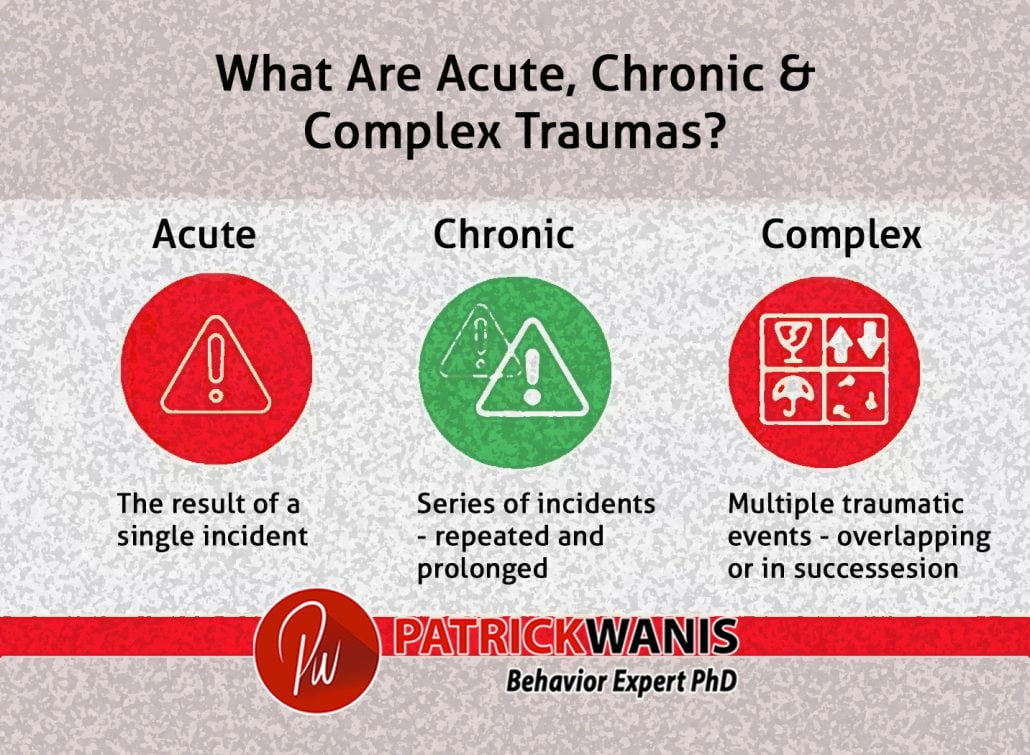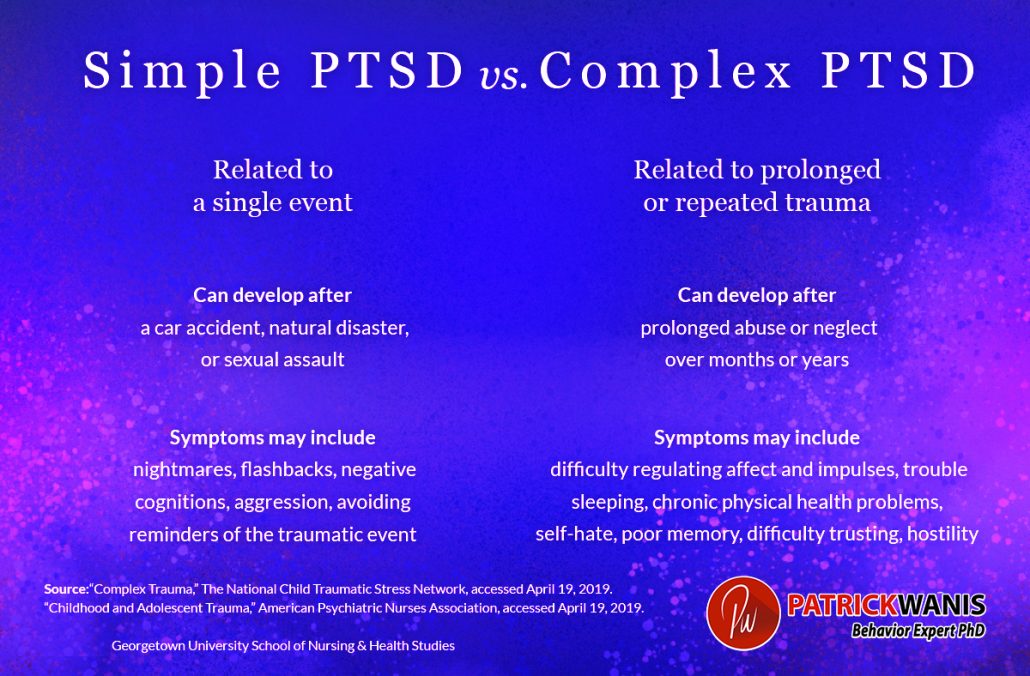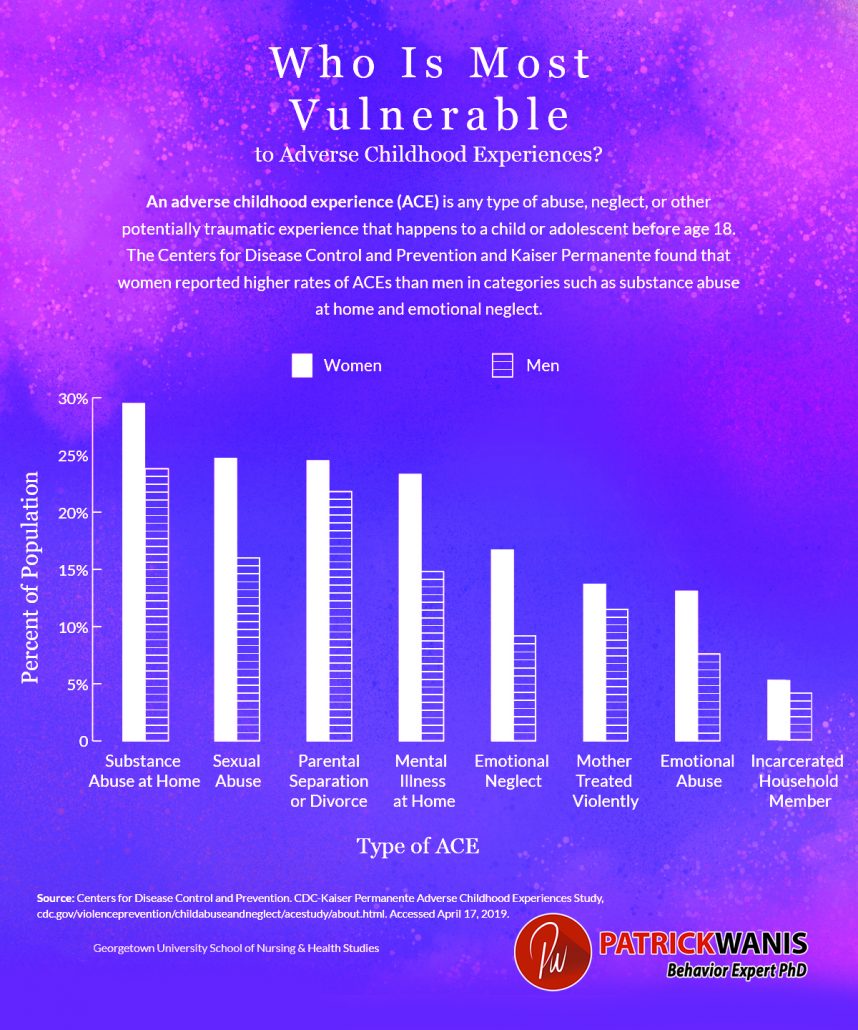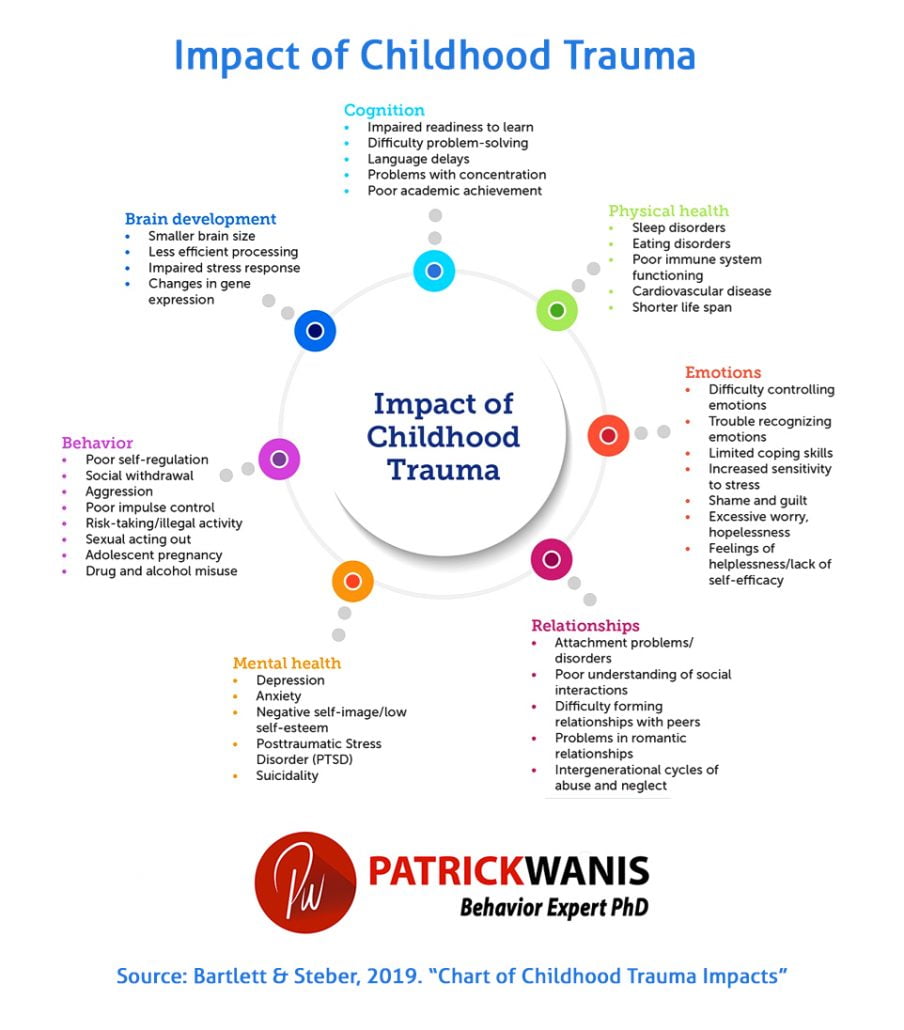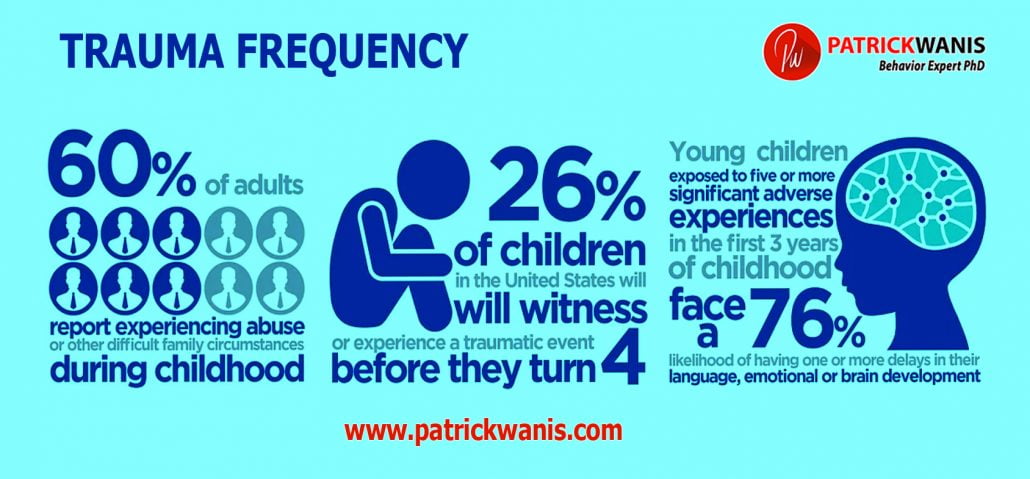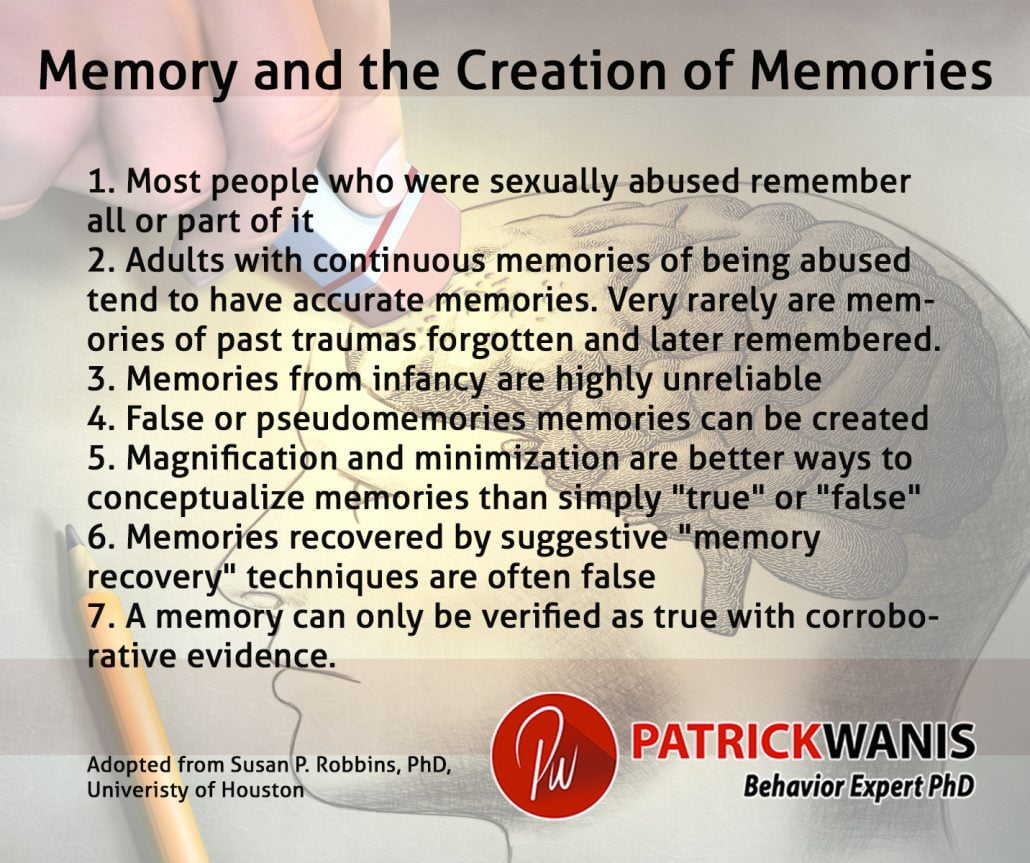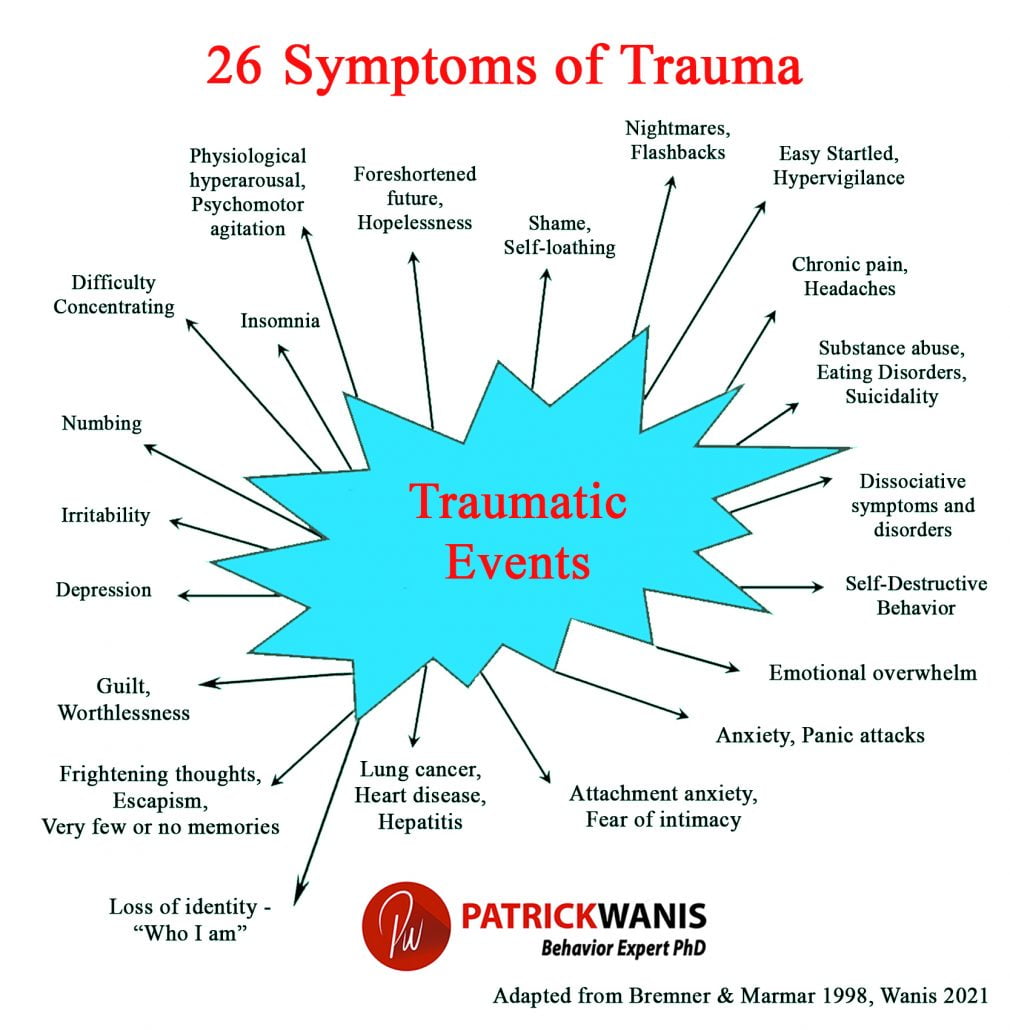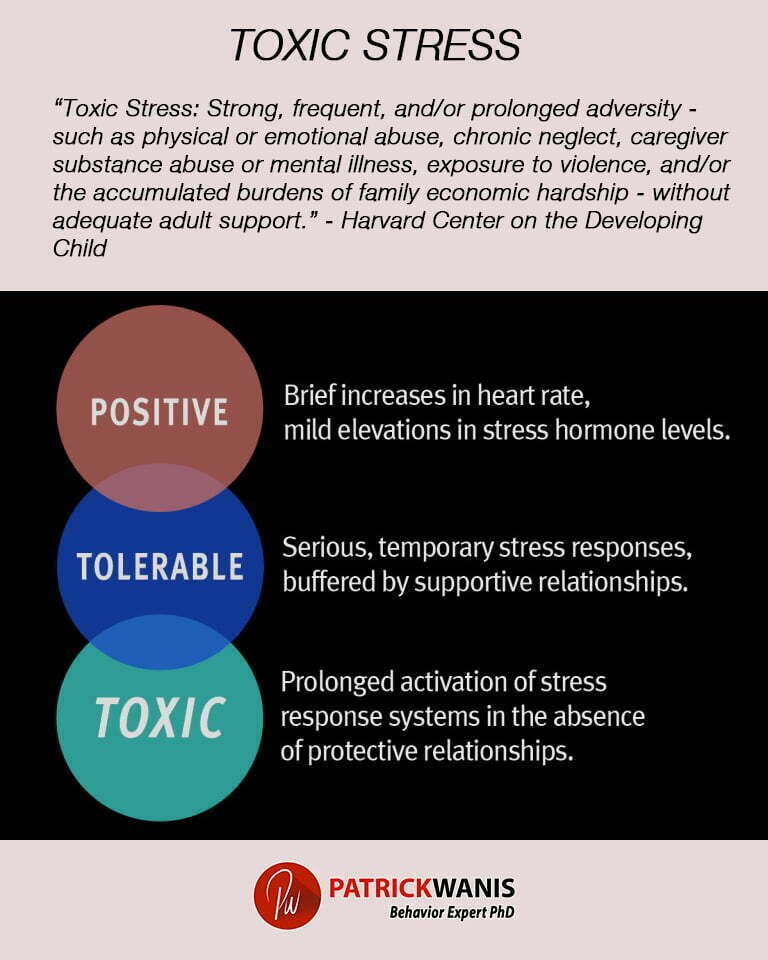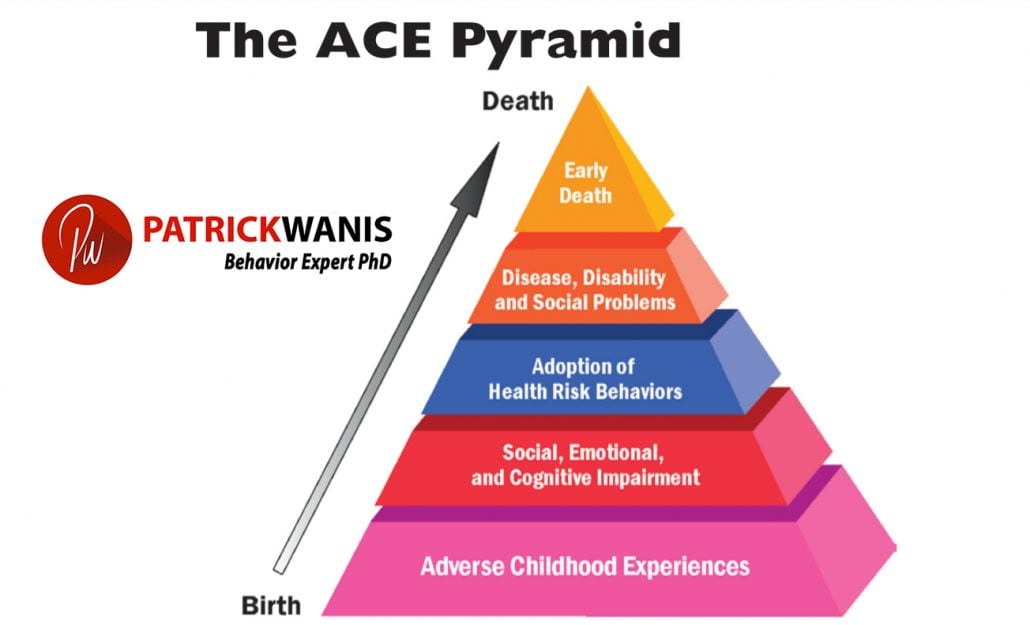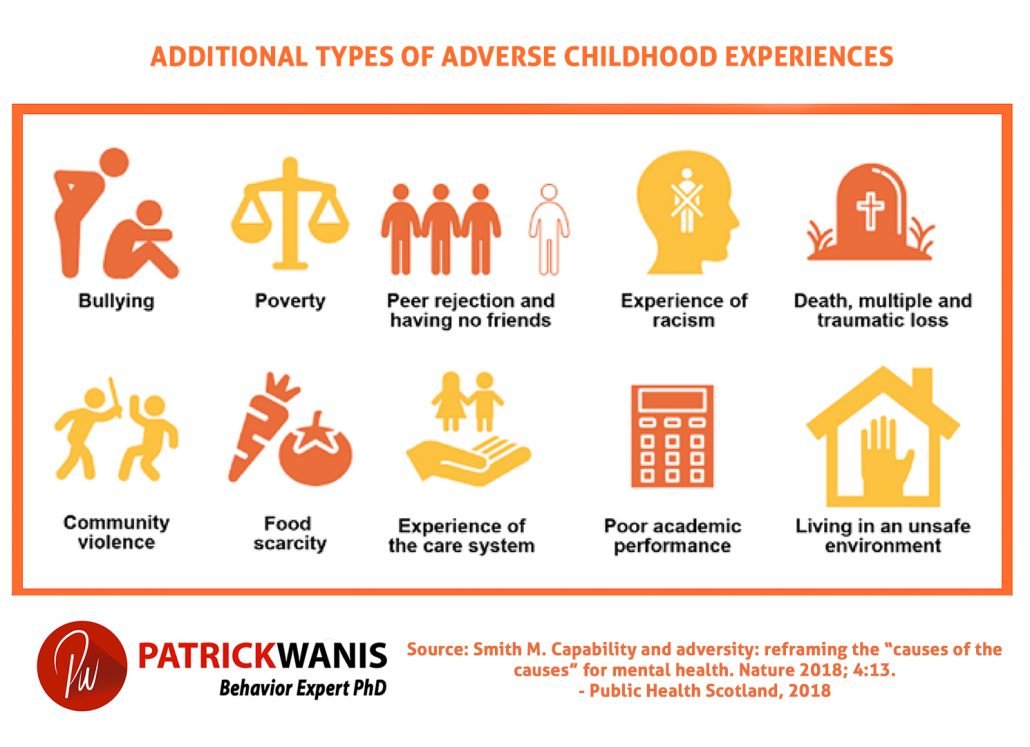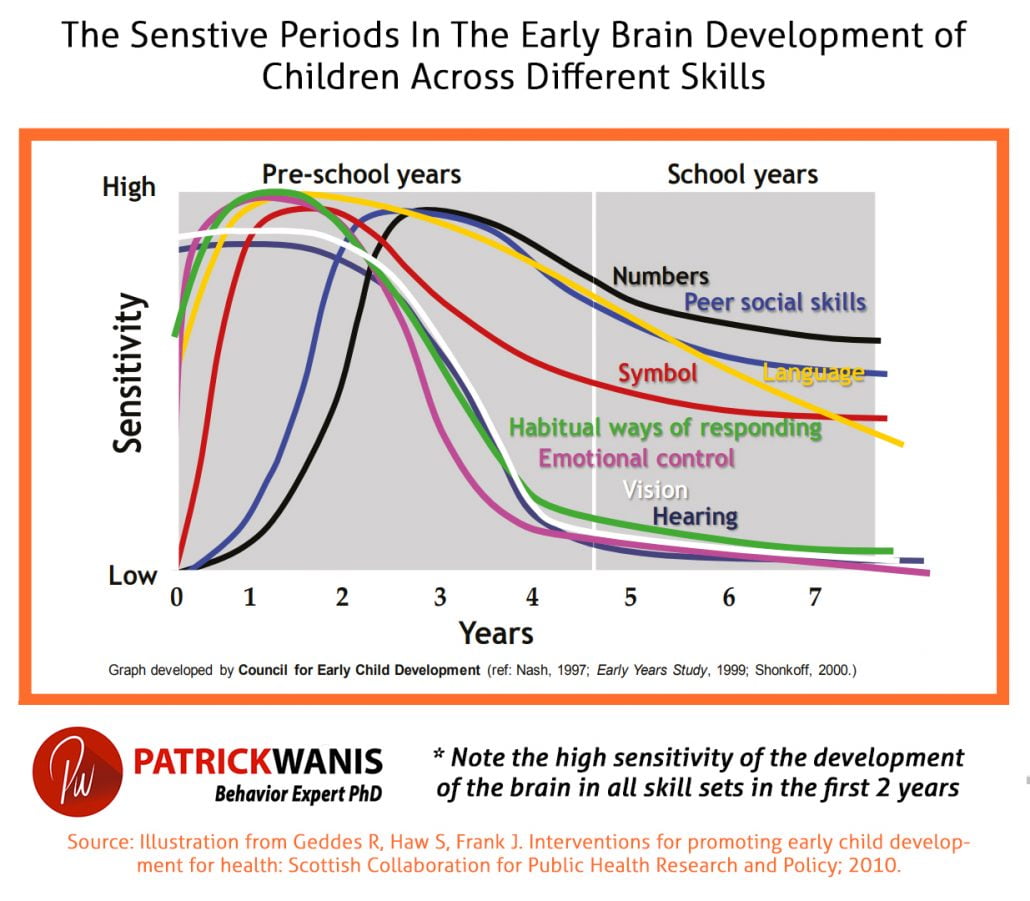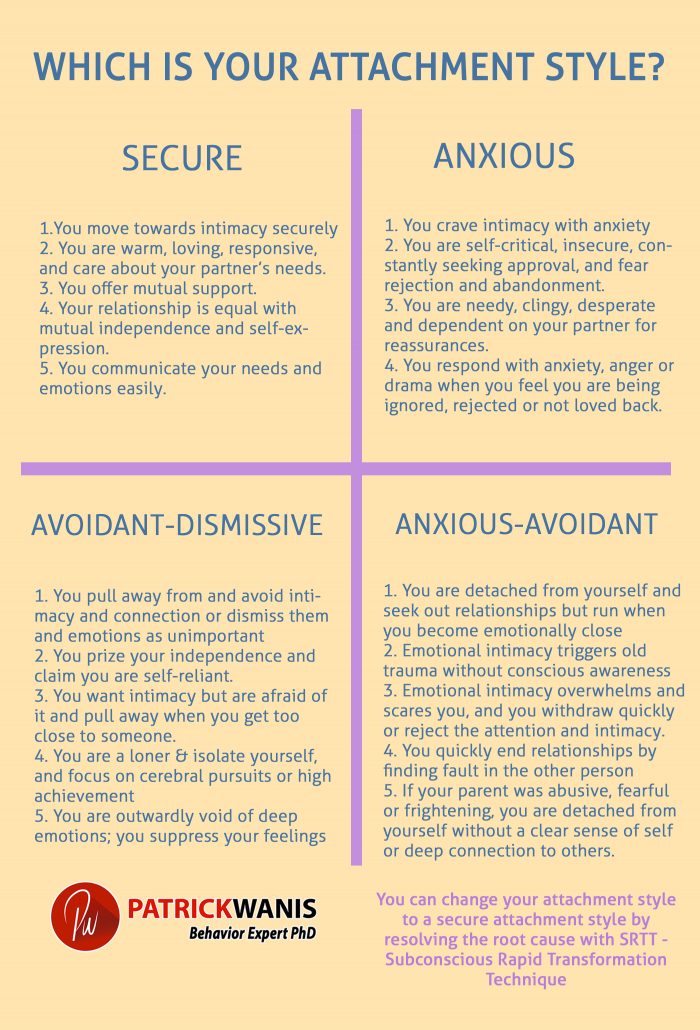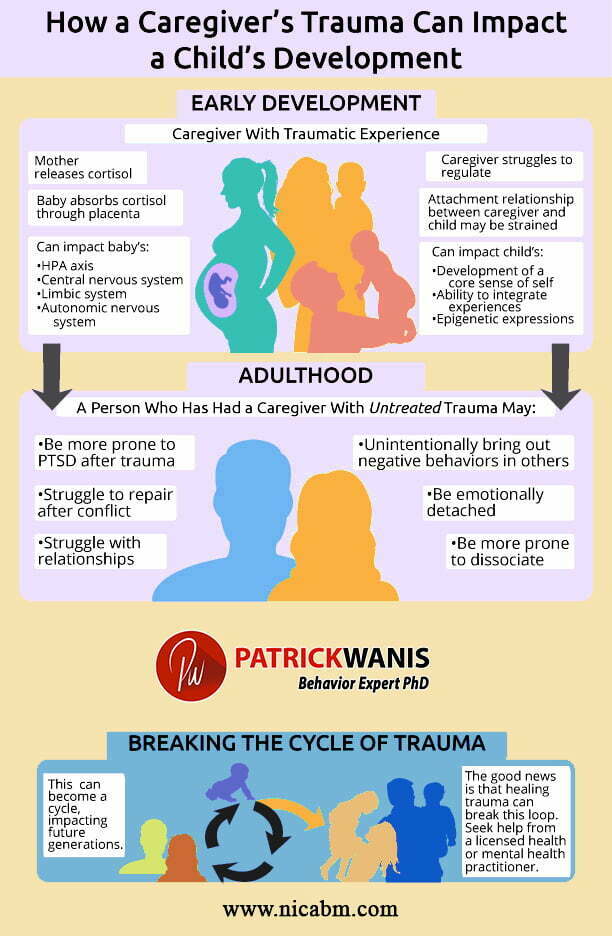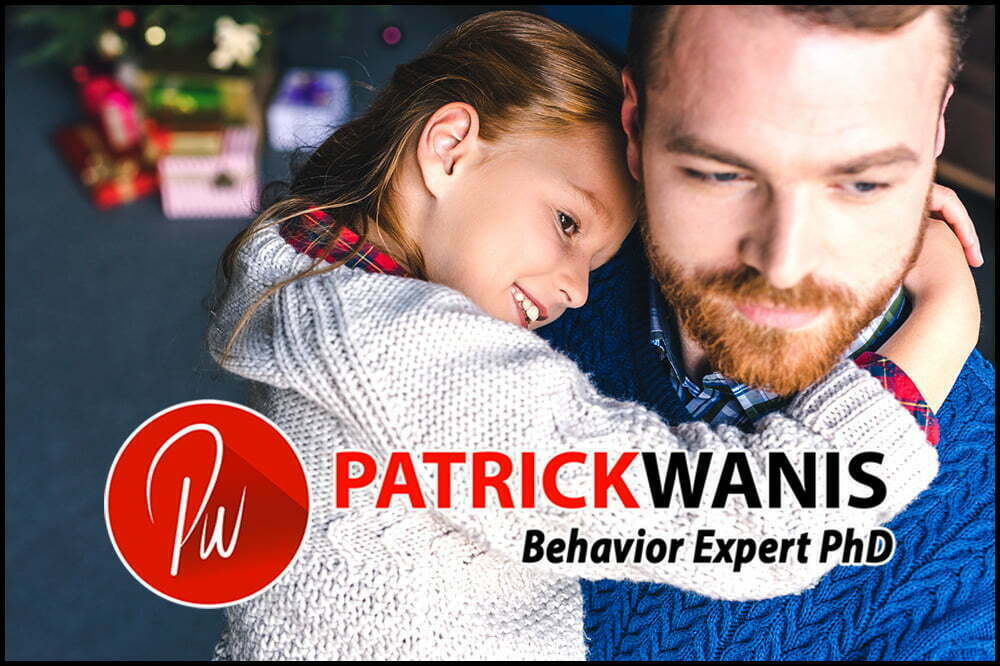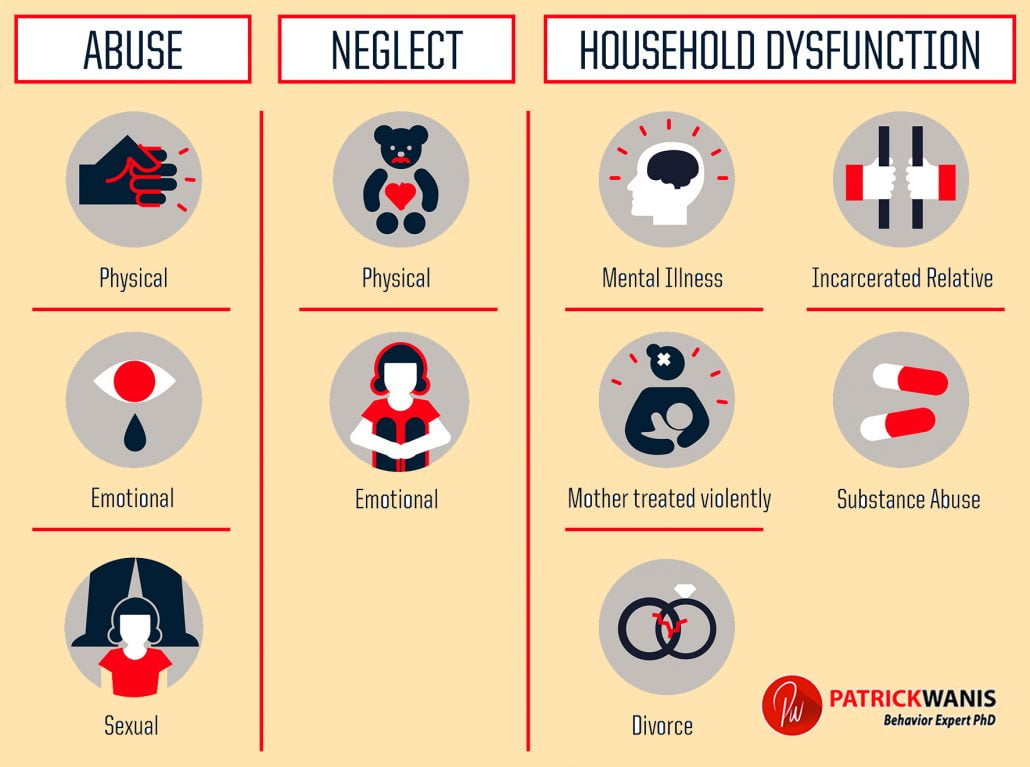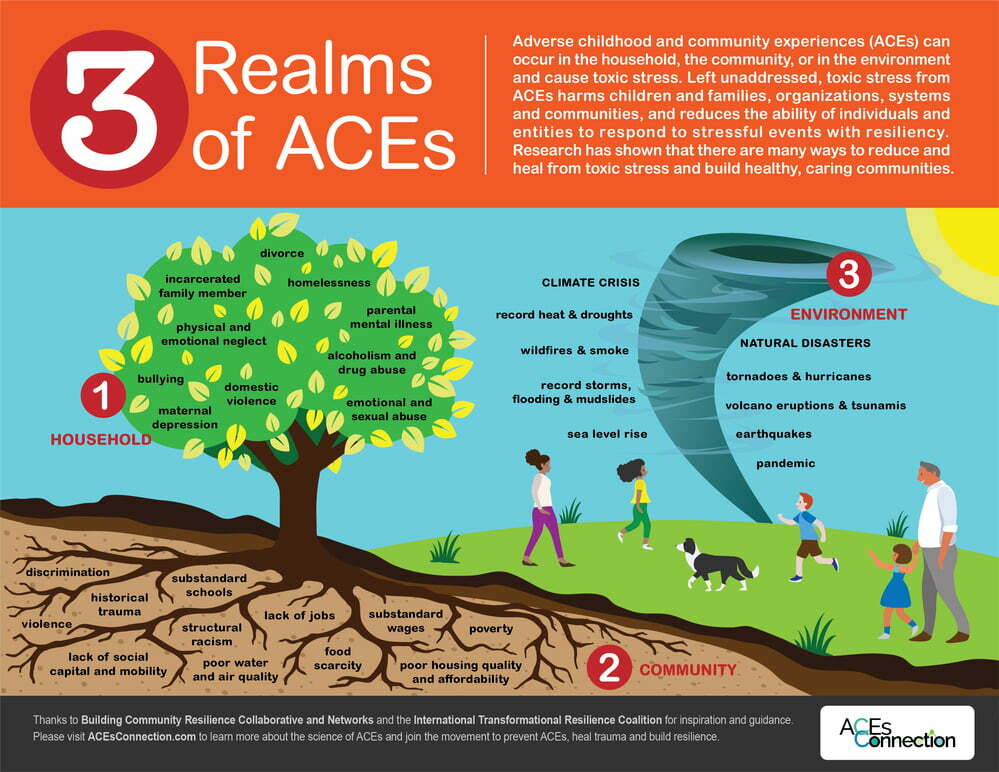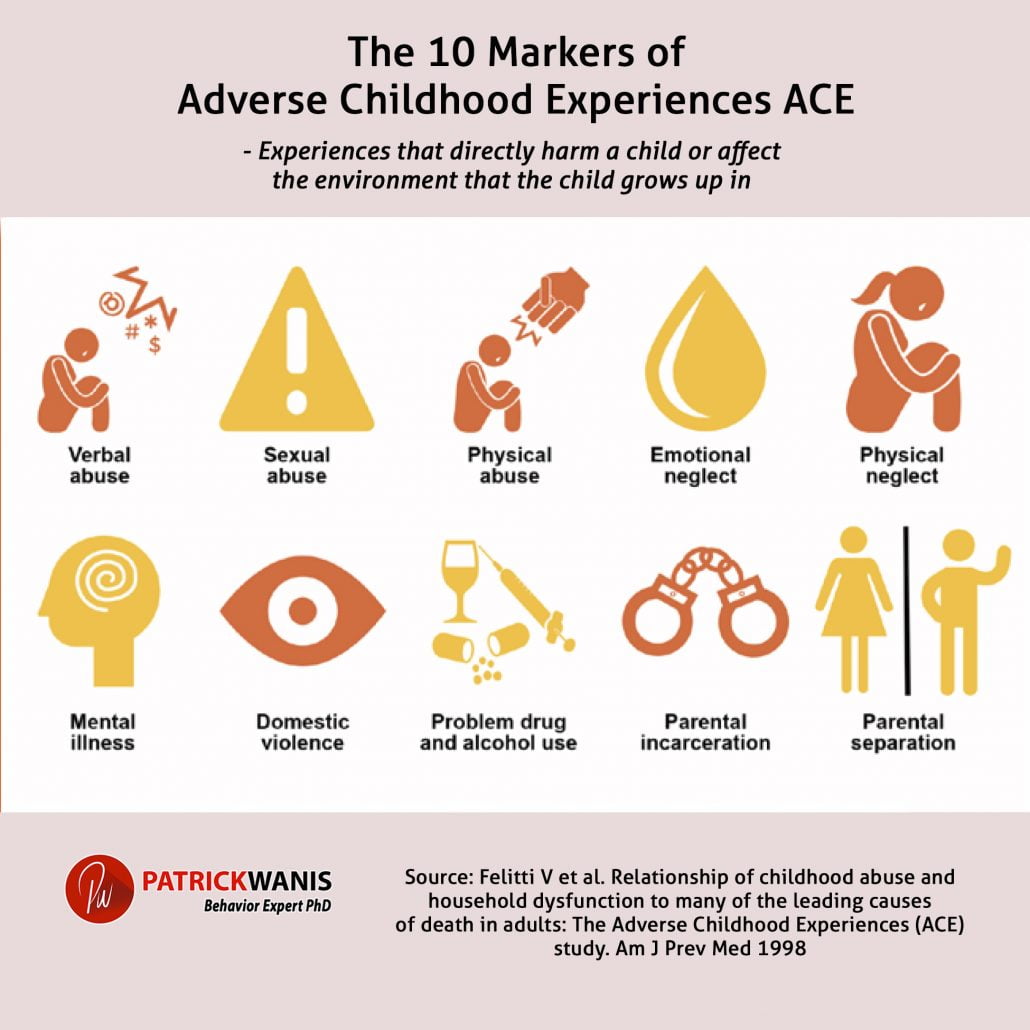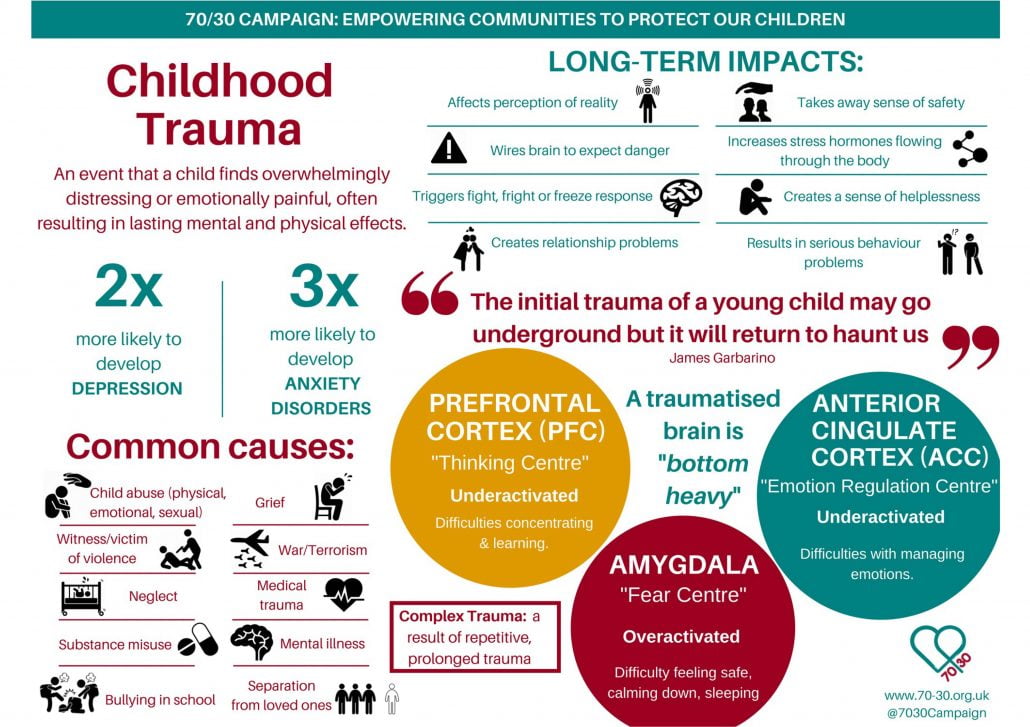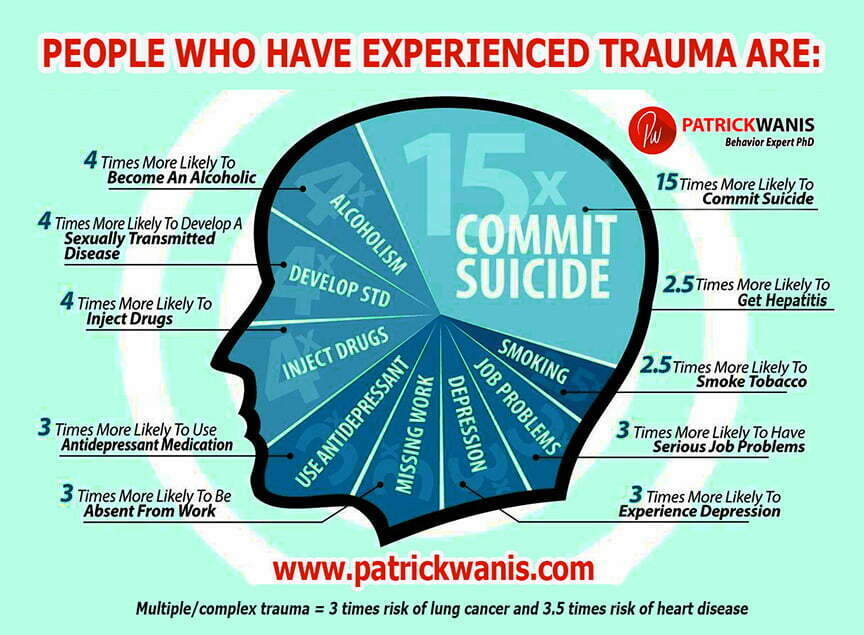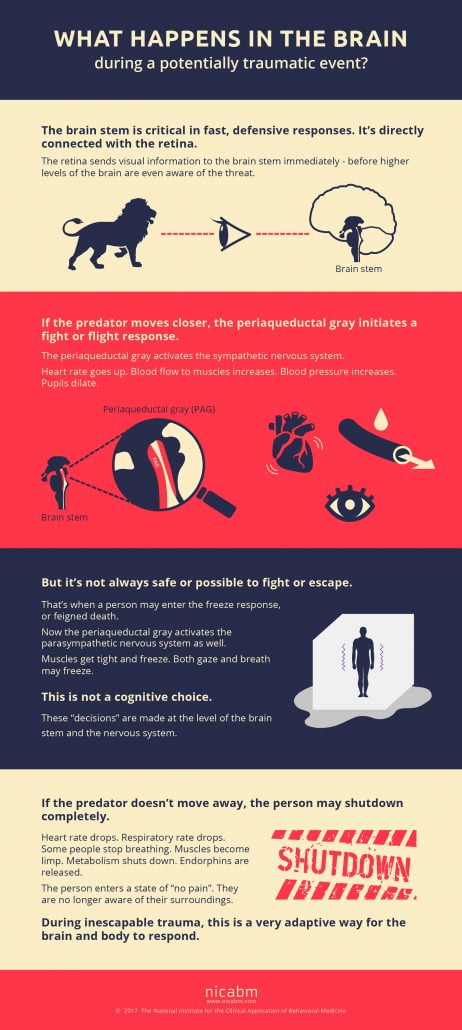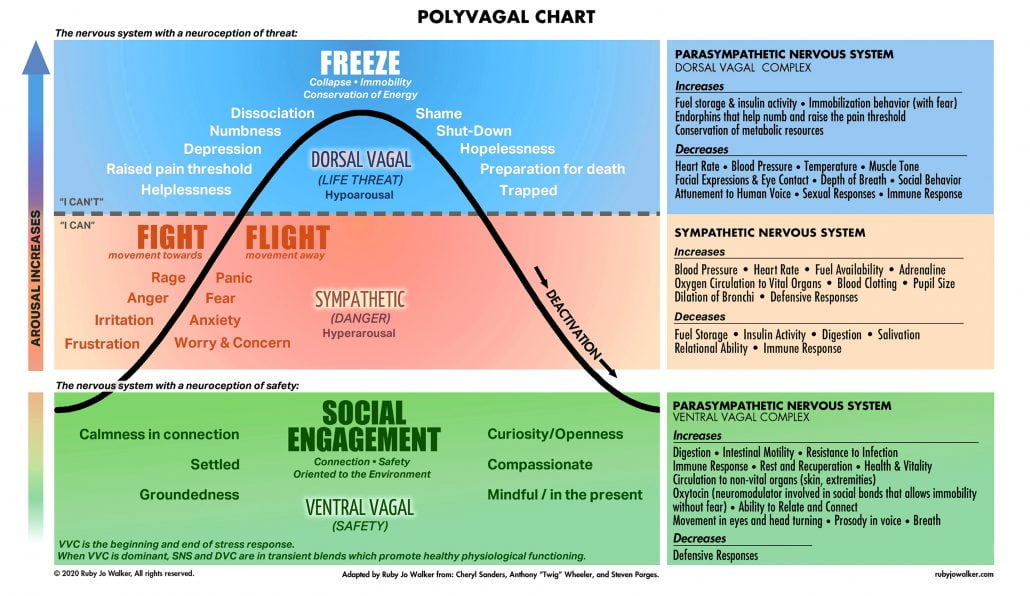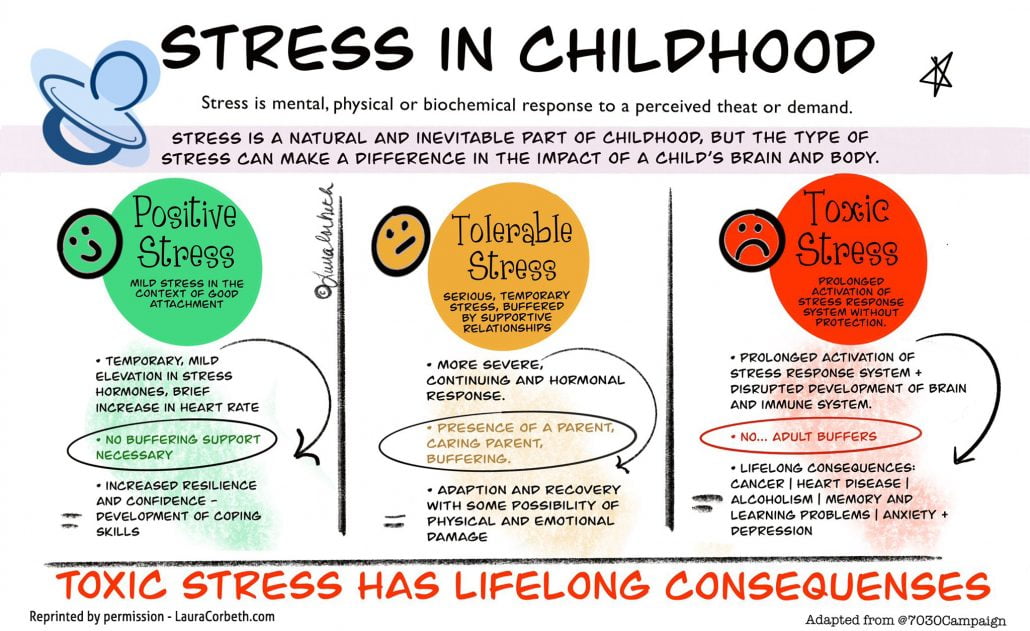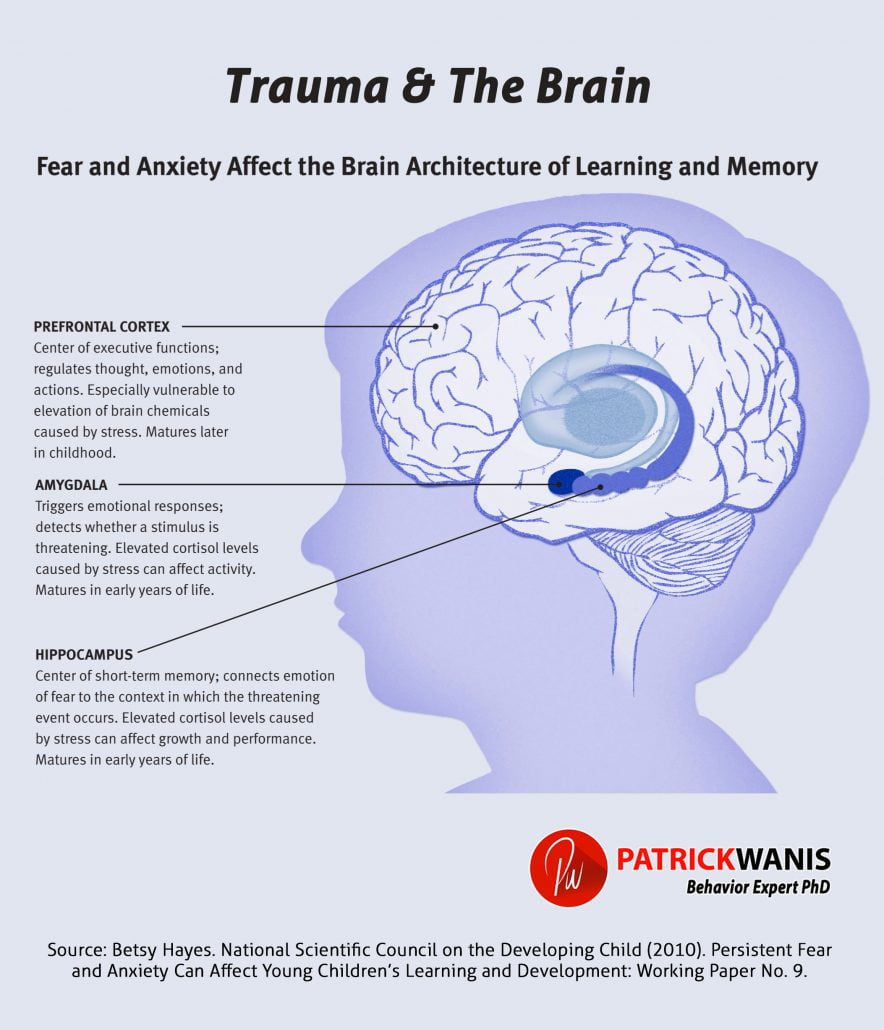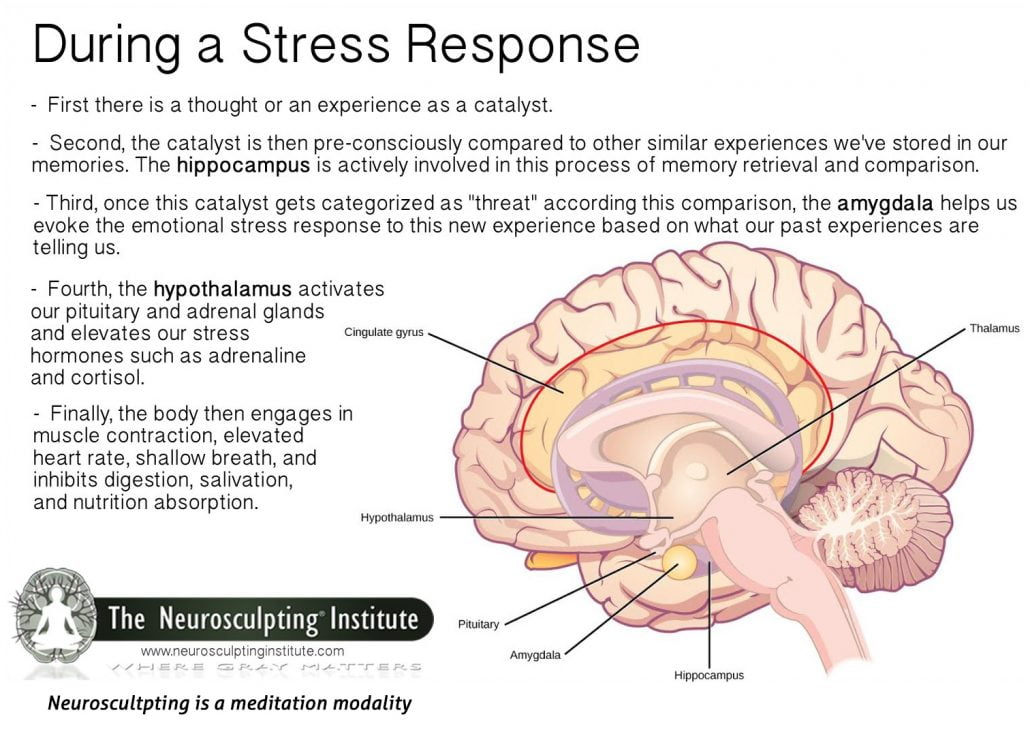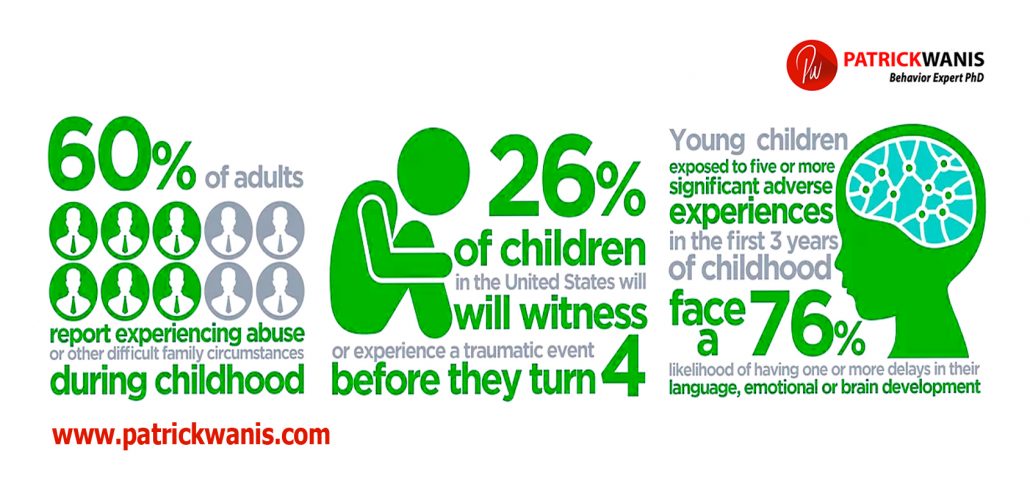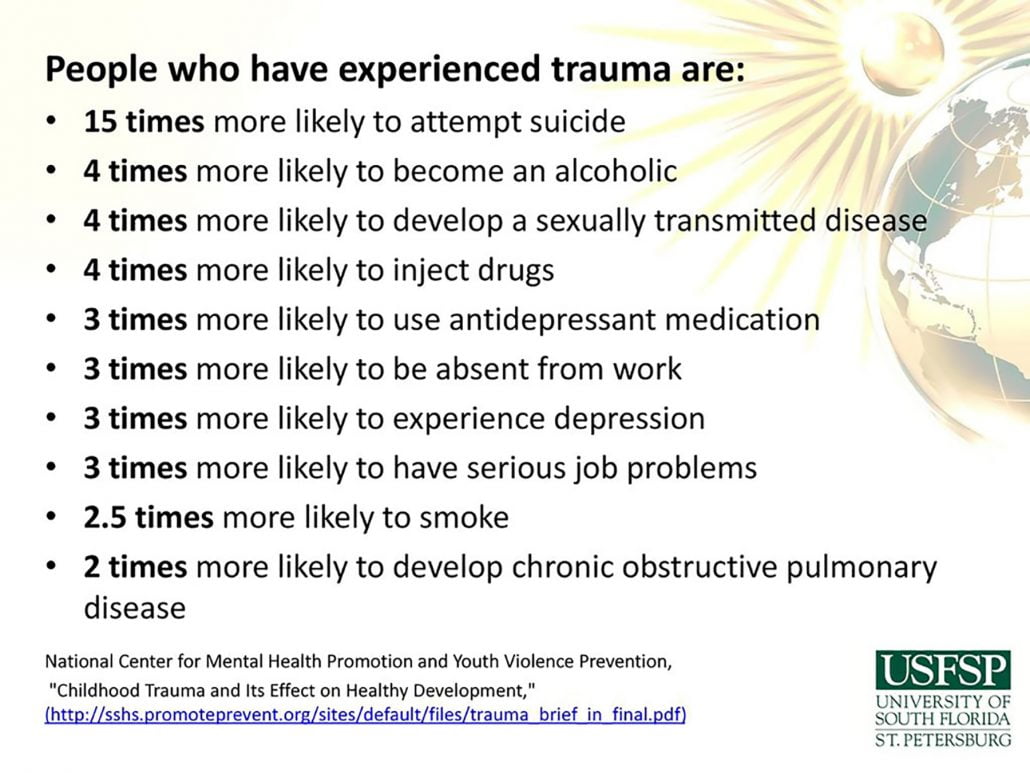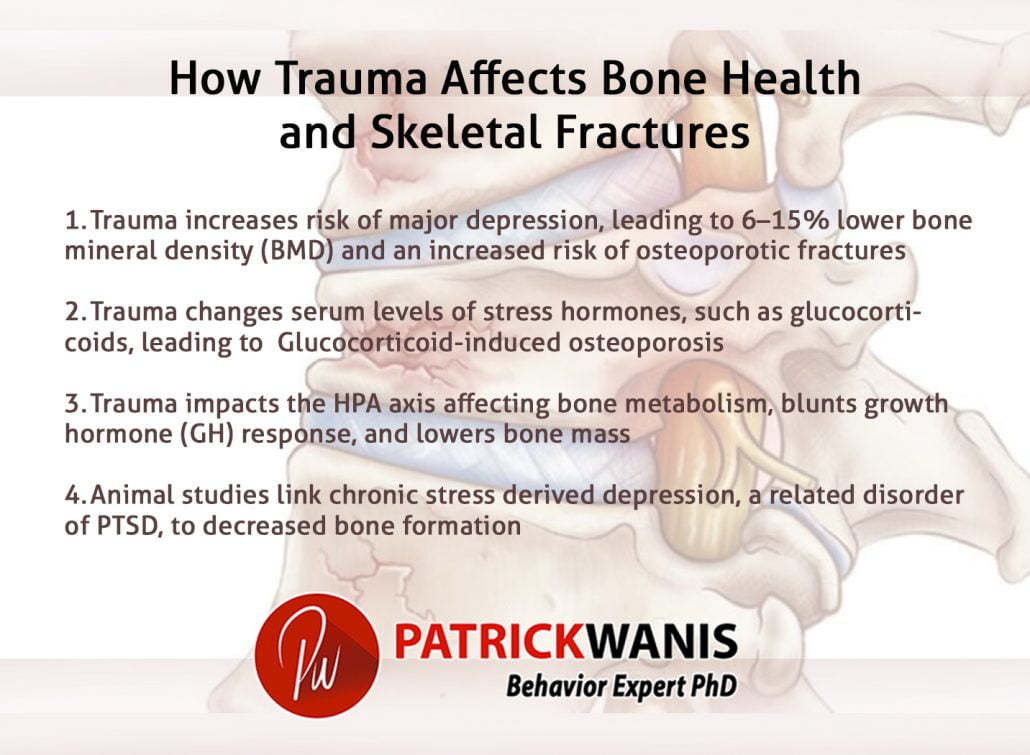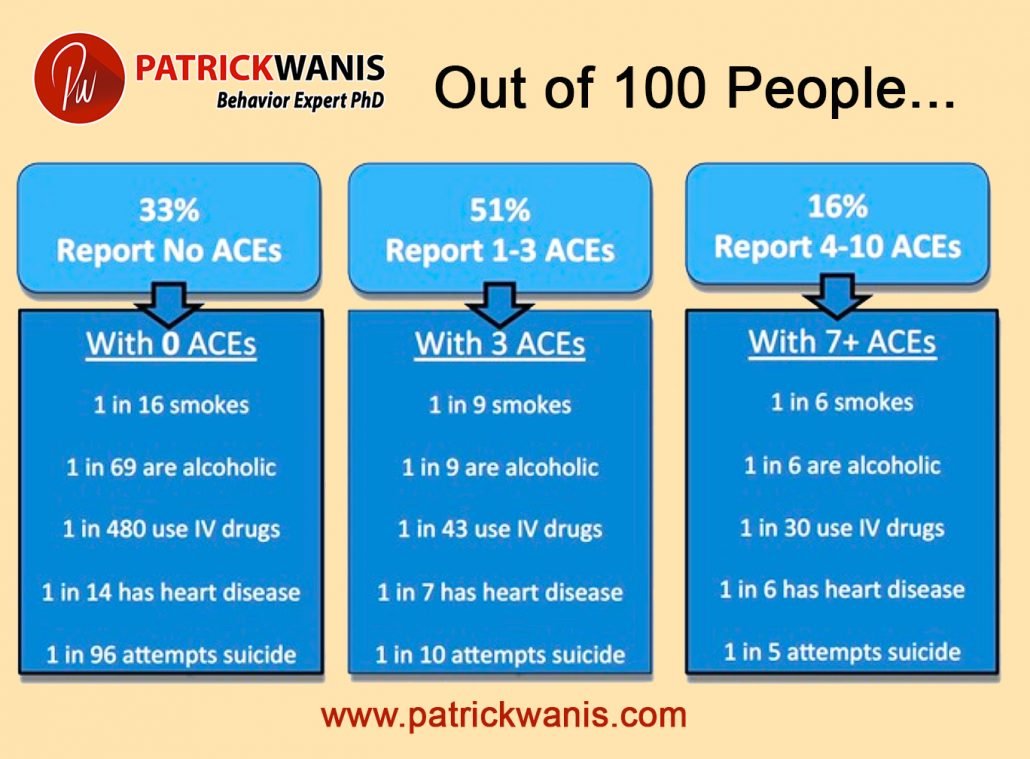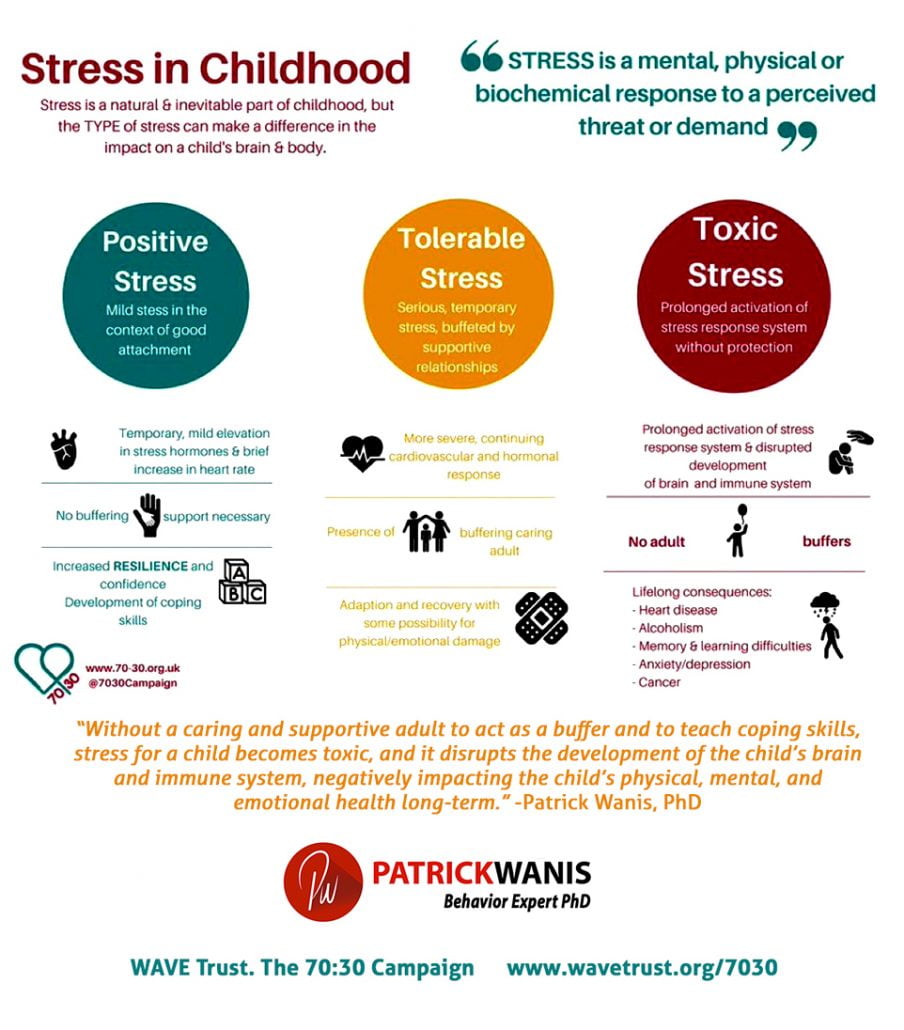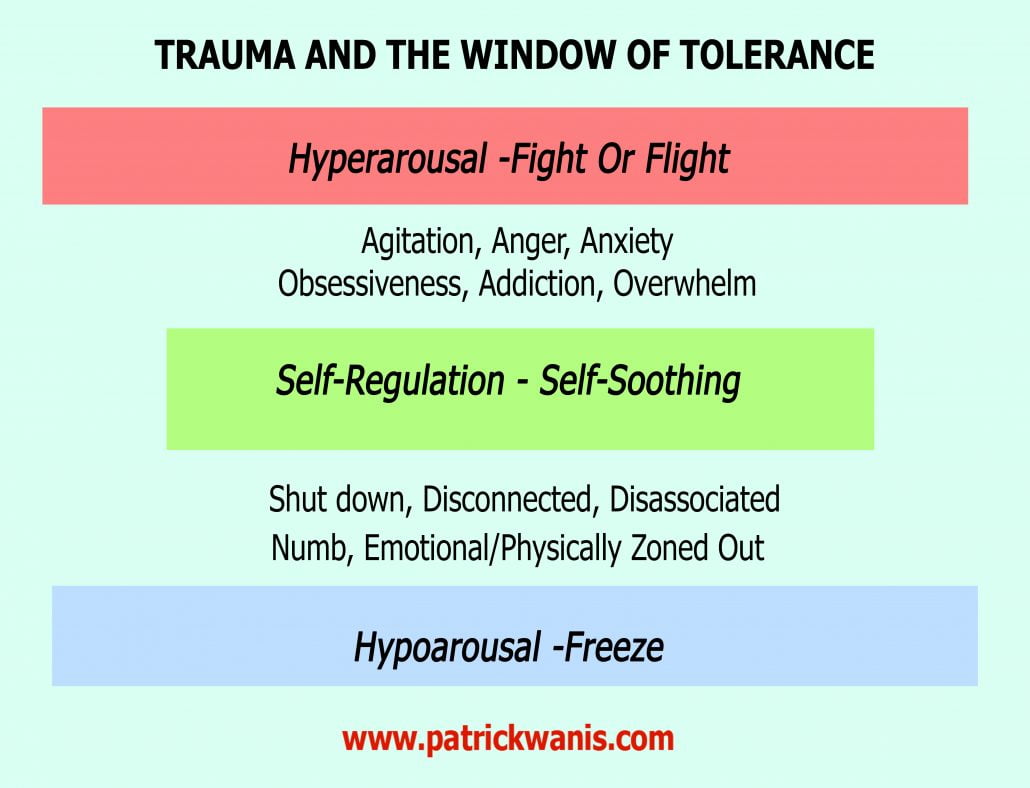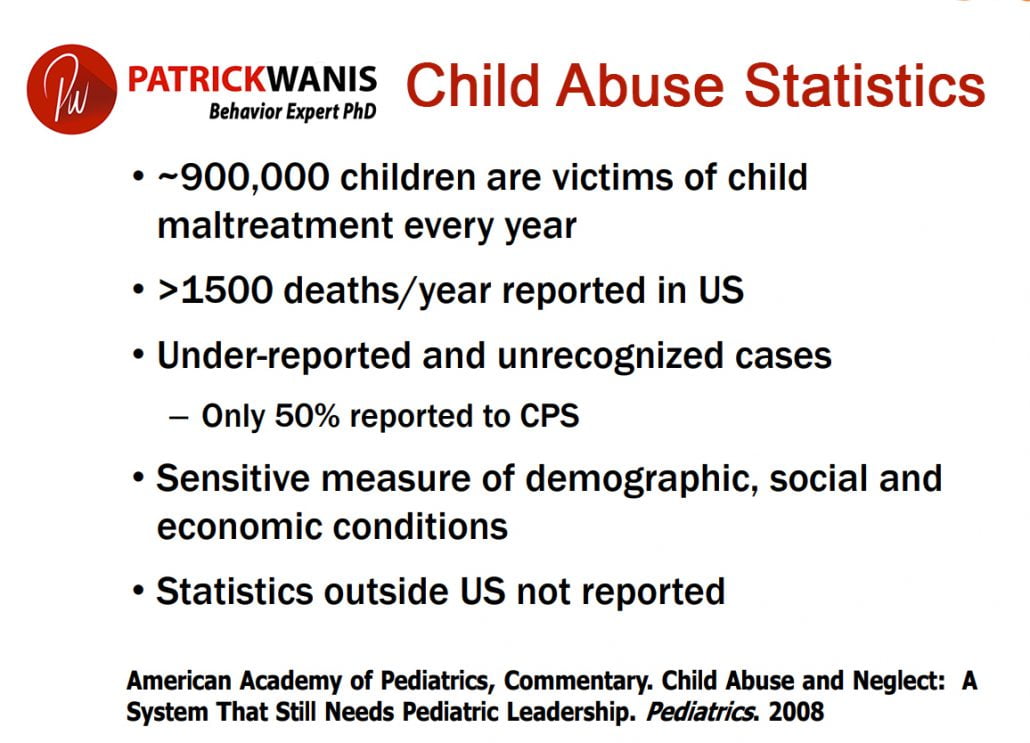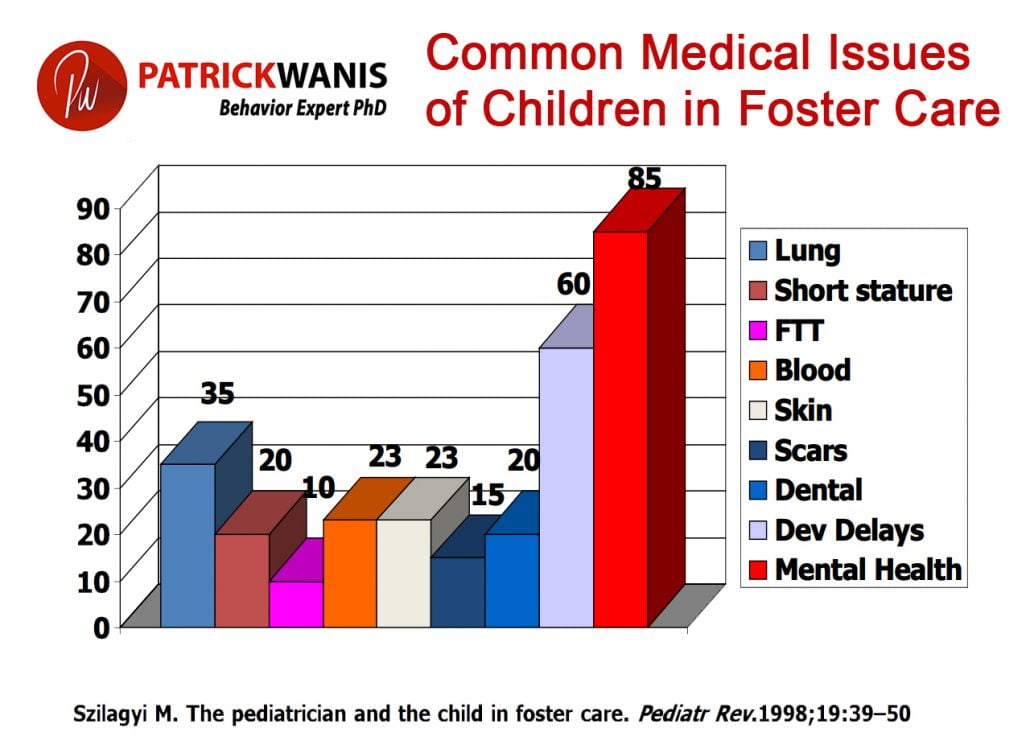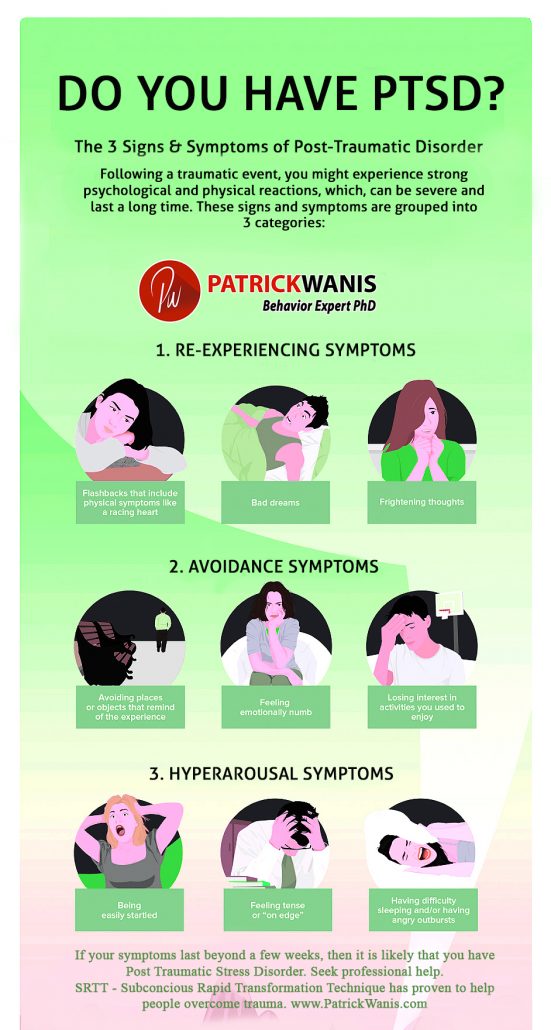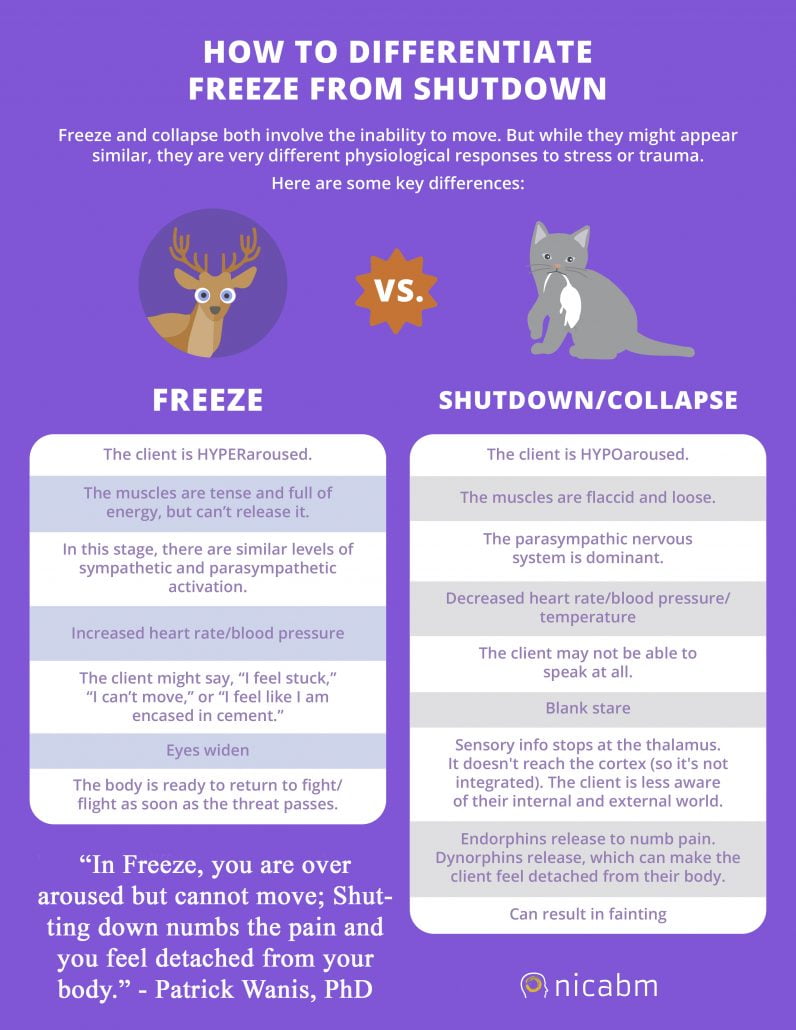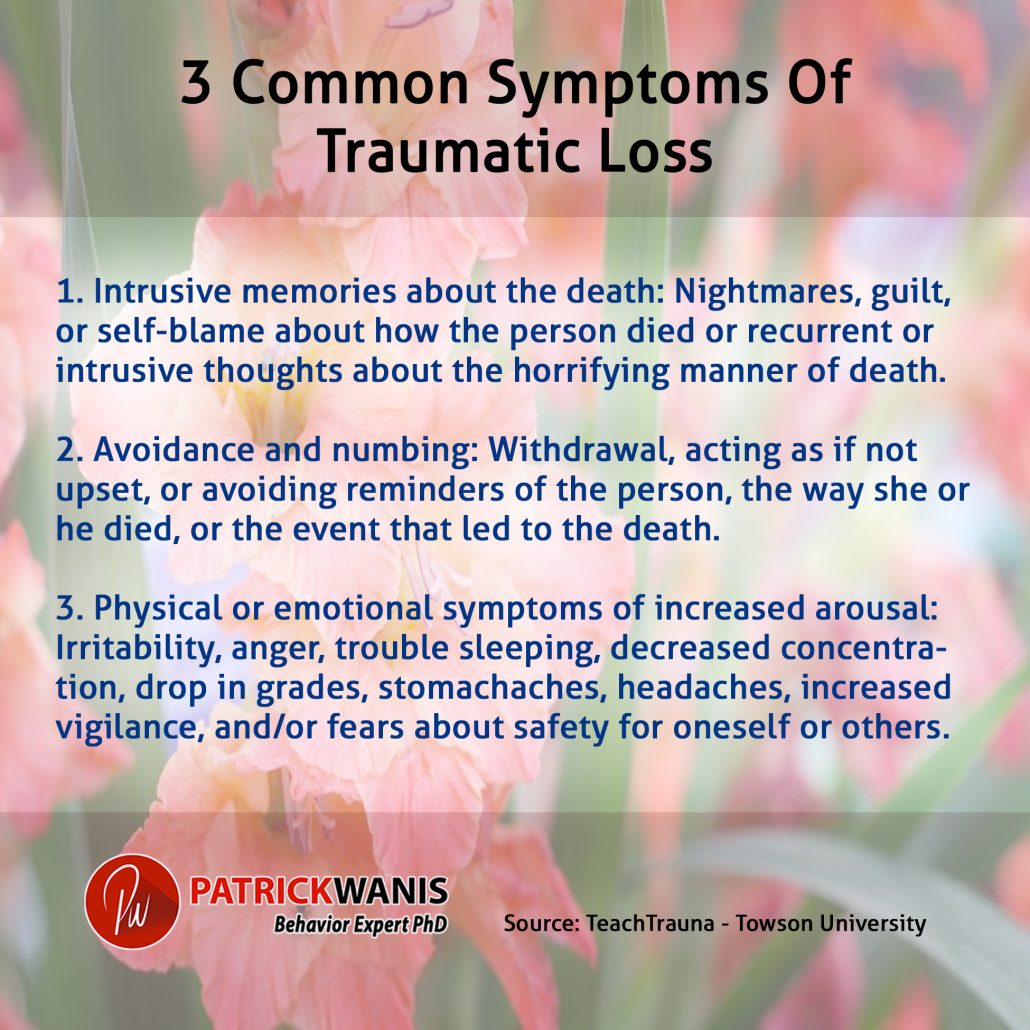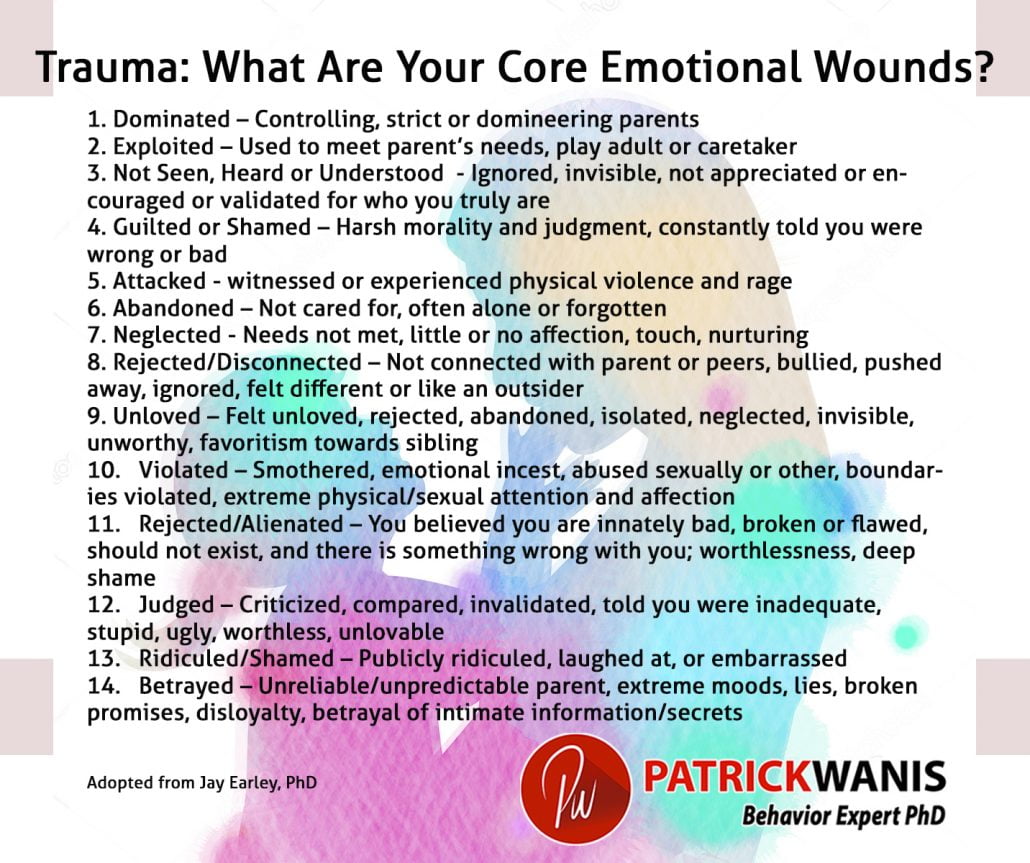Trauma Therapy
Table of Contents
- Trauma Definition
- Trauma Meaning
- 3 Categories/Types of Trauma
- Simple PTSD VS Complex PTSD
- Examples of Trauma
- Women Are More Vulnerable To Trauma And Adverse Childhood Experiences Than Men
- Have You Experienced Trauma?
- Types of Childhood Trauma
- Trauma and ACE – Adverse Childhood Assessment quiz
- Trauma Bonding
- Beware of Trauma and Recovered Memory Therapy, and False Memory Syndrome
- The Truth About Trauma And Memory
- Trauma: Does The Body Lie?
- Consequences of trauma
- 26 Symptoms of Trauma
- Trauma and Physical Pain & Illness – Acute and Chronic Pain
- Trauma and Toxic Stress
- Adverse Childhood Experiences – ACE.
- Trauma and Relationship Attachment Styles
- Maternal Depression, Trauma and Still Face
- Trauma and The Relationship Between Mother and Unborn Baby
- Trauma And Love: Can You Love Yourself If You Have Never Been Loved?
- Trauma – Abuse, Neglect and Household Dysfunction
- Adverse Childhood Experience Assessment
- Bullying And Poverty Are Also Trauma
- Parental Mental Illness and Traumatic Effect On Children
- Trauma of Loss – Adverse Childhood Experiences
- Trauma – Strict Upbringing or Abuse?
- Trauma and Its Negative Impact On Health Outcomes
- Trauma and Polyvagal Theory – Your Nervous System
- Responses To Trauma – Fight, Flight or Freeze
- Link Between Trauma, Obesity and Sexual Abuse
- Link Between Trauma – Emotional Abuse and Obesity, Binge Eating Disorder and Shame
- Trauma Leads To Osteoporosis And Skeletal Fractures
- Antidote to Trauma: Supportive Network and Resiliency
- Re-Victimization: Trauma of Childhood Abuse and Experiencing More Abuse in Adult Relationships
- Trauma and Twisted Love
- Trauma, Self-Compassion and Self-Acceptance
- Trauma Therapy And Forgiveness
- Trauma and Inability To Trust Other People
- Trauma, Shame and Guilt
- Trauma, Self-Blame, and Anger At Self
- Traumatic Loss and Common Symptoms
- Trauma: What Are Your Core Emotional Wounds?
- Trauma Healing – Choosing The Right Therapist and Technique/Process
- Trauma Healing with SRTT – Subconscious Rapid Transformation Technique
Trauma Definition
Trauma is the psychological wound or injury caused by the fear of harm & threats or from the actual harm that occurred to you – physically, mentally, emotionally, sexually.
Another definition of trauma:
Trauma is the unique individual experience of an event or enduring conditions in which the individual’s ability to integrate his/her emotional experience is overwhelmed, and the individual experiences (either objectively or subjectively) a threat to her/her life, bodily integrity, or that of a caregiver or family. (Saakvitne, K, et al, 2000)
Trauma is not limited to the servicemen or women returning from combat!
Trauma happens to almost two-thirds of the population! The degree, frequency and number of traumas determine the impact on your body, mind, and spirit.
Most traumas occur in childhood with long-term negative impacts and consequences throughout life. See diagrams and details below.
When there is a threat, the threatening stimulus overrides everything else and takes priority, turns on the neurochemistry of fear and hijacks the Amygdala and takes over the brain.
“Individual trauma results from an event, series of events, or set of circumstances that is experienced by an individual as physically or emotionally harmful or life threatening and that has lasting adverse effects on the individual’s functioning and mental, physical, social, emotional, or spiritual well-being.” – The Substance Abuse and Mental Health Services Administration (SAMHSA) – U.S. Department of Health and Human Services, 2014
Trauma Meaning
“Trauma occurs when a person perceives an event or set of circumstances as extremely frightening, harmful, or threatening – either emotionally, physically, or both. With trauma, a child’s experience of strong negative emotions (e.g., terror or helplessness) and physiological symptoms (e.g., rapid heartbeat, bedwetting, stomach aches) may develop soon afterward and continue well beyond their initial exposure. Certain types of childhood adversity are especially likely to cause trauma reactions in children, such as the sudden loss of a family member, a natural disaster, a serious car accident, or a school shooting. Other childhood adversities (e.g., parental separation or divorce) tend to be associated with more variability in children’s reactions and may or may not be experienced by a child as trauma. Childhood trauma is associated with problems across multiple domains of development.”
⦁ Jessica Dym Bartlett, Vanessa Sacks, “Adverse childhood experiences are different than child trauma, and it’s critical to understand why” 2019
https://www.childtrends.org/blog/adverse-childhood-experiences-different-than-child-trauma-critical-to-understand-why
3 Categories/Types of Trauma
Trauma is divided into three main types: acute, chronic, and complex.
Acute Trauma is a single but severe event
Chronic Trauma is a series of events, recurring and sometimes frequent; multiple, long-term or prolonged events also over an extended period of time.
Complex Trauma is varied and multiple traumatic events or experiences; some might overlap while others might be in succession.
Simple PTSD VS Complex PTSD
Posttraumatic Stress Disorder, PTSD, is an anxiety disorder resulting from a traumatic event and includes 3 key symptoms: re-experiencing the trauma, avoidance and numbing, and hyperarousal.
Examples of Trauma
Later, I discuss ACE – Adverse Childhood Experiences which often translate into trauma and sometimes into PTSD – Posttraumatic Stress Disorder.
Here are 17 examples of events that are processed as trauma:
⦁ Sexual Abuse or Assault
⦁ Sex Trafficking
⦁ Physical Abuse or Assault
⦁ Dating Violence or Assault
⦁ Emotional Abuse/Psychological Maltreatment
⦁ Neglect, including physical neglect, medical neglect, or educational neglect.
⦁ Serious Accident or Illness or life-threatening disease such as cancer
⦁ Medical Procedure which is extremely painful and/or life-threatening
⦁ Witness to Domestic Violence such as emotional abuse, physical or sexual assault, or aggressive control by one parent towards another
⦁ Victim/Witness to Community Violence such as crime and gang-related violence, shooting, mugging, burglary, assault, bullying
⦁ School Violence such as school shootings, bullying, interpersonal violence among classmates, and classmate suicide.
⦁ Natural or Manmade Disasters – hurricanes, floods, earthquakes
⦁ Forced Displacement such as political asylees or immigrants fleeing political persecution
⦁ War/Terrorism/Political Violence such as exposure to bombing, shooting, looting, riots, or accidents
⦁ Victim/Witness to Extreme Personal/Interpersonal Violence such as homicide or suicide
⦁ Traumatic Grief/Separation such as death of a parent, homicide, separation of parents, divorce
⦁ System-Induced Trauma such as foster home placement or separation of siblings
Source: Adapted from Georgetown University Center for Child and Human Development (GUCCHD)
Women Are More Vulnerable To Trauma And Adverse Childhood Experiences Than Men
The CDC-Kaiser Permanente Adverse Childhood Experiences (ACE) Study is one of the largest investigations of the link between childhood abuse, neglect and household dysfunction and later-life health and psychological well-being. Data from the ACE study reveals that women are more likely to experience the types of events that lead to complex trauma and complex PTSD beginning in childhood.
From the ACE study, women report higher rates than men of neglect, abuse, and adverse household circumstances experienced as children. Women are more likely to be emotionally abused (13.1%, compared to 7.6% for men), sexually abused (24.7%, compared to 16% for men), emotionally neglected (16.7%, compared to 9.2% for men), and to have a mental illness in the home (23.3% women, compared to 14.8% for men.) See the diagram below “Who Is Most Vulnerable to Adverse Childhood Experiences?”
Have You Experienced Trauma?
You may have experienced trauma and you never even realized that it was actual trauma. You may have said, as I first did, ‘Oh. I just thought my dad was strict and I had a strict upbringing.’ Years later, as my symptoms took over, I realized that being beaten multiple times with a thick leather strap for throwing a tennis ball into the neighbor’s yard, by accident while playing a game, is physical abuse. As you read further below, I outline various examples of childhood trauma as well as adult trauma. The most accurate way to determine if you experienced trauma, is via your symptoms: Your symptoms alone will reveal if you experienced trauma!
“Trauma survivors have symptoms instead of memories”
⦁ Harvey, M. (1990). An ecological view of psychological trauma and recovery. Journal of Traumatic Stress, 9(1)
Types of Childhood Trauma
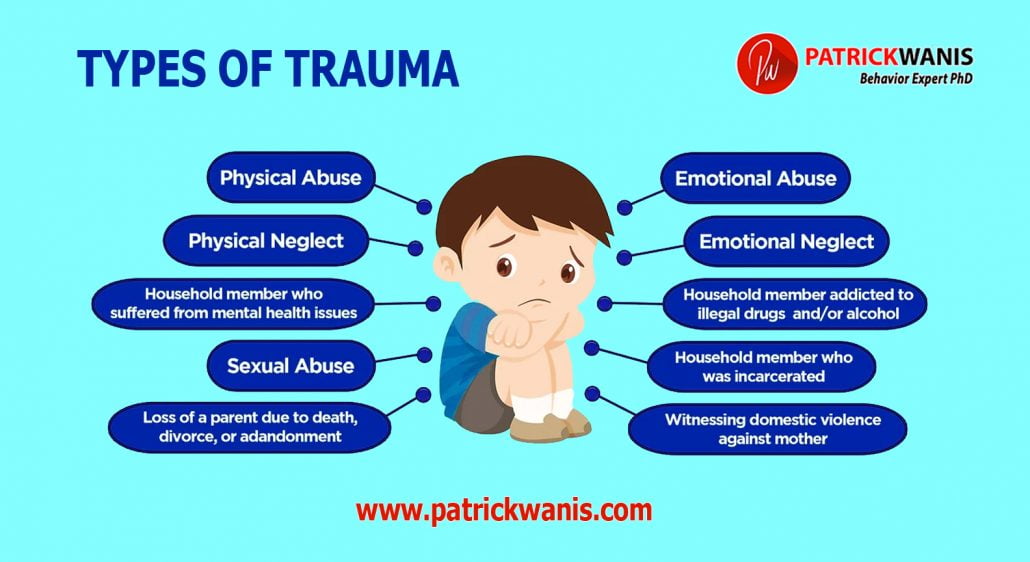
Further below, you will see in the diagram that there are 3 categories of sources of trauma – traumas experienced in the household (family), traumas from the environment (natural disasters, pandemics), and traumas from the community (violence, poverty, lack of jobs.)
Trauma and ACE – Adverse Childhood Assessment quiz
Prior to your 18th birthday:
1. Did a parent or other adult in the household often or very often:
a) Swear at you, insult you, put you down, or humiliate you? or b) Act in a way that made you afraid that you might be physically hurt?
No___ If Yes, enter 1 __
2. Did a parent or other adult in the household often or very often:
a) Push, grab, slap, or throw something at you? or b) Ever hit you so hard that you had marks or were injured?
No___ If Yes, enter 1 __
3. Did an adult, or a person at least 5 years older than you ever:
a) Touch or fondle you or have you touch their body in a sexual way? or b) Attempt or actually have oral, anal, or vaginal intercourse with you?
No___ If Yes, enter 1 __
4. Did you often or very often feel that:
a) No one in your family loved you or thought you were important or special? or b) Your family didn’t look out for each other, feel close to each other, or support each other?
No___ If Yes, enter 1 __
5. Did you often or very often feel that:
a) You didn’t have enough to eat, had to wear dirty clothes, and had no one to protect you? or b) Your parents were too drunk or high to take care of you or take you to the doctor if you needed it?
No___ If Yes, enter 1 __
6. Were your parents ever separated or divorced?
No___ If Yes, enter 1 __
7. Was your mother or stepmother:
a) Often or very often pushed, grabbed, slapped or had something thrown at her? or b) Sometimes, often, or very often kicked, bitten, hit with a fist, or hit with something hard? or c) Ever repeatedly hit over at least a few minutes or threatened with a gun or knife?
No___ If Yes, enter 1 __
8. Did you live with anyone who was a problem drinker or alcoholic, or who used street drugs?
No___ If Yes, enter 1 __
9. Was a household member depressed or mentally ill, or did a household member attempt suicide?
No___ If Yes, enter 1 __
10. Did a household member go to prison?
No___ If Yes, enter 1 __
Add up your “Yes” answers for your ACE Score:
Each one of these adverse experiences has the potential to become a trauma or severe trauma – depending on your own disposition and temperamental attributes, the relationships and support system from adults and other caretakers within your household, and the support you received from the community – such as teachers. Read further below to understand the significance and impact of each of these adverse childhood experiences.
Trauma Bonding
Why Is It Called Stockholm Syndrome?
“In August 1973, four employees of Sveriges Kreditbank [in Stockholm, Sweden] were held hostage in the bank’s vault for six days. During the standoff, a seemingly incongruous bond developed between captive and captor. One hostage, during a telephone call with Swedish Prime Minister Olof Palme, stated that she fully trusted her captors but feared that she would die in a police assault on the building.”
https://www.britannica.com/science/Stockholm-syndrome
Trauma bonding or the Stockholm Syndrome explains the dynamic that keeps men and women emotionally captive in abusive relationships: Fear, abuse, dependency, and even torture create the emotional bond between the abused and the abuser.
https://www.patrickwanis.com/abusive-relationships-the-stockholm-syndrome-frank-ochberg-video-audio/
There is a psychological process and phenomenon that leads abused victims (including battered wives) to become sympathetic, side with or fall in love with the abuser and/or become psychologically and physically dependent on the abuser for survival in all forms. This is referred to as Stockholm Syndrome. The physiological arousal created by the fear and abuse creates a deep emotional bond between the victim and the abuser.
https://www.patrickwanis.com/the-psychology-behind-the-house-of-horrors-and-child-torture/
Trauma Bonding is a survival strategy.
Conditions associated with trauma bonding:
⦁ Domination: Power imbalance – the abuser has power over the victim
⦁ Dependency: Victim is helpless – dependent upon abuser for survival (sometimes real dependency, other times perceived dependency based on threats and loss of sense of self; victim sees herself thru the eyes and image created by the abuser)
⦁ Terror and fear: Real danger and threats of danger – terror and fear
⦁ Unpredictability: Abuse/punishment and occasional kindnesses and rewards – unpredictability generates more fear, terror, and dependency on the abuser
⦁ Isolation: To maintain secrecy
⦁ Isolation: To brainwash the victim, maintain control and domination over the victim, and to hide the victim from other people’s perspectives and revelations that the victim is actually experiencing abuse
⦁ Hopelessness: Driven by a belief that there is no escape or way out
⦁ Confusion and Conflicting Emotions: Alarm (hypervigilance), numbness (disassociation), grief (sadness, sorrow, helplessness)
Traumatic bonding: “A strong emotional attachment between an abused person and his or her abuser, formed as a result of the cycle of violence.” – Wendy Austin; Mary Ann Boyd. Psychiatric and Mental Health Nursing for Canadian Practice.
Settings and contexts for Trauma Bonding
Trauma bonding can occur in various relationships and contexts such as romantic relationships, parent-child relationships, incestuous relationships, relationships of authoritarian figures over dependent children/adults, cults, hostage situations, sex trafficking (particularly minors), prisoners of war, or tours of duty among military personnel (i.e., in the Korean war, soldiers would turn to “comfort women” (sex slaves) and would be both aggressive, violent & abusive as well as kind and generous towards those women (food, outings and physical protection) thus developing trauma bonding from the abused women to the soldiers.
Due to the dependency and emotional bond that forms from the abused to the abuser, victims struggle to break free from the relationship, they can develop negative responses and feelings towards potential rescuers, they can become supportive of the abuser’s various behaviors, and above all, victims of abuse often return to the abusive relationship because of the deep trauma bonding.
The instinct for survival and the role of the brain in Trauma Bonding
“The survival brain (or amygdala) is concerned with immediate survival, not long-term psychological impact. The brain will respond: ‘this won’t kill you, so freeze and endure it’. The more a person responds passively (enduring it), the more likely that this will become an automatic response when confronted with fear and sexual violence in the future.
The main survival drive is to create attachments to others. This can create an extraordinarily complex situation when the abuser uses both fear and a relationship with the victim, which can make abusive relationships so complex and difficult to understand to people outside of the relationship.
When an abuser hurts the victim, although the victim may disclose the abuse to third parties (such as family members, social care, and the police), the trauma bond means that the victim may also wish to receive comfort from the very person who abused them. If the abuser re-bonds with the victim, it is likely that the victim will return to the abuser and cut contact with the third party. Any contact the child has with the abuser (even a text or Facebook message) can re-bond the victim to the abuser. Whilst it can be painful and frustrating to witness this situation, the fact that the victim has disclosed at all is a massive breakthrough.” https://paceuk.info/child-sexual-exploitation/what-is-trauma-bonding/
Many clients have related to me their story of being sexually abused by a stepfather, father, or mother’s boyfriend for years – the common scenario is girls being sexually abused from age 7/8 to 13/15 when they finally became physically strong enough to fight off the abuser. Years, sometimes decades later, these women will undergo guilt because of the trauma bonding with their abuser. I have worked and helped these clients using SRTT Subconscious Rapid Transformation to overcome and be free of years of sexual abuse.
Beware of Trauma and Recovered Memory Therapy and False Memory Syndrome
Is it possible to have experienced trauma and have no conscious memory of it? Is it possible to have been sexually abused, multiple times, or to have been involved in satanic rituals, cannibalistic rituals or even witnessed murders, and have no conscious memory of any of it?
Unfortunately, in the late 1980s and 1990s, psychotherapists and other mental health practitioners (including hypnotists) believed that patient’s problems and issues were the result of repressed or hidden memories of trauma (often in the form of childhood sexual abuse) and they believed that by using various techniques they could recover these subconscious memories of which the patients had no conscious recollection at all.
Ultimately, what transpired was that the therapists had negligently implanted false memories of sexual abuse into the minds of children, and into the minds of adults.
“Thousands of people, primarily white middle class women, were diagnosed by mental health practitioners such as social workers, psychologists, psychiatrists, and substance abuse and other counselors as having been victims of sexual abuse in their childhood, despite a total lack of recall of any such event.
Others, who had continuous memories of early abuse, were told that they were victims of additional episodes of CSA [childhood sexual abuse], often horrific in nature, that they did not recall, such as satanic ritual abuse (SRA). Recovered memories of SRA most typically included being drugged, brainwashed, and forced to watch or participate in satanic rituals that often included murder or rape by multiple perpetrators.” – Professor Susan Robbins, University of Houston http://www.susanrobbins.com/cv/recovmem.html
“Recovered-memory therapy (RMT) is a catch-all term for a controversial and scientifically discredited form of psychotherapy that utilizes one or more unproven interviewing techniques (such as hypnosis, guided imagery, and the use of sedative-hypnotic drugs) to purportedly help patients recall previously forgotten memories.” – Wikipedia
These dangerous practices eventually led to: “False Memory Syndrome (FMS) – memories of a traumatic episode, most commonly childhood sexual abuse, which are objectively false, but in which the person strongly believes. These pseudo-memories usually arise in the context of adult psychotherapy and are often quite vivid and emotionally charged.”
⦁ False memory syndrome: A review and emerging issues, following a clinical report –https://www.sciencedirect.com/science/article/abs/pii/S0924933816020824
By 1998, more than 200 patients had individually sued therapists for malpractice over recovered memory therapy. Worse than the actual false memory syndrome experience for the patients is the fact that the therapy caused extreme harm to the patients: “…they become depressed and even suicidal. In half the cases, patients develop multiple alters [alternate personalities] and are beset by delusions that they have been involved in satanic ritual abuse that include child-breeding, ritual sacrifice and cannibalism.”
The therapists were implanting false memories and via manipulation, hypnosis and sometimes drugs they were suggesting these things happened. One woman’s ability to rationally function was destroyed. “Moreover, she became convinced that she had hundreds of alternate personalities…These experiences, which, in fact, did not occur – included participation in ritual murders, cannibalism, Satan worship and torture by members of her family, among others.”
https://www.psychiatrictimes.com/view/patients-versus-therapists-legal-actions-over-recovered-memory-therapy
The Truth About Trauma And Memory
The entire platform of recovered memory therapy (RMT) lay in the belief that when an event is so overwhelmingly terrifying, the mind or brain, blocks it out from memory while simultaneously storing it in the subconscious. However, all the science goes against this hypothesis. In fact, the opposite is true: “Release of stress hormones during aversive or traumatic events strengthens memory for the traumatizing experience. Intense arousal enhances memory for the core features of the arousing event; it does not attenuate it.” – Richard J McNally, PhD, Professor, Department of Psychology, Harvard University, Cambridge.
Thus, as supported by evidence, case studies and even from my own individual clients (and personal experience of trauma and abuse) combat, rape, and other overwhelmingly, terrifying events are actually engraved in memory and are seldom, if ever, truly forgotten. Despite the belief of “photographic memory”, our memory recollection is in fact, memory reconstruction. The memory is vulnerable to being tainted. Contrary to popular conception, the mind and memory is not a videorecorder; it is not immutable. Speak to a friend about an event you both shared and notice the disagreement of the details of that event, or even what you said or what you were wearing or doing. Only a video of the event would be able to produce the truth.
Memory and Intensity of Emotions
Many people get fooled into believing the truth of an event or memory because of the intensity of emotions associated with the memory.
Yes, feelings are real, but they do not represent reality, nor are they accurate representations or reflections of reality.
You can feel as if something horrible happened, and yet, soon after you awaken to realize it was a dream – a nightmare. And that feeling can stay with you for a long time. Further, dreams about a traumatic experience can also taint the real event or at least taint the memory and recollection of it.
Feelings, particularly intense emotions can fool you into thinking something happened when in fact, it did not or, that something will happen, when in fact, it does not actually come to pass. Unfortunately, many therapists who believed in recovered memory therapy would manipulate the patient into thinking that because they were experiencing panic or anxiety that therefore indicated that the patient must have been sexually abused as a child. Further, most of the false memories created or implanted by these therapists into the patients were always extreme abuses that were sexual or satanic or ritual abuse. To date, neither the FBI nor the police have been able to document even one organized satanic cult murder in the United States.
Recovered memory began because of the book, Michelle Remembers – “a discredited 1980 book co-written by Canadian psychiatrist Lawrence Pazder and his psychiatric patient (and eventual wife) Michelle Smith. A best-seller, Michelle Remembers relied on the discredited practice of recovered-memory therapy to make sweeping, lurid claims about satanic ritual abuse involving Smith that contributed to the rise of the Satanic ritual abuse moral panic in the 1980s.” – Wikipedia
The truth of a memory cannot be dependent upon the way you feel or the intensity of the emotions.
“Evidence suggests that both true and false memories [of childhood sexual abuse] can be recovered using memory work techniques, and there is no evidence that reliable discriminations can be made between them. Similarly, there is no empirical evidence to suggest that recovered memory therapy results in improved outcomes for participating clients… participation in recovered memory therapy may be harmful to clients.” – “Recovered memory therapy: a dubious practice technique”, 1998 –
https://pubmed.ncbi.nlm.nih.gov/9739631/
Trauma: Does The Body Lie?
Trauma greatly impacts the body and health outcomes as will be outlined and revealed in detail further below. However, feelings in the body cannot be accurately interpreted or deemed to represent hidden traumas without a narrative. In other words, while it sounds impressive and intriguing, there is no scientific evidence to support that “body memories, flashbacks, fragments, sudden intense feelings, avoidant behaviours, images, sensory processes, and dreams” represent hidden, forgotten, repressed or disassociated memories or experiences of trauma.
While it is possible to forget certain aspects of a traumatic event (as I will explain below), the more intense the event and more often it occurred, the greater will be the memory of the traumatic event. Remember, repetition strengthens memory.
The body remembers, and so, too, does the mind.
Further, during a traumatic event, the body experiences high arousal and therefore, you will not remember everything because you will not encode everything that happened. Your mind will focus on the central feature of the event. For example, if you were robbed at gunpoint, you might fail to remember the robber’s face – but not because you have a problem with disassociation or repressed memory – but rather because you focused on the weapon, the gun. This is a common occurrence with people who have been robbed at gunpoint.
Further, it is natural to not have many or any memories from the first three to four years of life. Most times, when you think back to events before age seven, are you remembering the actual event or rather are you recalling the event based on photos or stories that people told you about the event? Yes, I do have some clients who have strong memories of specific events around age 3. Generally, adults cannot remember events before age 3, and memories from age 3 to 7 are patchy. This is known as childhood amnesia, or infantile amnesia.
“Brain maturation and cognitive changes, especially in language, make it difficult for older children – let alone adults – to recall events encoded during the preschool years.” – Richard J McNally, PhD, Professor, Department of Psychology, Harvard University, Cambridge.
Thus, it is plausible that adverse events in the first four years might not be consciously remembered because little is recalled during these years, and not because the experience was so traumatic that the brain hid it or blocked it from conscious awareness.
The opposite can also be true, that a particular event or experience might have been uncomfortable, unpleasant, and confusing but not traumatic and therefore is not embedded in conscious memory.
“It is true to some extent that a child’s ability to verbalize about an event at the time that it happened predicts how well they remember it months or years later.” – Jeanne Shinskey, PhD, psychologist and director of the Royal Holloway Baby Lab, University of London.
Further, not thinking about a trauma for a long time is not the same as being unable to remember it.
Again, one must beware of techniques that regress you to uncover so-called hidden or repressed memories. I, too, have experienced that, and, I have found that the truth is that the subconscious mind which communicates in symbols and imagery will present stories and images as a way of dealing, processing, or resolving issues and even trauma. This is what occurs when you dream – perhaps it makes no sense to you and the emotions are highly intense, when in fact, what is happening is that your mind is trying to resolve issues.
As one example, many, many, years ago a client came to me asking me to hypnotize him because he was convinced that he and his fiancé knew each other in a former life, and saying that he wanted to resolve their relationship issues. She accused him of being selfish and giving more attention and time to his friends than to her.
I don’t place my beliefs on my clients; I hypnotized him and he ‘went back’ to a former life where he and his fiancé knew each other – in the 12th century. Of course, they both lived in a castle; note that most people who engage in past life regression often ‘go back’ to a time where they were royalty (a king, queen, or princess.) Nonetheless, he and his fiancé were having the same problems back then that they were having now; he was off with his friends, acting selfishly and ignoring her. Instead of questioning the validity of this memory, I simply worked with his belief to help him release the selfish behavior and to uncover why he was running away from fully committing to her.
In my work with clients who have experienced trauma (based on their recollection of events) I will never implant or suggest that something occurred of which they have no conscious memory or recollection. Instead, I work with whatever the client presents and if they have a memory of trauma – abuse or otherwise – we work together to resolve the emotional pain and to transform the negative subconscious beliefs and interpretations of that event.
I gave a two-hour interview to Clifton Brantley, LMFT on trauma, what it is, its consequences and symptoms, and how to resolve trauma with SRTT – Subconscious Rapid Transformation Technique.
Here is the transcript.
Clifton: This week on my weekly webinar, we talked about trauma with special guest Dr. Patrick Wanis.
When you think of trauma, what comes to mind?
Did you know that 26% of children in the US will witness or experience a traumatic event before they turn 4 years old?
Most of the couples who come to see me have unresolved trauma which makes it difficult for us to actually do couples’ work.
Now let’s get into this webinar and understand and learn how trauma affects our lives.
Consequences of trauma
Here’s a list Dr. Wanis provided of the many ways that trauma can affect us. This is not an exhaustive list, but it gives you an idea of how wide a range of problems trauma creates, and hopefully, gives you a sense of urgency in dealing with it.
Look at some of these:
⦁ Depression, anger, aggression, insomnia, hopelessness, shame.
⦁ People-pleasing – I get a lot of people-pleasing in my office. Most people would not believe me if I told them that it was connected to trauma.
⦁ Workaholism and overachievement – I’ve got clients that way. They think, “oh well, I just work hard because I want to be successful.” Maybe… Maybe not.
⦁ Generalized anxiety, panic attacks, headaches, substance abuse, addictions.
⦁ Withdrawal and isolation. Some people think, “Well, I just like being alone.” But you weren’t born that way. We humans are community creatures and we’re not born for isolation.
⦁ Self-destructive and self-sabotaging behavior.
⦁ Early death.
Again, this is not an exhaustive list, but you can see how there are some things on this list that you just wouldn’t think are a result of trauma. If you have any of these things, maybe it’s not a result of trauma, but I would urge you to at least try to find out if you have unresolved trauma, because I promise you, it will sabotage your life, okay?
“Traumatic experiences complicate a child’s or an adult’s capacity to make sense of their lives and to create meaningful consistent relationships in their families and communities.” – The Substance Abuse and Mental Health Services Administration (SAMHSA) – U.S. Department of Health and Human Services, 2014
26 Symptoms of Trauma
- Loss of Identity: “Who I Am”
- Frightening Thoughts
- Escapism
- Very Few or No Memories
- Guilt and Worthlessness
- Depression
- Irritability
- Numbing
- Difficulty Concentrating
- Insomnia
- Physiological Hyperarousal (your body is on high alert responding to danger which is not actually present)
- Psychomotor Agitation – pacing around the room, tapping your toes, or rapid talking
- Foreshortened Future – negative view of the future such as you don’t expect to have a career, marriage, children, and you expect to die young or early
- Hopelessness
- Shame
- Self-Loathing
- Nightmares, Flashbacks (of painful or traumatic events)
- Easily Startled (often on edge), Hypervigilance
- Chronic Pain, Headaches, Migraines,
- Substance Abuse, Eating Disorders, Suicidality (thoughts, plans or attempts to commit suicide)
- Dissociative Symptoms and Disorders – losing touch with yourself or your surroundings; disconnection between your thoughts, memories, feelings, actions, or sense of who you are (no or little recall of traumatic event even if you are consciously aware that it happened, i.e., surviving an accident or disaster)
- Self-Destructive Behavior
- Emotional Overwhelm
- Anxiety, Panic Attacks
- Attachment Issues in Relationships – anxiety, fear of intimacy, emotional overwhelm and triggers in relationships (see diagram on Attachment Styles below)
- Lung Cancer, Heart Disease, Hepatitis
“Trauma and adverse childhood experiences can be caused by any events (chronic or sudden) where children aren’t able to have attuned adults around them to help cope with fear, overwhelm, distress, uncertainty: that’s possible in schools, nurseries, hospitals, foster care and communities, as well as families.”
– Suzanne Zeedyk, “How ACEs impact on the attachment system”
Trauma and Physical Pain & Illness – Acute and Chronic Pain
Studies reveal that physical and/or sexual abuse in early development tends to correlate with physical pain later in life, emotional abuse tends to correlate with diffuse pain (shifting in location and intensity throughout the body.) Further, research also reveals all types of maltreatment of women in early development (emotional abuse, physical abuse, sexual abuse, physical neglect, and bullying) are associated with pain later in life while for men, only physical and sexual abuse were significantly associated with later-life pain. Women also tend to catastrophize more than men and they experience more anxiety than men.
Sourced from: https://www.practicalpainmanagement.com/treatments/psychological/connecting-dots-how-adverse-childhood-experiences-predispose-chronic-pain
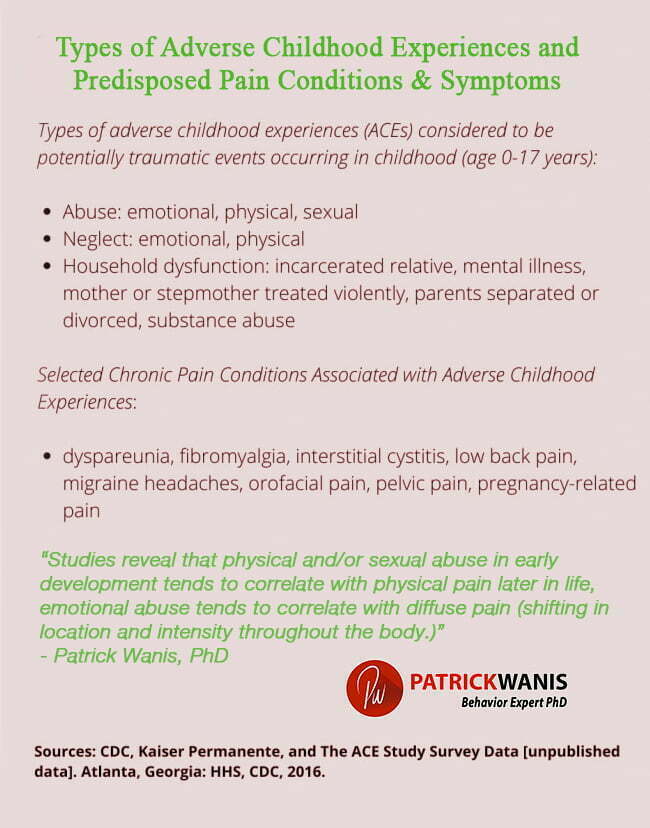
Trauma and Toxic Stress
As mentioned earlier, the HPA axis (hypothalamic pituitary adrenal axis) regulates the body’s response to stress. Traumatic experiences activate it chronically placing extreme stress on the body and in turn, impact brain development, learning, behaviors, and emotional functioning such as anxiety as well as impaired memory and mood control. The results in later life include metabolic disorders, cardiovascular disease, depression, and chronic pain. See diagram on Trauma and Chronic Pain. When trauma becomes PTSD – posttraumatic stress disorder, the impact on the body is extreme and that can further result in musculoskeletal and other ill-defined pain conditions such as fibromyalgia, pelvic pain, irritable bowel syndrome, migraines, orofacial pain, pregnancy-related pain, and more.
“If the stress response is extreme and long-lasting, and buffering relationships are unavailable to the child, the result can be damaged, weakened systems and brain architecture, with lifelong repercussions.” – Center on the Developing Child, Harvard University
The National Scientific Council on the Developing Child presents three forms of stress responses in young children: Positive, Tolerable, and Toxic.
What distinguishes each stress is the intensity of the stress, its duration and whether supportive caregivers are present in the child’s life: Intense stress for an extended period of time, and a lack of supportive adults will make the stress toxic and weaken the brain architecture of the developing child.
Stress is a normal and essential part of life. Stress begins and ends in the brain; it is the body’s physiological and cognitive response to situations and events that you perceive as threats or challenges, and it includes biochemical changes to the neurologic, endocrine, and immune systems.
If the stress or challenge is small and short-lived, the brain and body respond well, and the body returns to baseline quickly.
Positive stress response is characterized by brief increases in heart rate and mild elevations in hormone levels. An example for children is their first day at school, meeting new friends, learning new tasks. Positive stress responses are infrequent, short-lived, and mild.
Tolerable stress response is the result of greater challenges or difficulties, but which is time-limited and buffered by loving, caring and emotionally supportive adults or caretakers. An example of tolerable but painful stress is the death of a loved one, divorce, a natural disaster, or a frightening injury. In the case of tolerable stress responses, once the adversity is removed, the brain and organs recover; this is dependent upon the support of strong and healthy relationships between the child and adult caretaker(s).
Toxic stress response is the result of strong, frequent, and/or prolonged adversity, with a failure of the body to recover fully, and without the support or buffering of a loving, caring and emotionally supportive adult or caretaker. Situations and events that contribute or lead to toxic stress in children include:
⦁ Parental mental illness
⦁ Severe maternal depression
⦁ Parental substance abuse
⦁ Parental abandonment or divorce
⦁ Emotional abuse
⦁ Sexual abuse
⦁ Physical abuse
⦁ Witnessing domestic violence
⦁ Emotional neglect
⦁ A family member in prison
⦁ Physical neglect
⦁ Economic hardship or poverty
“Toxic stress in early childhood is associated with persistent effects on the nervous system and stress hormone systems that can damage developing brain architecture and lead to lifelong problems in learning, behavior, and both physical and mental health.” – Dr. Dipesh Navsaria, University of Wisconsin School of Medicine
The toxic stress response affects the neuroendocrine-immune network, with abnormally high levels of cortisol. As a result, the immune system is impacted, and the body undergoes a persistent inflammatory state, increasing the risk and frequency of infections in children.
The human body is not designed to operate under constantly stressful situations, and therefore, elevated levels of stress hormones over a long period of time create wear and tear on the brain and other biological systems. High levels of cortisol damage tissues and the developing brain circuits.
The body attempts to respond and adapt to the acute or chronic stress. “This effect, which is called allostasis, can affect how our stress system regulates the stress response: the brain becomes less sensitive to the effects of cortisol such that it becomes harder to shut down our stress response system over time.
Allostatic load refers to the degree to which our brains and bodies try to adapt to chronically high stress hormones; a high allostatic load is associated with vulnerability to health problems later in life.” https://www.albertafamilywellness.org/what-we-know/stress These problems include maladaptive coping skills, poor stress management, unhealthy lifestyles, mental illness, and physical disease.
“Trauma is the emotional, psychological, and physiological residue left over from heightened levels of toxic stress that accompanies experiences of danger, violence, significant loss, and life-threatening events.” – zerotothree.org
Conditions associated with trauma bonding:
⦁ Domination: Power imbalance – the abuser has power over the victim
⦁ Dependency: Victim is helpless – dependent upon abuser for survival (sometimes real dependency, other times perceived dependency based on threats and loss of sense of self; victim sees herself thru the eyes and image created by the abuser)
⦁ Terror and fear: Real danger and threats of danger – terror and fear
⦁ Unpredictability: Abuse/punishment and occasional kindnesses and rewards – unpredictability generates more fear, terror, and dependency on the abuser
⦁ Isolation: To maintain secrecy
⦁ Isolation: To brainwash the victim, maintain control and domination over the victim, and to hide the victim from other people’s perspectives and revelations that the victim is actually experiencing abuse
⦁ Hopelessness: Driven by a belief that there is no escape or way out
⦁ Confusion and Conflicting Emotions: Alarm (hypervigilance), numbness (disassociation), grief (sadness, sorrow, helplessness)
Traumatic bonding: “A strong emotional attachment between an abused person and his or her abuser, formed as a result of the cycle of violence.” – Wendy Austin; Mary Ann Boyd. Psychiatric and Mental Health Nursing for Canadian Practice.
Good evening everyone and welcome to my weekly webinar with Clifton Brantley. Tonight, I have again with me Dr. Patrick Wanis. Tonight, we’re going to be talking about trauma.
As I was doing a few notes, I noticed the date, and so how fitting it is for us to be talking about trauma on a day where we’re remembering those who lost their lives in 9/11. We always often ask, “where were you when 9/11 happened?” I was thinking about that today. I remember where I was, and as Dr. Wanis was sharing, that’s kind of how trauma happens, right? Even though that trauma did not happen to me personally, I remember exactly where I was when that traumatic event happened. If anyone lost anyone during that time, you have my condolences.
Tonight, we’re talking about trauma with Dr. Patrick Wanis, and I, myself, am looking forward to this and I know a lot of you are too. So Dr. Wanis, take it away.
Dr. Wanis: Well, thank you Clifton. It’s interesting that you talked about 9/11 and there were many of us who were traumatized. But even now, in Covid-19, we’re re-experiencing trauma as a result of either social isolation, loneliness, being locked down, losing jobs, etc. If I were to ask you, and I don’t know if you’re going to conduct this poll, “Do you believe you’ve experienced trauma in childhood?” What would you say Clifton?
Clifton: I would definitely say, yes. Funny thing, when I went to therapy, right before I was 40, when I started talking to the therapist about what was going on, talking about my childhood and I’m just sharing, and then she had this look on her face, she was like, “oh, we’ve got to do trauma work.” And I was like, “trauma work? What do you mean? I had a normal childhood. What do you mean trauma work?” As she continued to explain to me, I was like wow, I had no idea that those were traumatic events.
But let me do this poll quick, because I really want to know what other people think. Then afterwards, after you’ve done your presentation, I want to see if their answers are the same. So here we go quick, so I’ll give you guys maybe like 2-3 minutes to answer this – do you believe you experienced trauma in your childhood?
Dr. Wanis: And it’s basically just a yes or no. In a moment, I’m going to explain what trauma is, how trauma affects you, what are the outcomes of trauma, how you heal trauma, the types of trauma, and why trauma negatively impacts your entire psyche. It affects your mind, your emotions, your body and even your sense of spirituality. What I mean by that is your connection to the world and whether you’re able to live from your heart or not.
What I’d also like to say right from the beginning is, I’m sure Clifton, that the majority of people who are coming onto this webinar already have a sense that they’ve experienced trauma or they already know they’ve experienced trauma. One of the most important things I’m going to say to you is that there’s a chance that as we’re talking about it, some negative or painful emotions are going to come up for you. Please recognize that no matter how bad you feel in this moment or in that moment if you get triggered and those emotions come up, that you can be healed, and it can be done gently, safely, easily, and relatively quickly.
The next thing to say is to be aware right now: What is your perspective about the way that you live your life; because we often use these phrases – “I’m a victim of.” It could be “I’m a victim of trauma, I’m a victim of abuse, I’m a victim of rape”, etc. Or “I’m a survivor of trauma, abuse, or rape.” The words that I use are “I have experienced, abuse, rape, trauma”, or whatever. Then I talk about where I am now.
Many of us tend to take what happened to us in the past and still make it part of our present identity. I’m not talking here about the subconscious impact, I’m talking about the way we view it; that we start putting these words in sentences – “I am a victim of”, which means you’re still there.
Step number one is: notice the words and the language that you use, “Where are you now?” You’re in the present moment, you’ve experienced something in the past.
The next thing I’m going to say is: All traumas can be healed.
The third thing I’d like to say is: Everything has a beginning; whatever you’re experiencing, whatever challenges you have mentally, emotionally, psychologically; they all have a beginning.
Adverse Childhood Experiences – ACE.
These adverse experiences in childhood – often trauma, are also known as Adverse Childhood Experiences – ACE. The ACE Pyramid shows the impact of trauma/adverse childhood experiences during the life of a person.
There’s even now research that links bipolar disorder to trauma. In fact, Bessel A. van der Kolk M.D., author of “The Body Keeps the Score: Brain, Mind, and Body in the Healing of Trauma” found that 81% of patients with bipolar disorder at one hospital had severe histories of child abuse or neglect, most before age 7. Thus, you will see in this webinar, how so many of the things that we tend to think as just either chemical imbalances or “I was born that way” or some sort of aberration, isn’t true. They’re all traceable, even to the extent of you potentially inheriting traits, personality characteristics and emotions of your grandparents and great-grandparents. This is what we call behavioral epigenetics.
In behavioral epigenetics, we say that there are genes that affect your behavior that you’ve inherited from your parents. Not just your parents, but your grandparents and great-grandparents.
There’s also something else that’s important to be recognized, that many of us have certain genes that lay dormant unless something happens to us. That’s what we refer to as epigenetics.
So quite a few years ago, not that many years ago but within the last 10 years, a scientist was doing research into psychopathy and sociopathy, and he discovered that there’s a gene which they labelled “the warrior gene”, and as he’s doing this research, he realizes 2 especially important things. One is that the warrior gene is there in many of us but gets triggered by things that happened in our childhood, in our environment. Then this same scientist realizes he’s actually got that gene and he says, “well, that makes sense because that explains why many people often talk about by my behavior as being very, very callous.”
So, we recognize that the things that happen to us impact us, even to the extent of impacting our genes. The question is when we think about trauma, what do we first think of? We think about PTSD – Post Traumatic Stress Disorder. And with that, we think about someone that has come back from the war and that has suffered psychological trauma. Or we think about someone that’s been in some accident and they’ve experienced physical trauma or it’s also affecting them psychologically.
But trauma is much more than that: Trauma is the psychological wound from the fear of harm or from the actual harm that occurred to you – physically, mentally, emotionally, sexually.
Trauma and Relationship Attachment Styles
For all of us, it happens in our childhood. Let me explain it this way, when we’re born, we’re a clean slate. By that, I mean, we only really have 2 fears – the fear of falling and the fear of loud noises. The other fears that we have are fears that we develop because of things that happen to us and as a result of programming.
The most important years in your development are the first 2 years, then the first 6-8 years, then the first 10 years, then the first 18 years. But the most impactful are the first 2 years. Why? In those 2 years, you’re going to develop a sense and a feeling about the safety and security that you have in connection to the people around you and the world around you. It’s sort of the answer to the question – “am I safe? Will my needs be met?” This is what we refer to as attachment style. So, in the first 2 years, if your parents really attended to your emotional needs; that means when you cried, they came, they held you, they hugged you and they even responded to your facial expressions and they comforted you when you’re either crying or screaming or needing something, then you develop what we call a secure attachment style. I’ll explain how this relates to trauma in a moment.
Secure attachment style means that when you’re in a relationship, you feel safe, you feel good, you feel secure, you’re able to trust your partner and you’re able to give and receive support from your partner, so you feel good about yourself in that relationship. That’s what we call the secure attachment style. But what if in your first 2 years as an infant, your parents, or your primary caretaker, usually your mother or someone else that was taking care of you, didn’t respond to your emotional needs or she was cold or she was distant or she took a long time to respond to you or left you there crying for hours or even for 5 or 10 minutes. Then what happens is you develop what we call an insecure attachment style. That means when you’re in an adult relationship, you respond in an insecure way.
There are 3 types of insecure attachment styles:
⦁ The first is where you become very clingy and needy, you become overly attached to the extent that you become anxious about the relationship, you become almost obsessed about the relationship. So, you’re constantly thinking about the relationship and you’re constantly wondering “did I screw up? Is this person going to leave me?” So, you become clingy because you didn’t get those needs met in the first 2 years.
⦁ The next insecure attachment style is avoidant; where maybe your mum or caretaker didn’t respond to you, so you responded by actually pushing them away. Therefore, you get close to someone, then you avoid them.
⦁ The third is either dismissive which means you dismiss relationships, “oh I don’t need a relationship” or you’re a mixture of those – Anxious-Avoidant.
Please see expanded definition in the diagram “Which Is Your Attachment Style” and read my article:
All of that happens in the first 2 years. Now imagine what happens when in the first 2-4 years, you also experience trauma. How is that going to affect you in your relationships? We’re going to explain that in a moment. I’d like to jump ahead a little bit because I sort of wrote out a rough outline and I want to talk about the impact that your parents have on you even if they don’t do anything bad to you. What I mean by that is the relationship that you have with your mother or your father. Let’s say they weren’t abusive, you didn’t experience any physical abuse, you didn’t experience any mental abuse, you didn’t experience any emotional abuse or any sexual abuse. But what about if you were born to a depressed mother. So, what if you were born, and from the moment you were born, your mother was in a depressed state and was in that state for a long time?
Maternal Depression, Trauma and Still Face
In 1975, an experiment was done called “Still Face.” What they did was they took a mother with an infant who was maybe eight months to a year old and they watched the mother interact with the child. As you know, if you’re a parent, the child responds to you and you respond to the child; the child smiles, you laugh. Therefore, the child thinks that they’re controlling you. The child makes faces, you make faces. The child makes noises, you make noises. The child points out to the left, you look out to the left, and you’re interacting. Then what they said to the mother was okay, now, what we want you to do is, just for 2 minutes, put on a still face, no expression. No matter what the child does, you can look at the child but no expression. So, the mother does that and in these 90 seconds, you look at this child who starts to change. The child is walking back and forth, the child’s arms are flailing, the child starts to throw his head back, then eventually the child starts screaming and turns away because the child’s not getting a response from the mother.
So, if you were a person who was raised by someone (mother or another caretaker) that was in a depressed state and therefore was often still-faced, expressionless, and didn’t respond to you, then you’re also going to have experienced trauma and you’re not going to feel safe. I’m going to talk about this more in detail. One of the key aspects of healing trauma is getting you to feel safe again internally, as well as releasing emotions and changing beliefs.
I wanted to share that to say even if your parent hasn’t done anything harmful to you, the way your parent is, the emotions that your parent expresses or doesn’t express, also impacts you and can be traumatic. Let’s say you’re in the womb and your mother is in a depressed state, that also affects you because when a person is in a high-stress state, they’re releasing all sorts of chemicals – stress hormones that also affect the embryo. I’m going to talk about this in a moment. See the diagram below.
Trauma and The Relationship Between Mother and Unborn Baby
As explained above and in the diagram, the relationship between a mother and a baby begins during pregnancy and this can either lead to trauma/toxic stress or healthy outcomes.
Factors that impact mother’s stress and her perceptions and feelings towards the unborn baby include:
1. Other young children in the household – additional pressures/stress
2. Planned or surprise pregnancy – an unplanned pregnancy can create additional stress depending on the situation and context
3. Domestic abuse (verbal, emotional, physical, or sexual abuse)
4. Mother’s personality traits and disposition (perhaps she is depressed or suffering from other stress)
5. Mother’s unresolved trauma from her childhood
6. Mother’s own attachment style – is she secure in her adult relationships; if she is not secure, she may create an insecure attachment style after birth
7. Mother’s life stage – is she psychologically developed for motherhood or is she still in need of mothering/fathering (i.e., is she a teen?)
British psychologist and psychoanalyst, John Bowlby studied and revealed that early childhood attachments play a critical role in later development and mental functioning. He cited three categories of relationship between a mother and her developing baby – Balanced, Disengaged and Distorted.
Trauma And Love: Can You Love Yourself If You Have Never Been Loved?
“For years mental health professionals taught people that they could be psychologically healthy without social support, that ‘unless you love yourself, no one else will love you.’…The truth is, you cannot love yourself unless you have been loved and are loved. The capacity to love cannot be built in isolation”
⦁ Perry B, Szalavitz M. The boy who was raised as a dog: and other stories from a child psychiatrist’s notebook: what traumatized children can teach us about loss, love, and healing
This above quote has been widely shared on the internet, but it is incomplete.
Here is the entire quote from Dr. Szalavtiz’s book, which explains the significance of relationships:
“For years mental health professionals taught people that they could be psychologically healthy without social support, that ‘unless you love yourself, no one else will love you.’ Women were told that they didn’t need men, and vice versa. People without any relationships were believed to be as healthy as those who had many. These ideas contradict the fundamental biology of human species: we are social mammals and could never have survived without deeply interconnected and interdependent human contact. The truth is, you cannot love yourself unless you have been loved and are loved. The capacity to love cannot be built in isolation.”
This is a controversial statement and perspective: you cannot love yourself unless you have been loved and are loved. I believe we all have the capacity to love and be loved. Childhood experiences and programming will either convince you at a subconscious level that you are lovable or that you are not lovable. A baby innately expresses love and affection as long as it feels safe, and the love is reciprocated. Trauma, abuse, neglect and so forth program the child to believe that love is not safe, that the child is not worthy of love or it is not lovable or wanted. In turn, the child also believes that her love is not worthy or valuable and so she withholds love or grows into adulthood with either a Twisted definition of love or simply believes he/she isn’t good enough to be loved and so he/she attracts someone who reflects that subconscious belief and re-experiences victimization, rejection, or abuse, further reinforcing the subconscious belief that she is not lovable.
Yes, I teach that it is critical to love yourself so that you don’t give out needy love – desperate to be loved while not believing you are worthy of the love. However, I also teach that it is not healthy – physically or psychologically to be isolated or to be without social support – various forms of emotionally and sexually intimate relationships. We are hardwired for connection and yes, while striving to seek our own validation and acceptance, we do actually need love, validation, acceptance and belonging from others. We need relationships. Notice, too, the way that Using SRTT – Subconscious Rapid Transformation Technique as a highly fluid process and technique, I help and have helped thousands of people to develop self-love: self-acceptance and self-compassion. It begins by using a process at a subconscious level to demonstrate, feel and express love and compassion for the child that was you and for the child that still exists within your psyche. So, I agree with Dr. Szalavitz that love cannot be built in isolation. Love needs to be built and expressed towards yourself at a subconscious level with a special technique (SRTT), and love needs to be built with social support – but you need to be able to allow yourself to be loved; you need to allow yourself to receive the love so that you do not reject or sabotage it and so that you, too, can express love. Ultimately, what I am actually doing is helping you to subconsciously heal the wounds and your spirit, and to unlearn all the things that successfully fooled you into thinking that you are not lovable.
With SRTT, I am helping you to transform your beliefs and relationship with yourself and the world around you: is it a safe place, are you lovable, are you free to express yourself?
Dr. Szalavitz writes: “Relationships are the agents of change and the most powerful therapy is human love.” I agree, optimal human psychological health is directly linked to healthy relationships. And, yes, the most powerful therapy is the love and compassion you can express to yourself with the help and support of others! And this love is not a poetic or philosophical love. No. This love is something that is tangible and actionable as I teach in my SRTT sessions.
Hopefully by now, you’re getting some sort of understanding what trauma is. Again, I explain trauma as a wound or an injury. It’s your response to either having been harmed or having experienced perceived threats. You felt you’re in some sort of danger. And then there are different types of trauma which we’ll bring up in a slide in a moment.
There are 3 basic types of trauma. The first is acute – that means you had 1 trauma and it was one time incident, albeit severe. Maybe it was an accident, maybe something was done to you. So here, we’re going a little bit further because I was going to talk about acute trauma, multiple trauma and complex trauma but leave this slide up. (See diagram “What Are Acute, Chronic and Complex Traumas?”) You look at the first and we’re talking about the basic types of trauma that are either emotional, physical, or sexual. Then if you can read the second column Clifton, the middle column.
Trauma – Abuse, Neglect and Household Dysfunction
Clifton: The second column – of neglect – it says physical and emotional.
Dr. Wanis: So here, we’re talking about whether your parent or your caretaker, attended to your emotional needs, and whether they also attended to your physical needs. Then the third column is about dysfunction within the family. Would you like to read those 3 please Clifton?
Clifton: Yes. This one has mental illness, an incarcerated relative, mother treated violently, substance abuse, and then the last one – divorce.
Dr. Wanis: So, think about your situation as you’re watching this. What was the dysfunction in your family? Because this is a trauma for you. I know it’s really difficult for people to accept that for a child, the separation or divorce of a parent is actually very traumatic. We look at it as an adult and we think, “look, I’m not happy, she’s not happy, it’s not good for the children for us to be unhappy or arguing or fighting or cold or distant. It’s better for us to divorce.” That’s true. Except the problem is the child who’s egocentric and believes the universe revolves around them says, “my mummy divorced, or my daddy divorced, and my mommy or daddy left, therefore they left me.”
One of the most important things that a child needs is a sense of security – physical security, emotional security, security of food, water, shelter and knowing that there’s someone there to protect them. They need stability, security, and routine. Once there’s separation and divorce, that’s gone. So, the separation or divorce of a parent is actually a trauma. If one of your parents was incarcerated, that’s a trauma. If one of your parents had a mental illness, that’s a trauma. What were the other ones, Clifton? Because I forgot. Pull that slide back up.
Clifton: Mental illness, incarcerated relative, mother treated violently, substance abuse.
Dr. Wanis: Right. So, they’re the 2 missing. This comes from what is known as “Adverse Childhood Experience Assessment.” (Take the Assessment on this page.) When they did that, they looked at, often, the mother being the victim of violence – of domestic violence. But the father can also be the victim of domestic violence and that’s happened as well, or it could be one of your siblings. So, did you witness domestic violence in your family? It might not have been physical violence; it might have been emotional violence. Then also, was someone in your family suicidal? That could connect to mental illness.
These are just some examples of the primary traumas that we assess through the Adverse Childhood Experience Assessment. So now, we start thinking – which one of those 10 did you experience? Was it just one or was it more? So, this ACE – Adverse Childhood Experience study was conducted in 1998 with 17,500 adults, and they traced back the trauma in their lives and then realized there was an extraordinary, stunning, shocking link between the traumas and the health outcomes.
Now before I get to talk about that, let me say that, as I said, the ACE Assessment looks at 10 types of trauma, but there’s actually many more.
Bullying And Poverty Are Also Trauma
For example, were you humiliated by your parents? What did your parents say and do? If you grew up in a war zone, then that’s another trauma. If you grew up in homelessness or poverty, that’s another trauma. Here’s one that’s become very common in the last 10 to 15 years – being bullied at school, or even having a teacher that bullied you or treated you such that you experienced trauma. (There are 3 realms or categories of Adverse Childhood Experiences. We talked about the first 10 traumas which are within the Household, next is the Environment and third, the Community. The Environment refers to climate, droughts, natural disasters, wildfires, pandemics and so forth. The Community refers to poverty, violence, discrimination, few jobs, low wages, lack of social and capital mobility, and so forth. See the diagram further below.)
Clifton: That makes me have a question because I don’t want you to go too far with this. Actually, 2 questions. Number 1 – if I experienced when a parent had mental health issues or someone went to jail, how does that give me trauma? It’s not happening to me.
Dr. Wanis: That’s an incredibly good question. The way that we look at that is to say – what is the impact of a parent’s incarceration upon the child? The clients that I’ve worked with who did have an incarcerated parent, the first thing is the sense of abandonment, the sense of neglect, the fact that they lose that relationship with that parent. So, there’s loss, there’s potential neglect and abandonment, there’s also the loss of sense of security, there’s the sense of shame and worthlessness, and then there’s the sense of what’s my future? Is there hope or is there helplessness? And how does that affect me if I’m going to visit my incarcerated parent in prison or if my mother says you’re never going to visit your father ever again. So now you might also go to the sense of parental alienation. So, incarceration has an extraordinary impact, a negative impact, and creates further trauma on the child. It depends on how that happened; did you witness your parent being taken away?
Parental Mental Illness and Traumatic Effect On Children
The second one that you asked was about mental illness. I gave the earlier example of a parent who might be depressed but what about if the mental illness resulted in the parent isolating themselves? I had a client like this, in fact, she was the one that was doing it. When she came to me, she was experiencing extraordinary, deep depression. She would send the kids off to school but then she’d go and sleep in bed all day. Then when they came home, she struggled to connect with the children. So, when the children tried to connect, they couldn’t connect. So, there’s a loss of a relationship, there’s a loss of connection. A loss of connection is definitely a trauma.
The next thing is that they don’t get their emotional needs met. The child doesn’t get his or her emotional needs met. Let’s also look at the possibility of “well, how does that mental illness affect the parents’ behavior?” Are they going to be aggressive, are they going to be angry, are they going to be violent, or are they going to be socially withdrawn?
One of the other things that we didn’t talk about is a parent who has a problem with alcohol or a parent who has a problem with substance abuse. Any child that has grown up in a house with an alcoholic parent knows about the level of fear and the sense of deep insecurity, because you’re coming home, and you don’t know how’s alcoholic mum or alcoholic dad going to be today? Are they going to be abusive, are they going to shout, are they going to scream?
Here is an interesting example – a mother who takes her asthmatic child to a doctor, and because this doctor is also working in trauma, asks enough questions to learn that this little girl has strong powerful asthma attacks every time her dad punches a wall. So, here’s the dad who might have anger issues, might be alcoholic, might have a mental illness, but every time he punches the wall, it’s as if he’s punching the girl; in the sense that her sense of safety, security and stability is gone. So, these are really important. Now there’s another slide we’re going to pull up just to summarize these different traumas. It’s the next slide.
Clifton: Types of trauma?
Dr. Wanis: Yes. So, you can read these very quickly to yourself but again, it just summarizes the 10 traumas that I listed. Whether it’s physical abuse, emotional abuse, sexual abuse, whether it’s some form of neglect, whether it’s a parent who had substance abuse problems, a parent who had mental illness, a parent who committed suicide, a parent who was incarcerated, etc.
Adverse Childhood Experiences
Adverse Childhood Experiences: “intra-familial events or conditions causing chronic stress responses in the child’s immediate environment. These include notions of maltreatment and deviation from societal norms”
⦁ Kelly-Irving M, Lepage B, Dedieu D et al. Adverse childhood experiences and premature all-cause mortality.
“… adverse childhood experiences that harm children’s developing brains so profoundly that the effects show up decades later; they cause much of chronic disease, most mental illness, addiction, and are at the root of most violence.”
⦁ International Initiative for Mental Health Leadership. Healthy Families: From ACEs to Trauma Informed Care to Resilience and Wellbeing: examples of policies and activities across IIMHL & IIDL countries. December 2016
Trauma of Loss – Adverse Childhood Experiences
There’s another trauma that I haven’t mentioned and that’s loss – the loss of someone. For me, I had a great sense of stability and security in the first 10 years because of my closeness to my maternal grandmother, but then she died when I was ten and half years old. That was a trauma for me because that was the only person with whom I’d ever had a real connection. I didn’t have a connection with my parents, unfortunately, I didn’t have a great connection with my older brother. My next brother was 11 years younger than me, the next one was 15 years younger, so I was taking care of them for at least 3-5 years or more, actually for about 7; until I left when I was about 19. So, the loss of my grandmother was a huge trauma. I’ve also worked with clients Clifton, and some of them were yours that were referred to me who lost a grandmother or lost an aunt or an uncle, and that person was their sense of safety, sense of security. Now if you can pull up the next slide, I’d like to show you a little more about trauma.
Trauma – Strict Upbringing or Abuse?
Clifton: Well, I have a comment on that slide though. The first thing on there was physical abuse. For me, a while back, I had posted on Facebook, I think about a year ago, and I said that in the black community, we raise our children with shame. When most black people were around my age, maybe not the younger ones, because I don’t know how we got away from it or not, but we grew up getting whippings. Not only that, but we grew up being shamed, “sit down and shut up”, humiliated in public. But the thing is, it was made to be normal. So, I know that there are probably a lot of my guests on here who think that their childhood was normal. I mean like, “look at me, I’m not in jail, I’m running a company, I’m successful. It must have been good for me.” Talk about how when you normalize trauma, you don’t really address it but then how does it still affect you?
Dr. Wanis: You’ve raised a really good point because in a moment we’re going to talk about the health outcomes of trauma and that’s a really important part of this equation. Nonetheless, let’s respond to your point which is true. A lot of people, particularly going back 10, 20, 30 or 40 years; were raised with physical beatings as a form of discipline. But what’s the impact on the child?
Now, you’re going to laugh at this story, you’re going to say, “This is absolutely bizarre; I don’t believe you.” So, I grew up in an extremely strict religion and my dad was extremely strict. It was black and white; you did wrong – you got hit. You did right – we’ll leave you alone. We won’t say anything, we won’t praise you, but at least you won’t get hit. I didn’t realize till I was in my mid 20’s that that was even abuse. I carried around a lot of anger, but I never said, “oh yeah, I experienced abuse.” Now I just thought, “oh my dad was very strict.” But I never put 2 and 2 together, I never realized what the relationship outcomes were, what the health outcomes were… Or here’s the best part, why I ran away from Australia, I didn’t just go on a walkabout. In Australia, we have the expression – “to go on a walkabout.” A walkabout comes from the aboriginal term which means they’re constantly traveling the country. And we’d say in Australia, “oh, he’s gone on a walkabout”, and he might disappear for a couple of weeks, or a couple of days, maybe a vacation, maybe exploring. Well, for me, I went to the other side of the world and then I just stayed away.
Now, if you asked me back then, Patrick are you staying away because you’re running away from something?” “Okay, what! Are you nuts? No, I’m exploring the world.” But later, I went – “oh I’m actually running away. What am I running away from?” Obviously, I was running away from what was an unhealthy environment, but I was also running away from myself. I was running away from my own pain. You can’t run away from your own pain.
Then when you start to have these weird symptoms, like I had for years and years, all these liver problems. But I’m healthy, I exercise, I do lots of exercise, I eat healthy. I thought, generally speaking, my thoughts are healthy, why do I have these liver and digestive problems? Well, the answer is in the 1998 study of the Adverse Childhood Experiences which linked even liver disease and hepatitis to childhood trauma.
Trauma and Its Negative Impact On Health Outcomes
In a moment, we’re going to talk about those health outcomes. But I want to make a point that sometimes, we don’t know how that event has actually impacted us. I’ve had this experience with so many clients whereby, for example, a client says she’s having problems and she’s reacting to her husband touching her and she just flips, flips the switch, and shuts down or freezes or feels really uncomfortable or afraid. I ask her a couple of questions and I said eventually, I said, “did anyone ever touch you when you were a child, and it was an unwanted touch?” She said yes. Well, when did it begin? “Age 5.”
As we go back using my process – Subconscious Rapid Transformation Technique, the emotions come up. So, this woman as an adult hadn’t recognized the impact of this one incident, it was just one time; and the boy was, I believe, about 9 years older than her, and he actually placed his finger inside it. I said that’s penetration, that’s sexual battery, that’s rape. Particularly when the boy is 9 years older than you. But above all, when we went back there, she identified the emotions and the beliefs that she created because of that single traumatic incident.
Clifton: That is the thing – the beliefs that you develop. I tell people, we look at the crackhead and we know his life went sideways. But when you’re successful and running a company, you don’t think that. But the beliefs that you’ve developed from this… I don’t know if you remember, but we were talking one day, we weren’t even doing a session, we were talking, and I asked you a question about my childhood. Long story short, when we got to the end of it, I discovered… If I’m 48, I discovered around 45-46 that I was molested as a kid. I had no idea.
Dr. Wanis: But that was not a false memory? You remembered it, correct?
Clifton: I remembered it, but I never labelled it that until you asked me. Even while we were talking, I didn’t. Until you asked me “Well, what if it was your son?” Then I got angry. You’re like “Well, why are you angry?” But then the beliefs that came from it, when you told me, because we weren’t doing a session, you said what this kid may believe about himself, you said “may believe.”
I was able to look back over my entire life all the way back to elementary school and see the handprints of that molestation on every single relationship. That blew my mind because again, I wasn’t living what I thought was a traumatic life, but my beliefs about me and how it relates to women and sex was heavily impacted and I was clueless. Because, I want to say this too, a lot of men… Because in our culture, sex is good and so if you have a lot of partners, it’s not a bad thing. There may be trauma that you’re missing, that you’re not dealing with.
Dr. Wanis: Well, yes. Of course, if you’re a child and someone more than 5 years older than you is engaging in some sort of sexual contact, that’s unwanted, and then that leads to child abuse. I also have many clients who it started at age 8, this is a very bizarre thing that I’m going to share with you. It’s a pattern that I identified after working with many clients who are the victims of sexual abuse, I’m talking about female clients who are adults. They would tell me the story that it started around age 8 and went until 13 or 14, sometimes to 15. But it was always around age 8 to about 13, by a stepdad. Sometimes by the father, but often by the stepfather.
What’s extraordinary about that is the impact that it has on the person. This girl would get sexually abused on a regular basis, almost every day for 5-7 years. Then we say – how does this happen? Not in terms of how it was hidden, but how did this happen in terms of the impact it has on the child.
Now let’s talk about the health outcomes because this is the key. You mentioned beliefs and we do formulate beliefs such as “I’m dirty”, if you’ve experienced sexual abuse, “I’m dirty, what I want doesn’t matter, I can’t ask what I want.” You become a people-pleaser, you can’t set boundaries, etc. So, there’s the beliefs that need to be changed, there’s the emotions that need to be released and we have to revive that sense of safety and security.
The health outcomes are all impacted by the trauma because the trauma does the following. Let me put it this way, you’re in a forest and you encounter a bear. What’s going to happen? Your brain works instantly and registers the bear as a perceived threat. Now there’s a signal, the HPA axis is triggered, that’s the hypothalamic-pituitary-adrenal gland axis are now working together to do everything that they need to do to keep you safe, because you’re either going to fight that bear or you’re going to run for your life. That means your body releases adrenaline, noradrenaline, epinephrine, norepinephrine. Your blood starts pumping, your heart starts pumping blood really fast, your blood pressure rises, cortisol is released, your pupils dilate, and all of the blood is rushing to your outer limbs – your fists and your hands.
Trauma and Polyvagal Theory – Your Nervous System Decides For You And Controls Your Behavior and Responses
Polyvagal theory is a concept that was developed by Dr. Stephen Porges and it explains the link between trauma, our nervous system, and our bodies, behaviors and emotions. Polyvagal Theory states that we have three physiological States:
⦁ Social Engagement
⦁ Fight or Flight
⦁ Freeze
The autonomic nervous system (ANS) functions without your conscious awareness, and it mediates your emotional expressions. The autonomic nervous system consists of the sympathetic nervous system (controls fight or flight and releases stress chemicals) and parasympathetic nervous system (controls rest, digestion, and regeneration.)
It is the vagus nerve or the tenth cranial nerve that regulates the autonomic nervous system, and the vagus nerve connects the brain to major systems in the body which supporting the communications between the mind and body.
There are two vagal systems – “ventral vagal complex” (VVC) also known as the “social nervous system”, and the dorsal vagal complex.
Dr. Porges claims neuroception is the body’s assessment of threat in the environment and it is determined by your nervous system, and in turn, the assessment of threat or non-threat will trigger one of the 3 physiological states: Social Engagement, Fight or Flight, or Freeze.
Each one of these physiological States affects the way we feel, the way we behave and obviously our health. Thus, according to Polyvagal Theory, it is your physiology – specifically the nervous system – that determines the way you interact, and the way that you behave.
The ventral vagal complex (“social nervous system”) connects above the diaphragm to the heart, lungs, larynx, pharynx, inner ear, and facial muscles around the mouth and eyes.
The dorsal vagal complex connects to the organs underneath the diaphragm including the stomach, spleen, liver, kidneys, and small and large intestines.
The diagram on Polyvagal Theory reveals each of the three physiological states impacted by the vagal systems.
Social Engagements state or ventral vagal complex (VVC) is when there is a feeling of safety which allows for openness, relationships, and connection. If you feel a sense of danger, then the fight or flight response the sympathetic nervous system is activated this prepares you to fight back or to run. If your nervous system perceives the threat to be so great that it is overwhelmed and it cannot fight or run (perceiving it as a life threat that cannot be outrun or defended) then it enters the Freeze response, which is almost a state of collapse.
According to polyvagal Theory, each one of these states can become a dominant state based on traumatic experiences and other things that happened to you as well as genetics and epigenetics. In turn, this might explain some behavioral responses such as the fear to act because the nervous system is saying, “I cannot”, and therefore you might struggle in life to say, “No” or to set boundaries.
Although these become programmed responses and reactions by the nervous system, using Subconscious Rapid Transformation Technique (SRTT) for trauma, I’ve helped people to change their automatic responses by helping them at a subconscious level to feel safe and to lower the unconscious, constant hyperarousal of fear and danger.
When the nervous system is in a sense of safety, you feel grounded, curious, open, calm, and connected, and you are able to fully immerse yourself in the present moment and in the surrounding environment.
When the nervous system perceives danger and it goes into a Fight response, then emotions such as rage, anger, irritation, and frustration are the result.
When the nervous system perceives danger, it may also go into Flight which results in emotions such as panic, fear, anxiety, worry, and concern.
When the nervous system perceives the threat to be overwhelming, then the resulting emotions and responses are disassociation, numbness, depression, helplessness, hopelessness, feeling trapped, shame, and feeling shutdown.
During traumatic experiences in childhood, you will enter one of these 3 states – Fight, Flight or Freeze (including the extreme version of Freeze – shutting down.) Using Subconscious Rapid Transformation Technique (SRTT), I gently and safely take you back to that experience where are you are observing it and not reliving it. We then change the subject conscious association of the nervous system with the event. In other words, we’re not changing the memory of what happened, we’re not changing the facts, we’re actually changing the way that you perceived what happened and therefore changing your nervous system. By neutralizing these old responses and dominant physiological states, you can generally feel safer and more grounded, and therefore, in the present moment you can use the response that is necessary and appropriate to whatever is happening in your life. Thus, instead of being afraid, you are now able to stand up for yourself and to say, “No…stop…I won’t allow that.” You have greater self-confidence and courage to be able to set boundaries and to exit unhealthy relationships or jobs.
Sources: Ruby Jo Walker, Dr. Arielle Schwartz
Responses To Trauma – Fight, Flight or Freeze
So, you can either fight or run or freeze. Now your immune system shuts down and your digestion either comes to a complete stop or slows down. Your entire body is ready to fight or flight; ready to fight or flee, or you could be so frozen by the fear that you actually feign death. Now that’s okay because it’s a bear. But what happens if you are coming home, you’re a little girl or a little boy, and you’re coming home every day to that bear? That means you’re coming home every day to a perceived threat, to a monster. So, every day that you come home from school or from wherever, and you enter the house, maybe your dad’s an alcoholic so he doesn’t hit you every day, but there’s a chance he might hit you. The moment that you come into that house or you’re getting close to that house, up comes the feelings; and those feelings are your brain releasing all of these chemicals to put you in the fight or flight state, that’s hyper alert, hyperarousal – adrenaline, noradrenaline, epinephrine, norepinephrine, are all fantastic chemicals when you need to run away. But when you’re experiencing them on a daily or regular basis, they are deadly, they are poison. That’s what we call toxic stress.
Over a prolonged time, you’re re-experiencing that hyper-arousal state. Now all of those chemicals and that trauma also affects your brain. If you’re a child developing, it affects your social development, it affects your cognition, and it affects your brain.
What they found over decades of study is that the trauma will constantly activate the amygdala which makes you more fearful and more aggressive, and it enlarges the amygdala, but it shrinks other parts of your brain. In fact, only about 8 years ago, they discovered that chronic stress shrinks the prefrontal cortex. The prefrontal cortex is your executive decision maker, that’s what you use to control impulses. But the prefrontal cortex is also involved in memory and learning.
So, when it comes time to draw a diagram or to work out a mathematical equation, there’s a certain part of your brain that you use. But if you’ve experienced trauma, you’re not able to use that part of the brain. So, what happens is when we find children that are not able to perform well at school, we must look at their history of trauma.
One doctor who’s leading this movement – Dr. Nadine Burke Harris, looked into this and she reveals that even with ADHD, there are so many children who have a long history of trauma. So, the trauma affects our health outcomes, then it affects things such as substance abuse and addiction. Then you say, well, how does that work? This is going to be a little surprising, but many, many years ago, probably decades, long before I ever studied anything to do with trauma, anything to do with addiction. To me, it seemed like common sense and I would say “Addiction? Well, that’s pretty simple to understand.” The people are engaging and abusing substances or behaviors because they’re trying to escape a pain or because they’re already so numb, they’re trying to feel something. It’s the concept, not that they want to necessarily get high and experience pleasure, but rather that they want to escape the pain and the past and the trauma.
Lo and behold, when I went to a rehab clinic, I ended up working in a rehab clinic, when I said this to the director, she was stunned. And I said, “Why would you be stunned? isn’t this common sense?”
Link Between Trauma, Obesity and Sexual Abuse
Well, if you go back even further to 1985, Dr. Vincent Felitti was working in a clinic in San Diego. He was working with patients who were 100-500lbs overweight; and what he noticed was that he had lots of success with them losing weight. But 50% of his clients who were having success losing weight, would drop out. That means as they’re having success, they would withdraw from the program. Then he said this is bizarre, why is this happening? So, he started talking more to his actual patients and he ended up posing a question to one patient, “How much did you weigh when you were first sexually active?” She said, ‘40lbs.’ He said “40lbs? You were sexually active when you were 40lbs?” She begins to cry, drops her head in shame, because she’s feeling the pain. She says, “I was 4 years of age when my dad started sexually molesting me.”
Now, he was smart enough to say there is a link between the outcome of obesity and the trauma. When he went on to present this at a medical symposium, they all laughed at him. They said to him, “No, this is BS”, because the medical field and even the psychological field was set in their ways. He then went to this other doctor and said ‘look, I’ve surveyed 300 of my patients and here’s what we found…’, and he started making the link between the obesity, the emotions, and the trauma.
I think too, that there are certain people that are raised by their parents. Imagine girls who are told by their mother “you’re eating too much, you’re getting fat, stop eating so much, don’t take a second, what are you doing.” Then that person starts to also experience pain and starts to change their identity and experiences trauma.
So, this doctor then went, partnered up with another doctor and they did a study with around 17,500 adults, tracing their current medical condition and their trauma. So they go, “here are all the medical outcomes – heart disease, lung disease, hepatitis, etc; here all the psychological issues they have. What are the traumas that they’ve experienced?” Then they came up with the Adverse Childhood Experience Study and Assessment. That’s when they asked these 10 questions – did you experience any of these traumas? Then they realized the more traumas you have, the unhealthier outcomes you’ll have. In fact, in follow up studies of another 13,000 people in 1995-1997, the researchers found that physical and verbal abuse were most strongly associated with obesity, and the obesity risk increased with the number and severity of each type of abuse.
Link Between Trauma – Emotional Abuse and Obesity, Binge Eating Disorder and Shame
Here is a summary by Dr. Martina Jelley and Professor Kim Coon from the Oklahoma University School of Community Medicine – “Origins and Sequelae: The Psychology of Obesity” on the link between Adverse Childhood Experiences (ACEs) and obesity (2017):
Complex biopsychosocial factors contribute to obesity
• ACEs are associated with poor self-image, negative predictions about change, psychological distress
• Individuals who experienced ACEs have a much harder time with impulse eating and controlling consumption
• Trauma defenses may perpetuate obesity
• Poor coping strategies lead to using food as a soothing mechanism
• Stigma and guilt about obesity (and ACEs) often activates a cycle of impulsive intake, weight gain, shame, and repeated over-eating
• ACEs increase the risk of obesity via detrimental changes in brain architecture, appetite regulation, metabolism, eating behaviors, sleep, inflammation, and cognitive/emotional functioning
• Obesity is not just about overeating and/or a sedentary lifestyle
“Researchers clearly link ACEs detrimental traces which manifest as disease and disability, early death.” – Professor Kim Coon from the Oklahoma University School of Community Medicine
• Emotional abuse is the strongest predictor of obesity
• Frequent verbal abuse increased the risk of having a Body Mass Index equal to or greater than 40 by 88%
• Frequent physical abuse increased the risk of a Body Mass Index equal to or greater than 40 by 71%
• Sexual abuse increased obesity risk by 42%
“Stressful and traumatic childhood experiences literally become biology affecting brain structure and function leading to persistent effects…this information comes with the responsibility to use it.” – Dr. Robert Anda
Dr. Wanis: This next slide is basically showing you that about 66% of people surveyed have experienced one trauma. Then about 76% of those people who’ve experienced trauma, have experienced over 5 traumas in the first 3 years of childhood. Jump to the next slide and please read that quickly Clifton, because I think this is immensely powerful.
Clifton: Yes, this is the likelihood. With trauma, 4 times more likely to be an alcoholic. 4 times more likely to develop a sexually transmitted disease, 4 times more likely to inject drugs, 3 times more likely to use antidepressant medication, 3 times more likely to be absent from work, 3 times more likely to experience. Actually, I can’t see that bottom section.
15 times more likely to attempt suicide. 4 times more likely to become an alcoholic. 4 times more likely to develop a sexually transmitted disease. 4 times more likely to inject drugs. 3 times more likely to use antidepressant medication. 3 times more likely to be absent from work. 3 times more likely to experience depression. 3 times more likely to have serious job problems. 2.5 times more likely to smoke. 2 times more likely to develop chronic obstructive pulmonary disease. National Center for Mental Health Promotion and Youth Violence Prevention, Childhood Trauma and Its Effect on Healthy Development, (http://sshs.promoteprevent.org/sites/default/files/trauma_brief_in_final.pdf)Dr. Wanis: It’s probably heart disease and pulmonary disease.
Clifton: 3 times more likely to have serious job problems, 2.5 times more likely to smoke tobacco, 2.5 times more likely to get hepatitis, and then times 15 more likely to commit suicide.
Dr. Wanis: So now, you understand how serious trauma actually is in terms of the way it affects our mind and our body. Now let me take a break here to say there’s a good chance that someone watching this and maybe many people watching this are already starting to feel something, because we’re talking about something that has affected so many of us.
I want to take this moment to say pause for a moment and recognize that you can be healed. You don’t have to relive pain to heal yourself of trauma or to be healed of trauma. Everything that you’ve experienced has impacted you. But above all, the brain is neuroplastic or the brain is plastic. That means, the brain is constantly reorganizing itself and growing based on what you’re doing, to what you’re exposed, and to what things you’re engaging in.
So, trauma affects the brain, stress affects the brain; so, does meditation, so does yoga, so does learning, so does your focus of attention, so does therapy. The beauty of it is that even though your brain has developed in this way that the trauma has impacted the brain, it can actually be healed.
When I’m working with clients who’ve experienced trauma, I make sure that as we do the process of Subconscious Rapid Transformation Technique, that you are not reliving the trauma. I’ve stated very clearly, you can’t create new pathways in your brain whilst you’re in the pain, whilst you’re in the trauma. So, we have to separate you from it. I’m taking this moment to say that first, you’ve got to be aware of what trauma is. Second, how does trauma affect you? What’s the mechanism? Then look at all the potential outcomes. Now we’ve got to say well, how do we heal trauma and what does it even mean to be healed?
I wanted to take a break to make sure that everyone understands that no matter how bad you feel in this moment, it’s not permanent. Your brain can be healed, you can let go of the painful emotions, you can let go of the trauma and you can change the beliefs – some of the beliefs that you talked about. For most of us, the beliefs are” I’m not safe, I’m not good enough, I’m not lovable, I’m not worthy, I don’t belong, I’m an outsider, there’s something wrong with me, my love is not valuable, I’m insignificant.” That’s sort of the core that we all experience, one way or another.
Trauma Leads To Osteoporosis And Skeletal Fractures
Would you like me to read the longer list and I can read it relatively fast, or skim through some of the additional consequences of trauma, just so that anyone that’s watching this can say “oh, that makes sense, I isolate myself, I withdraw, I don’t have much memory of my childhood” or “I have lots of nightmares and flashbacks” or “I’m constantly on hyper vigilant, I’m always on the alert” or “I’m numb and I disassociate and I shrink.” There’s such a wide spectrum and they’re contradictory because they can go from the fight or flight which creates the hyperarousal, to the opposite which is the hypo arousal. And in between all these things… So let me say this, this will shock you. When we said earlier about health outcomes, trauma can even lead to skeletal fractures.
Clifton: Hmmm…
Dr. Wanis: That’s what I said. I remember the very first time I studied this; I went “What! How is this possible? How does a trauma that happened when I was 4 or 5 years or 10 years of age, potentially affect me as I get older, or in between? How do I have these skeletal fractures?” Because the stress system – when the body activates the stress system and the stress becomes toxic, the body is releasing cortisol and various other stress hormones. What does cortisol do? It prevents the absorption of calcium into the bones and reduces bone density. There is more, though.
Trauma increases risk of major depression which, in turn, leads to 6–15% lower bone mineral density (BMD) and an increased risk of osteoporotic fractures.
Trauma changes serum levels of stress hormones, such as glucocorticoids, leading to Glucocorticoid-induced osteoporosis.
Trauma impacts the HPA axis affecting bone metabolism, blunts growth hormone (GH) response, and lowers bone mass.
Animal studies link chronic stress derived depression, a related disorder of PTSD, to decreased bone formation.
See study: Lasting Consequences of Traumatic Events on Behavioral and Skeletal Parameters in a Mouse Model for Post-Traumatic Stress Disorder (PTSD) study by Hungrun Yu et al. https://www.ncbi.nlm.nih.gov/pmc/articles/PMC3425500/
So, everything that we experience in our body is traceable to something. Trauma affects the way you sleep, and sleep is also an important part of healing. So again, I’m putting all this together just for people to understand that when you look at these symptoms that you think don’t make any sense – digestive problems, sleep problems, nightmares, all of those go back to something and our body reflects what is happening in our mind and our brain and it can be healed.
So, what I realized long before I started working in addiction is that we all experience pain. The toxic stress creates this pain, or the pain comes from the trauma and we look for ways to avoid the pain or trauma. That can be about addiction, it can be about impulsive behavior, it can be about compulsive behavior, it can be overreading, it can be about calorie restriction, it can be staying away from relationships, it can even be being a workaholic. Because you referenced a few times, people who have career success. But what are they like inside the soul? Are you satisfied or you think “I’ve got to do more?”
Covid-19 created so much more trauma for people because it stopped everything, and it said “who are you now? Who are you? Are you what you do? Who are you inside? What’s your meaning? What’s your purpose?” And you can’t keep running away, you can’t keep distracting yourself with this party and this concert and this outing and this dinner and this restaurant and this job and this career. Now, you’re stuck and here’s the mirror, look at yourself. You want to ask something?
Clifton: I wanted to say that’s the thing, I just thought about that. Trauma, especially trauma in childhood, doesn’t it affect your ability to know who you are?
Dr. Wanis: Yes.
Clifton: You attach your identity to things on the outside of you; and when that goes away, because I see them happen all the time, it goes away and then now, they don’t know who they are.
Dr. Wanis: I’m so sincerely grateful you brought this up because this is about the sense of either feeling unreal – a disconnection from the body; or deeper – I don’t know who I am, I don’t know what my identity is, I don’t have a meaning, I don’t know who I am. This is something that comes up for people who have experienced trauma.
As you rightly said, when Covid-19 hits and we’re either quarantined or locked down, we have no job, we have no way of distracting, that question comes up. “Who am I now? What am I supposed to be doing? What’s my meaning? What’s my purpose?” So, trauma also leads to a sense of hopelessness and helplessness.
Think of a child that experienced a lot of abuse and could never escape it. You know that that child’s going to grow up… Well, I say you know as one knows – that the child is going to grow up with a sense of hopelessness and helplessness; or they’re going to have these outbursts of anger and aggression and not know where they’re coming from. But they stem from childhood.
Again, this can all be healed as long as we go back to the originating event. May I ask do we have any anyone that’s asking questions before I talk about the actual healing component?
Clifton: Yes, I have two questions. One of them says can trauma in childhood cause a child to be a perfectionist and over-excel?
Dr. Wanis: Yes, another great point. It can lead to being a workaholic or over achievement. [See the diagram “26 Symptoms of Trauma”.] As far as perfection is concerned, it can happen a couple of ways. Either one of your parents or whoever your caretaker was, was so critical and judgmental and expected perfectionism from you. Even if they didn’t say it, it was in their face, the way they looked at you or the way that they spoke to you. That you took on a subconscious belief that said, “I’m not good enough, I’m not lovable unless I’m perfect.” Then you keep trying.
I’ve had clients, when I’m doing the SRTT process and we’re connecting to those beliefs, they’re saying, “I have to do more, I have to be more, I have to keep trying.” So yes, that can be part of it.
Or you could have a situation, this is another example of trauma, where you are different to the rest of your siblings. Maybe the rest of your siblings are more like the average person and they love sport and they’re extremely outgoing, and perhaps =, they’re extroverted but you’re the introvert. Or vice versa; your siblings are all introverted and you’re the extrovert. Therefore, your parents, who might be more similar to your siblings, start looking at you like you’re weird and there’s something wrong with you. Why Johnny aren’t you like your older brother or your younger brother or whatever? And they’re comparing you. Then you create the belief again of “I need to be perfect.” The next question?
Clifton: The other one was can one be affected by trauma as an adult and adversely be impacted?
Dr. Wanis: Yes, for the same reasons. The reason that trauma is so much more impactful on a child is because the child’s brain is developing, and the child is developing socially. So as their body is growing and as their brain is developing, the trauma is going to impact their endocrine system, their hormonal system, their digestive system, their immune system, and of course, their brain system – the cerebral, the brain itself. Even when you are an adult, trauma affects you. Because think of the person that had a traumatic car accident or a car accident, and they say, “I can never drive again, I don’t feel safe to drive again.” So yes, because trauma ultimately creates an extreme stress response, and then the mind has a beautiful way of doing its best to protect you.
Let’s say you got burnt from a fire, every time you see a flame, your brain will go “Whoops! Be careful, that could be danger.” But sometimes, the brain doesn’t say “Be careful”, it just says “Danger.” I’ve drowned almost 7 times, and it’s extremely easy for me to almost get triggered again, of potentially drowning. So, there are times, even a year ago, when I was almost drowning and I had to use my brain, my mind, to say “Breathe deeply, relax, you are safe.” So yes, you can experience trauma in adulthood. We can’t just brush it away and say a woman who’s 26 or 36 who gets raped isn’t going to experience any trauma. Trauma happens at every age, it’s just much more impactful the younger you are.
Antidote to Trauma: Supportive Network and Resiliency
Clifton: One more question, can you outgrow trauma? Like a traumatic event only happened one time in childhood but it was really traumatic, and then once that’s over, can you outgrow that if you never do therapy or anything?
Dr. Wanis: That’s a great question and it’s something that I was planning to talk about, I’m glad you brought it up. It’s primarily resiliency – and support builds resiliency. So, let’s answer the question this way. You have 2 siblings and they both experience physical abuse, and it’s quite serious abuse. One grows up and his life is an extraordinary mess, the other brother’s life isn’t in such a mess. They’re both negatively impacted, and we say we can trace it, but why was one more impacted than the other? Was it personality, was it temperament, was it nature? No. What it actually was, was nurture in a sense.
Think about your childhood as you’re watching this webinar. Consider these questions: Did you feel loved as a little child? Did you feel loved by your mum? Did you feel loved by your dad? Did you feel loved at all? Was there someone in your life as you were growing up who believed in you, who comforted you? Was there someone in your life as you were growing up whom you could turn to when you felt sad, or you felt bad, or you felt angry, or you felt lost? Here, I’m referring to some sort of support network. So even if you experienced abuse in childhood but you had some sort of support network, then you’ll have more resiliency that will help you to go through the trauma or to outgrow the trauma.
Resiliency is your ability to bounce back from setbacks, disappointments, and failures or trauma! Demonstrating high resilience infers you bounce back quickly and with enhanced knowledge and skills to deal with future challenges.
Resilience is an antidote to the harmful effects of toxic stress! Resilience determines your ability to cope, adapt positively to, and recover from adversity, stress, and trauma!
Your level of resiliency in childhood is determined by the level of support you received. If you had a supportive, caring adult to buffer the stress and trauma and to teach you coping skills, then you develop resilience to the stresses of life.
There are other factors that promote and support resilience, and they come from within the child and his/her environment.
• The individual child – the child’s disposition and temperamental attributes
• The child’s family or care situation – secure relationships and attachments with supportive family or carers
• The wider community – positive peer relationships and adults; teachers can play a positive role in supporting and helping children to become more resilient and hopeful
Source: Daniel B, Wassell S. Understanding Resilience
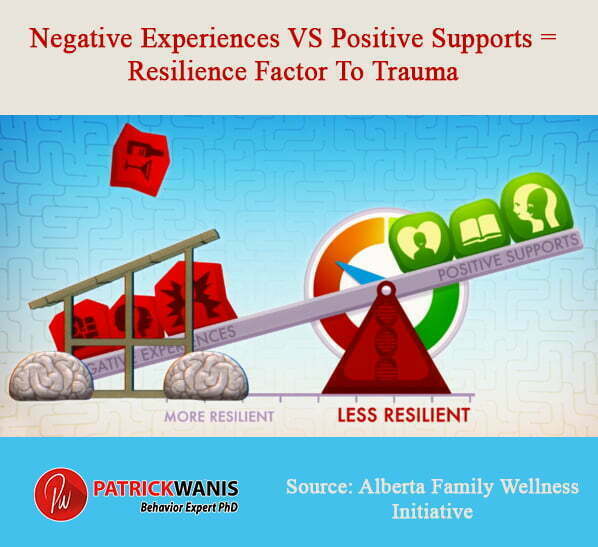
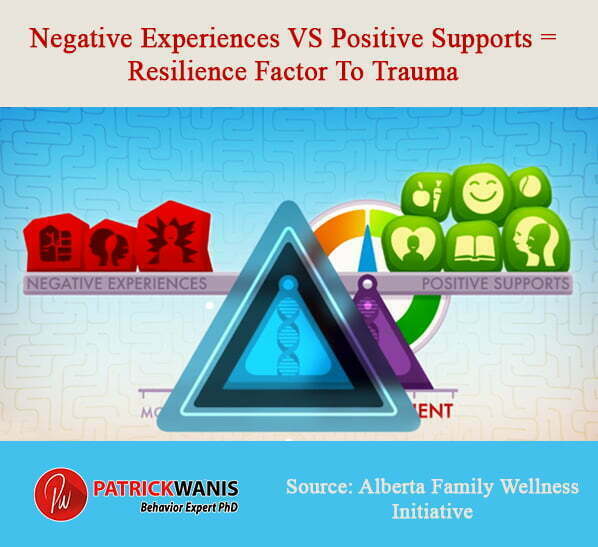
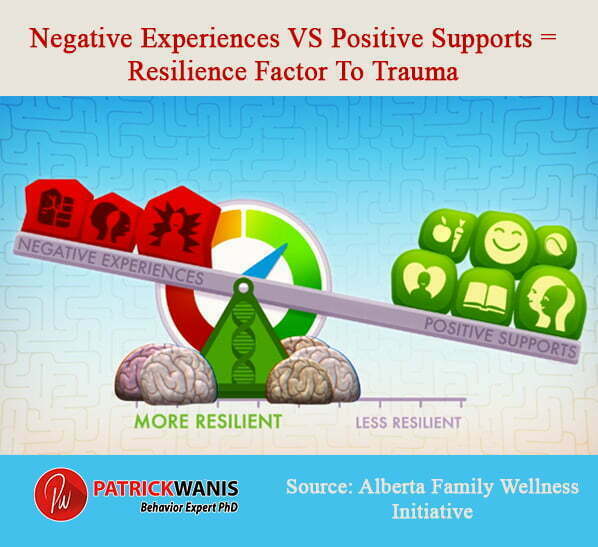
I don’t know if I personally would say that you outgrow a trauma, because I would need to know what was this horrific trauma you experienced? Then I would need to ask you questions to see – did you form some subconscious beliefs as a result of that trauma? Some that perhaps you are not consciously aware of, but they play out in your life and in your relationships?
Again, it’s all about, when you experience trauma, there’s extreme stress – sometimes it can be toxic stress. Once the stressful event has ended, it takes about 20 minutes for your body to come back to what we call baseline or homeostasis. If you have chronic trauma, you have chronic stress, you can never go back to baseline. If you have someone that’s comforting you, then you’re able to go back to baseline and you experience less trauma. Toxic stress is the result of the repeated, prolonged activation of the body’s stress response system. The chemical changes that occur in the body can weaken the body and the brain. When it occurs in children, the developing brain is affected in ways that can impact learning, behavior, and physical and mental health long-term. Toxic stress in children can be caused by extreme poverty, neglect, abuse, or severe maternal depression. (Harvard University Center on the Developing Child).
Unless you have another question, I wanted to talk about the window of tolerance. Do you have another question?
Re-Victimization: Trauma of Childhood Abuse and Experiencing More Abuse in Adult Relationships
Clifton: My question is how did my trauma attract me to my spouse who has more trauma?
Dr. Wanis: So, this is a bizarre thing. Again, this is from research. We found that people who were abused as a child were more likely to be abused again and again and again. Please pause and listen very carefully to what I’m about to say. This is not blaming you; this is not victim-blaming, I’m not saying it’s your fault. I’m saying understand that it’s actually normal that if you experienced abuse, you would find yourself in more relationships of abuse. I did the same thing and I noticed pattern after pattern, partner after partner, that she had no interest in my emotional needs, not that I even asked for them, but I went, “How did this happen? Oh, because of my own subconscious beliefs, because we create an identity, a subconscious identity for ourselves and a subconscious energy.
While one would expect that people who have been abused would be less trusting and more careful, the opposite is also true: people who have been abused often take more risks, tend to be less cautious, and sometimes act recklessly. They might also fail to identify or relate to a healthy relationship. Further, once they are in an abusive relationship, they believe subconsciously that it is abuse that they deserve – not love – and they have a Twisted definition of love. I will expand on that in a moment.
Meanwhile, the way that we even relate to the way that we handle stress will determine the kind of people we attract and the type of kind of people to whom we’re attracted to. For example, let’s say your attachment style, that means when you’re in a relationship, the way you respond reflects your attachment style [See Diagram on Attachment style on this page]; For example, if you have an anxious attachment style, then you will probably be very anxious, you’re very clingy and needy, and you’re constantly concerned about the relationship and “did you screw up?” There’s little chance that you’re going to end up with someone that’s of a secure attachment style, because you don’t realize the ways that you are drawn to those people or those people are being drawn to you. Again, this isn’t blaming you but it’s not on you.
I guess it’s also important to say, most of us, I think it’s about 4 out of 5 people, have experienced trauma. It doesn’t matter what your background is; it doesn’t matter whether you’re black, white, Australian or wherever you’re from. Everyone has experienced some form of trauma, or 4 out of 5 people have. The point here is that lots of people have experienced trauma but recognize what is the energy that you give off. What I mean by that – I don’t mean some airy fairy, color field around you – I’m not talking about that. But rather, when you show up, when you speak, when you stand, your tone of voice, the way that you respond to a text message or an email, the way you respond to someone who talks to you, what are you giving off? What are the subconscious messages that you’re giving off? Clifton, you said it before we started this program, do you want to mention it or not?
Clifton: As far as what part?
Dr. Wanis: Giving and getting.
Clifton: When I was talking about getting tired of giving? When was I talking about that?
Dr. Wanis: Yes, 2-3 hours ago.
Clifton: Yes. I was in a state where I felt like I was tired of doing therapy.
Dr. Wanis: That’s okay.
Clifton: Because I’m like nobody listens to me. But then, when I said that, I was like “well wait a minute!” Because I’ve learned to catch thoughts too, and I said, “nobody listens to you?” I said that sounds like it’s coming from somewhere else. Sure enough, I believe it went back to my challenge. Then we were talking about what we were talking about and I said “hey, I think I’m actually being triggered right now.”
Dr. Wanis: Yes, there was another point you made, with your permission if I may address. You also said to me, “I give, and I never get.”
Clifton: Yes, so that was the basis of the “no one listens”, but yes it was it, “I give, and I never get.”
Dr. Wanis: Let me jump in, this is especially important. This is a subconscious belief which is part of your identity. So, your identity is “I give but I never get”, and part of that belief is probably – “I give but I’m not going to expect to get.” And then as an adult, you start to feel really frustrated and angry because you’re not getting. Therefore, your subconscious identity is playing out.
Now let me say this, having known you for 4 years, I actually already know that about you; meaning there is something about you, you give very unselfishly in a way that I’ve very rarely experienced. You give from your heart, you really care, you really, sincerely love your patients, you want to help them.
Clifton: I agree.
Dr. Wanis: Well, just receive it because you’re getting it. Although that’s not the point yet but you’re a person that really does care and you don’t think about yourself, you think about how to help other people. You’re always coming from a spiritual perspective which is an open heart, that’s the spiritual perspective – connecting and giving from the heart. But I have always sensed that you don’t expect anything in return. So, I, Patrick Wanis, have to catch myself out and say, wait a minute, you better give something back to this guy because he’s just going to keep giving and he’s never going to ask for anything.
Hold on, this is important. I read that about you, so that’s something that you’ve been giving off without even knowing it. But because I’m vigilant and I go “Patrick, you better give back to this guy because otherwise, he’s just going to give, give, give”, which isn’t symbiotic – 2 organisms, 2 people, mutually benefiting each other.
Clifton: I was just going to say it’s right in line with everything that you’re saying. I can absolutely look back and see how I’ve always attracted the people who were not available or couldn’t give me and then I’d be frustrated and fussing – why won’t you give? Because that subconscious energy attracted what I believed I deserved. So yes.
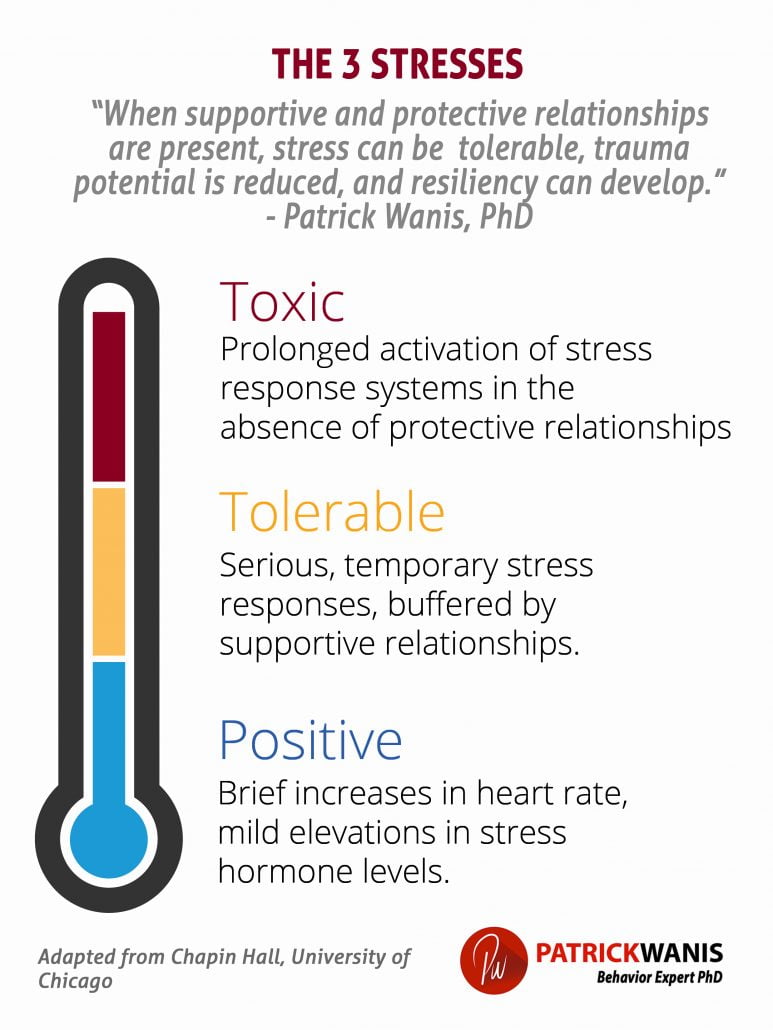
Trauma and Twisted Love
Dr. Wanis: Here’s the other important point to answer that person’s question about the kind of people we attract. We also respond to people that remind us of our primary caretakers. We become more responsive to them. I noticed this in my very early 20’s and I went, “what the heck is going on?” One minute, I’m attracting this tall slender girl who’s so bubbly and lively but quite cold and callous or distant or very self-absorbed, which incidentally was like my mother; and then the next minute, I’m attracted to a girl that’s truly short and clumpy and so warm and loving and affectionate like my grandmother – my paternal grandmother. I went, “okay, am I nuts?”
This was long before I studied any of this. Then I realized we respond to people, we become more responsive because that was our definition of love, and I’ve used the term “Twisted Love” – a “twisted definition of love”. The way that your parents give you attention will become your definition of love. If you get negative attention, you’ll have a negative concept of love, you’ll have a twisted definition of love. Again, there’s our self-image, our self-concept, our self-identity, that we put out.
Then we also respond to people that are similar and will complement or keep alive our subconscious beliefs. So, if I believe, if I sincerely subconsciously believe that I deserve to be treated well, I’m not going to respond to anyone that doesn’t treat me well. I might not even notice them or go, “huh okay.” So, I used to respond to those people that didn’t treat me well. Lo and behold, I did the work that I needed to do. Now, I’m not triggered by the people that don’t treat me well and I’m definitely not attracted to them. You’ve got to change your subconscious beliefs.
“In a prospective study by Widom and colleagues (2008), all types of childhood victimisation (physical abuse, sexual abuse and neglect) measured were associated with increased risk of lifetime re-victimisation. Findings indicated that childhood victimisation increased the risk for physical and sexual assault/abuse, kidnapping/stalking, and having a family friend murdered or commit suicide (Widom et al., 2008) Women who experience childhood violence or who have witnessed parental violence could be at risk of being victimised as adults as they are more likely to have low self-esteem and they may have learnt that violent behaviour is a normal response to dealing with conflict (Mouzos & Makkai, 2004).” https://aifs.gov.au/cfca/publications/effects-child-abuse-and-neglect-adult-survivors
Before I talk more about the healing because I know we’re a little over, do you have any more questions because I really want to answer people’s questions, because this is the way that I think the great information comes out.
Trauma, Self-Compassion and Self-Acceptance
Clifton: Are there ways you can avoid or minimize how your trauma affects your relationship?
Dr. Wanis: Yes, and this might need to be the next, part 2, but I’ll probably write a newsletter about it. It’s about resiliency. You’ve got to do 2 things, and this is a great point. Number 1 – you’ve got to work on healing the actual trauma.
Healing the trauma with my process – Subconscious Rapid Transformation Technique – is about identifying and validating all of the emotions that you experienced at that time, then going through the process to release all of those emotions, then identifying the beliefs that you attached and associated to that trauma or that event, and then changing them.
Then recognizing that you’re safe and secure, and then working on your conscious daily behaviors. So that means resiliency. Resiliency is your ability to bounce back from setbacks, disappointments, failures, trauma or whatever.
If you see someone who you perceive to be more resilient, that’s probably because they grew up with a greater social support network, and therefore they also had a greater belief in themselves. So, resiliency is the key to helping you to consciously deal with trauma, and we can talk about this in a future seminar, a future webinar, or I’ll write an article, or both. Because there’s quite a few steps to resiliency, but at least understand what resiliency is. It’s your ability to bounce back and to bounce back with new wisdom and new understanding, so you feel even stronger. Another question?
Clifton: Yes. Can you talk a bit about cancer or Covid; cancer caregiver PTSD especially after the patient passes away.
Dr. Wanis: If I understand this question correctly, this is a person who’s taking care of someone who had cancer and died, and now, if it’s not trauma, there’s a deep sense of loss. It could be traumatic because it depends on what your relationship was, how long you were, what part of your identity that was – if you were a parent or if you were the husband or the partner or if you were the child taking care of your parent for 10, 15 or 20 years. Maybe you even feel guilty for having survived while they passed away. I would need to ask you more questions.
First recognize that it’s okay to feel whatever you feel, and any time in your life that there’s a loss of a loved one, even if you’re a doctor taking care of a patient; I had a psychiatrist call me and say, “Patrick, I’m struggling because one of my patients committed suicide.” So, I have to attend to him as well. And it’s not unusual. The point is you’re allowed to feel whatever you feel. When there’s death, there’s loss, there’s grief, there’s pain, there’s hurt. Accept that it’s okay.
Now begin to be compassionate to yourself and I don’t mean in the New Age, airy fairy way. There are practical things you can do, starting off with writing out what you’re actually feeling and don’t judge yourself for those feelings. Even if you’re feeling guilty that you survived, and the other person died. Just say it’s okay that I’m feeling this, it’s human to feel this wide spectrum of emotions from pain to ecstasy. Then from there, ask yourself – if I were taking care of my friend who just had this experience, what would I do for them? How would I listen to them? And since you’ve been the caregiver for someone else, are you able to receive?
Most nurses, most caregivers struggle with receiving. I did a workshop for Shell Health and I focused on that because a lot of the people in the workshop were actually nurses and I didn’t even know what departments they were in. A lot of them were doctors and PhDs and engineers, and I remember saying to them once, just as we went around the room, it was at the beginning of the day. I’d like to believe that I’m relatively good at reading people just by looking at them, and I said to this lady, “You give a lot, you’re great at giving but you’re no good at receiving.” She started crying immediately, ‘How could you know this?’ I said, “It’s what I read from you.”
So, if you’re a caregiver or nurse, you’re constantly accustomed, you’ve programmed yourself to take care of everyone else. Allow someone to take care of you. If you want someone to take care of you, you’ve got to ask for help, you’ve got to be willing to ask for help. That’s vulnerability, but you can’t make real connection unless you’re willing to be vulnerable.
Clifton: You know, I like what you told me. You told me this long ago, you said if you really believe that it’s more blessed to give than receive, then allow someone else to be blessed and give to you because you’re always giving out, allow someone else to be blessed and give to you. I was like oh, that’s a good point and it really helped me.
Dr. Wanis: This is the bizarre thing, when you call someone up and you say listen, I’m having a hard time, would you just listen? I need someone to listen. Not only are you building a deeper more authentic connection with this person, but you’re making the other person feel significant. Because now, they know they’re needed. Now, they know they can help you and that’s the blessing that they get because they’re giving to you. You’re giving them the blessing of giving to you. Any other questions?
Clifton: Oh wow.
Dr. Wanis: You’ve got lots of questions?
Clifton: Yes, several questions. Let’s see where was our last.
Dr. Wanis: Let’s go through them because I think that’s really important.
Clifton: If you have a parent who dotes on you, can it give you unrealistic needs in your adult life?
Dr. Wanis: Well yes. I would need to ask you the question – how do you respond to that doting. Perhaps, you feel that you’re not capable. As a result of your parent doting on you, you would obviously say things like, “oh I feel strangled” or “I feel suffocated, I can’t breathe.” But what other impact does it have on you? Does it mean that you don’t believe in your capabilities? Does it mean that you push people away? Does it mean that you don’t trust people because you think that they don’t think you’re capable? So, ask yourself how does that doting affect me?
If you want to get a little clearer, imagine that you’re next to you and let’s say that the person asking you the question is Mary; and you say how does Mary respond to being doted on by her mother? You might say well, it drives her nuts. Okay, so she gets frustrated by it. How does it affect her, what does she believe about herself? Well, she thinks that her mother thinks she’s stupid and incapable, or she thinks that her mother doesn’t see her as a whole person, doesn’t see her as an actualizing adult etc. Dig a little deeper to ask yourself how does it really affect you? Next question.
Trauma Therapy And Forgiveness
“No one who’s experienced significant adversity (or many ACEs) is irreparably damaged, though we need to acknowledge trauma’s effects on their lives.” – Center on the Developing Child, Harvard University
Clifton: Are you able to have forgiving and healthy relationship in the long term with someone who abused you? That’s a good question.
Dr. Wanis: Yes. It may not be easy, but you can get there. I was trying to work out whether to use the word easy or simple. I will speak from my experience. Now I’ve done this in SRTT with so many clients who were abused – by dad, by mum. Different forms of abuse; some psychological, some emotional, some verbal, some physical. They were still able to heal the relationship from forgiveness. I don’t believe that you can just do it by saying “I forgive you.” Because I’ve had clients who came to me saying, “I thought I forgave them, and I realized I didn’t.”
Forgiveness occurs when you understand that the person that hurt you, was already hurting themselves. Forgiveness occurs when you understand that the person that created pain in you, was in pain themselves. Forgiveness occurs when you truly understand that that person didn’t set out to hurt you, they were already in pain. Forgiveness for me occurred when I recognized that my mother wasn’t able to love. It’s not that she didn’t love me, it’s not that she didn’t want to love me, she wasn’t actually able to love. And that’s it, that’s just the way it works. But it’s not something that happens consciously.
In the process that I do, we’re accessing the subconscious mind so you feel it, you really can connect with that. Even though you don’t want to connect with the abuser, you connect, and you see who that person is.
The same thing happened with my father. My father was very abusive. Now the blessing, not for me, but for other members of my family, was that by the time my father became older, he softened. As he softened, he became more of his authentic self, he lived more from his heart, but he also suffered the trauma, he suffered the results and the consequences of his childhood trauma, of his beatings, of the fact that he didn’t get physical love and affection from his mother, from the fact that he didn’t get his emotional needs met from his mother, from the fact that he married someone just like his mother who couldn’t love him and didn’t love him. So then, he ended up with heart attacks and stroke. But the point is in those last years of his life, he was able to express love to other people in my family such as my niece or my nieces.
I remember thinking, this is a real blessing, because this man beat the hell out of me, I couldn’t walk sometimes, I couldn’t sit down, I couldn’t raise my hands from the beatings that my father gave me. But here he is, expressing love to my niece. I was grateful for that. Then she experienced trauma when he passed because he was one of her social supports.
The point is that I was able to forgive him when I connected to the pain that he experienced, when I imagined him as a child not getting the love that he wanted, when I imagined him as a child getting beaten by his father. When I imagined him as a child and his – in America, they call it diapers; in Australia, we call it nappies – were not changed by his mother because she had servants. She didn’t want to touch his bottom, she paid other people to do that. But the child needs the physical love and touch of the mother. So, if the mother is like my grandmother was and she says, “I don’t do that”, and she pays a servant, the child suffers. If the mother is in depression or is suffering from substance-abuse and is doing cocaine or something else and doesn’t give that physical love and affection and connection to the child, the child suffers trauma.
So yes, you can forgive, and this will probably be the most important thing I’m going to say to you tonight. Focus on forgiving because that is a key part of setting you free from the trauma, and it will release a lot of the poison and the pain that’s in your heart. Next question.
Clifton: That’s good. Sometimes I tell my clients the thing that you just described; there’s actually a movie called “The Shack.”
Dr. Wanis: Oh, I heard about this. Go on.
Clifton: This guy who was beaten by his alcoholic father, then his daughter is murdered, and he has a situation where God, Holy Spirit and Jesus, and they’re trying to make him forgive. Then the picture of his dad shows up as a kid, and I’m like man, this is SRTT. It’s a really powerful movie.
Dr. Wanis: That’s great.
Clifton: Okay, next question. How do you identify your trauma if you have learned to push off or minimize situations? I believe they’re saying like, “okay I may have trauma, but I don’t know what it is because I’m used to pushing stuff away.”
Dr. Wanis: Well, two things. I think we need to share this, either we go over it again or I go back to the beginning. I identified at least 12 different forms of childhood trauma. Were you physically abused? Did your parents shout at you, insult you or humiliate you? Did your parents neglect you emotionally? Did someone or anyone – when you were a child – did someone sexually abuse you? Did one of your parents have mental illness or dad not being there? Was someone suicidal? Was someone incarcerated? Look at all of those things. If you’re talking about pushing it away, the only reason you’ve pushed it away is because it was too painful to watch, it was too painful to visit. But you can visit it if you have the right person and the right technique helping you because then you’re able to visit it without reliving any pain.
I’ll say it again, you can’t heal trauma when you are reliving the pain or reliving the trauma. The work that I do is so that you are out of the trauma but you’re looking at it and you’re able to have compassion for that child that experienced the trauma.
Clifton: I think I know this person and they’re saying they push everything away, like they minimize situations so when something bad happens to them, it’s like “oh, it’s not that bad.”
Dr. Wanis: Okay, so that simply means that most likely the parents did the same thing, that the parents never acknowledged what you were feeling, no one ever said to you what do you feel, what do you want, what do you need? No one connected to your thoughts, emotions, or desires. Perhaps, no one ever said to you “Who are you, what excites you?” or “I see you playing with this toy, is this something you really like? Is this what you want to do later in school? What’s your passion?”
So, if they didn’t connect to you and they didn’t ask you what you want, then you probably felt unimportant. Therefore, you thought whatever I feel, whatever I experience isn’t important and you push it all away. Perhaps, it might have also been a case of a household where it’s better left unsaid. Or perhaps, dad was stoic in the sense that dad showed no emotion, or parents said, “It doesn’t matter, why are you feeling afraid? Stop that. Why are you angry? Stop that.” So, they teach you to shut down your emotions, and what you feel is insignificant. So again, look at the way you were raised.
Clifton: This is a good one. If you experience severe childhood trauma, but now as an adult, you feel nothing when you think about it, does that mean you have moved on from that trauma?
Dr. Wanis: I wish that were true. What did you want to say?
Clifton: My answer is short and it’s just no, because that was me until I did work and I was like oh, I know all that was in there but…
Dr. Wanis: Well, I was going to say look at it this way, what’s the effect in your life, how are your relationships, how do you feel day-to-day? If you say it doesn’t affect you or that you don’t feel any pain if you think about it, you’ve probably shut it down. There are people who say I don’t have many memories as a childhood. Like I did. I mean, I would say I got hit as a child, I didn’t think it meant anything to me. But whoa! And having little memories of childhood, is often a symptom/sign of having experience childhood trauma. [See Diagram 26 Symptoms of Trauma on this page.]
Let me tell you one experience when there was someone, when I finally said oh, I think that I need some help here because I’m a bit of a mess, and this person/therapist started taking me back in time and that was an awful mistake, because this person is a beautiful person but didn’t have the technique or the tools to know what to do with me. When I went back to that, I went into the most bizarre state. You’re not going to believe this; imagine an adult who on the sofa goes into a foetal position. This person left me there because I had to, that actually was a home visit. I lay in that foetal position for 3 hours and then I lay in bed for a couple of days, because the person didn’t have a process or a technique. They took me back, not expecting me, they knew what I’d experienced, I told them. But I went back to that and boom!
So, if you’re saying, “well I think about that trauma, but I don’t feel anything”, what about your physical body, what manifestations, what’s your sleep like, what’s your digestion like? Do you have any other physical symptoms? How do you relate to people? How do you feel about yourself? Do you have any heart problems, any liver problems, any digestive problems, any immune problems, are you overweight, are you motivated, do you feel alive, do you feel happy? Look at your entire person because you are a whole person. You might also be experiencing PTSD and be unaware of it. [See diagram “Do You Have PTSD?” on this page]
Life is lived in 4 realms – mental, emotional, physical, and spiritual.
Mental is your thought, your cognitive abilities, emotions are the things you feel and the way you relate to people. Physical is your body and everything that is tangible. Spiritual is your connection to either a higher power or at least to other human beings in the sense of – are you coming from the heart, are you living from the heart, are you contributing and making a positive difference? Here is a good one, there’s a reason you came to listen to this webinar because at a subconscious level, you know that that needs healing.
Trauma and Inability To Trust Other People
Clifton: You know another one, I meet people a lot of times who do not trust but because they are married to an imperfect human who has done something to break their trust, they think it’s because of them. But then as we do work, no, you actually brought that distrust with you. They may have made it worse, but a lot of times, I think because of who we have in our lives, it prevents us from looking at ourselves, because we will say, “no, I’m this way because you are treating me such and such”, and that’s just not true. But it makes it difficult to see you.
Dr. Wanis: So that is another good point because that’s another one of the consequences of trauma where it’s extremely easy for a person that’s experienced trauma not to trust. I was like that most of my life. I just did not trust anyone because I never trusted anyone growing up. The only person I really trusted; I had a good relationship with 2 of my grandmothers. One of them died on me. Now notice the expression – “died on me”, right? That is the child speaking – “my grandmother died on me.” She did not deliberately die, she was old, she was sick.
The other grandmother, I had a good relationship up until she did something which I won’t talk about on this video. So therefore, I didn’t trust anyone. And from the time that my maternal grandmother died, my mother and father turned to me to be the rock for them. My mother actually said those words to me, “don’t cry, you’re my tower of strength”, so it flipped. I never learned to trust people; it was extremely hard for me to ask for support.
The point again being trauma will also create a sense of either hypervigilance or ‘I don’t trust anyone, I don’t feel safe trusting anyone, I have an inability to trust or resistance to trust.’ That’s because the people that were supposed to take care of you and protect you and love you and nurture you and provide for you and give you a sense of safety, security, and stability, betrayed your trust and made you feel unsecure.
Particularly for a child, if that’s the father – because the father’s role, the father’s primary role is to protect. Think of the psyche, the way the child looks up to the man who has a deep voice. To the child, the depth of that voice represents safety and security, as well as the size and the way that the man moves through the space, and now, he’s abusing the child either physically or sexually. So, the person that’s supposed to be protecting the child has removed the protection. Next question.
Clifton: For example, an extremely secure, reliable, loving and overly attentive and supportive guardian who always made you feel special and important… Oh I guess that was for the doting one. But here’s the second part I guess, can someone have a parent like this but still be suffering from trauma they experienced earlier in life.
Dr. Wanis: I So, understand the question correctly, you have a parent that was a really great parent and took care of you, took care of your emotional needs, but there’s some other trauma you experienced. So, what was that trauma? Was it someone else outside the family or a relative or a stepdad who sexually abused you? You still have to deal with that trauma.
Let me tell you the good news and the bad news. The good news is it can be healed. The bad news is that there’ll also be anger towards the mother. Meaning, if you’re a child, if you’re a daughter, if you’re a girl, and as a child, you were sexually abused by either your father, stepfather or a relative or a neighbor, there’s a 99% chance you’re also going to be angry at your mother for failing to protect you.
Trauma, Shame and Guilt
Clifton: Okay, I have more details. He added something else before, I didn’t read this. I had a very loving relationship with a stepparent, and I think it has made it difficult to recognize past trauma. I felt a shame for having emotional problems because I had such support and love from age 7 onwards.
Dr. Wanis: This is so important and I’m glad you brought this up. Thank you very much sincerely because it was something I was planning to talk about. I was having a discussion with a friend who experienced trauma as a child. Now, this particular person travels the world and is often in war-torn areas. So, she says to me, “Patrick, how can I look at my trauma when I go over there, and I see their trauma is so much more extreme than anything I experienced.” And I say it’s amazingly simple, you’re now looking at the trauma from an adult perspective and you’re trying to compare and say look, the trauma that I experienced as a child is a 5 out of 10, but over here it’s a 10 out of 10 because it’s a war-torn area. But that’s not what the child thought.
When you’re a child, you register the trauma. When you’re a child and you’re experiencing the trauma, you’re not saying to yourself “oh, someone on the other side of the world is having a worse experience than me.” No, your brain is triggered, you’ve gone into the fight-or-flight response and you are responding to the pain right now.
So be careful of comparing yourself to anyone else and therefore saying, “Look, I feel guilty thinking about my first 7 years that were painful because I had a loving father or stepfather from age 7.” No! You still had pain in the first 7 years and that needs to be addressed. Please recognize 2 things, it’s okay to have pain, it’s okay to feel the pain, as long as you have a process to heal you.
The second thing is what I said at the beginning, the first most important years that will determine the rest of your life are the first 2 years, then the first 6 years, and the first 8-10 years, then the first 18 years. So those first 2 years when you’re an infant, you are developing your sense of safety, security with the world, your connection to a caretaker. And right in that moment, you’re going to make a decision as a child, as an infant, about whether your emotional needs can be met.
If you’re saying to me Patrick, how’s this possible with an infant, I will direct you to studies that were done. You can look up John Bolwby’s work or you can look up “The Strange Situation” by Mary Ainsworth. (John Bowlby was a British psychologist and psychoanalyst who studied and revealed that early childhood attachments play a critical role in later development and mental functioning. Later, psychologist Mary Ainsworth, did further studies and research and their work laid the foundation for the development of attachment theory.) Watch those videos and you will learn how the first 2 years changed your life. So yes, if you’ve had trauma, even if you had someone else that was loving and kind and caring, still, please go back and deal with that trauma, heal it.
Clifton: Good stuff. If someone feels like they’ve already forgiven those who have caused them trauma, what explains angry outbursts?
Dr. Wanis: A couple of things. Potentially, you might have forgiven them, or you may not have. First thing is you’re not really sure. Let’s say in your heart, you feel you’ve forgiven them. Maybe you have forgiven that person but let’s find out where is the anger coming from? Is it from some neurological impact?
As I said in the beginning of this program, chronic stress and toxic stress changes the amygdala. It can enlarge the amygdala, and the amygdala is what makes you hypervigilant. Therefore, you’ll see danger when there isn’t any danger, and you’ll experience fear when fear isn’t required, and you’ll be aggressive when aggression isn’t required. So that’s another possibility.
Trauma, Self-Blame, and Anger At Self
Number 3 – you might be angry at someone else. Maybe you’ve forgiven, and I’ll use the example of a girl. A little girl who gets sexually abused by a stepdad or dad will actually be angrier at her mother than the person that abused her. So, you might have forgiven the abuser, but have you forgiven other people associated with that, and have you actually forgiven yourself?
What do I mean by that? It is the most common occurrence that every person who experiences trauma will subconsciously blame themselves. Doesn’t matter whether you are 4, 6, 10, 26, 36 or 46. Whenever something is done to you, you will ask the question why me and you’ll start to think it was because of you. Then if you’re a girl, you’ll say, “did I do something, did I send those signals, what was it about me that made him choose me to molest me, abuse me, rape me?” And you’ll blame yourself.
So, you might not even be angry yourself, you might just be angry at the fact that it happened. So, there’s all these beliefs because there’s also beliefs when I work with clients. Again, in the SRTT process, we uncover the client with the subconscious belief saying it wasn’t fair. So, there’s anger there, and I say you’re right, it wasn’t fair because you didn’t do anything wrong, it wasn’t your fault, you’re not to blame, it wasn’t fair. But sometimes in life, that’s it. Now, what do you want to do about it?
If you are able to sit down with a child who’s just experienced this right now, it’s just finished, and you’re calming and you’re comforting the child and 20 minutes has passed and the child’s going back to baseline, all the stress response has dropped, and you say to the child “I know you’re hurt” and you listen to what they’re feeling and you help them to verbalize what they’re feeling. Even if they don’t know how to put words to it, but you help them and you offer them words. Then you recognize that they believe it’s unfair and you say that’s right, you’re right, it’s unfair. I promise you, 90% of that pain will dissipate because you’ve acknowledged them, and you understand them.
You don’t have to convince them that they’re wrong, and say well, life is fair, or life isn’t fair. You just acknowledge that that’s what they’re thinking and feeling. Then perhaps, you guide them a little and you show them an insight and say, “sometimes in life, unfair things happen, and we don’t have control over that, but there are things we do have control. We have control over the way we’re going to respond.” Next question.
Traumatic Loss and Common Symptoms
Clifton: This one is more of a comment, it says, I noticed a major shift in my daughter when her grandmother – her favorite person – passed when she was 9. She’s 17 now and doesn’t feel connected with anyone.
Dr. Wanis: Okay, this sounds a little bit like my story that happened at age 10. So, I don’t know if this person has heard my story but let me say it makes complete sense for 2 reasons. For one, children tend to have a better relationship with grandparents than parents, because by the time that person has become older, they’ve softened, and they have different expectations of the child.
When you’re a parent, you have one expectation of the child, starts with the letter “O”, it’s called obedience. You just want your child to be obedient and not drive you nuts. Then you have all the other expectations. But the grandparent comes along, and the grandparent celebrates the child and makes them feel – if the grandparent is healthy – and makes the grandchild feel loved and wanted and needed and special and magical and worthy. The grandparent often puts in that child – notice I say he puts in that child – the belief that you can do anything. Then the grandparent is gone. The child loses all of those things that the child had.
So, in the work that I do, I have to help the client and I do help the client, to say if your grandparent, your grandmother believed in you, what’s changed? She may have gone in physical body but her belief in you didn’t change, she loved you for a reason, that hasn’t changed. Fulfil her wishes. Her wishes were for you to live life to its fullest. Her wishes, your grandfather’s wishes, were to enjoy life and to live life to the fullest. Your grandmother or grandparents saw all this beauty in you, why do you want to bring out the ugliness? Why do you want to suppress the beauty? Bring out the beauty, prove to them that they were true, don’t prove to them that they were wrong. Prove to them that they were right.
So yes, please talk to your 17-year-old daughter because she needs it, because if that was her only connection, she’s going to suffer a lot in relationships because she probably doesn’t know how to connect, probably doesn’t trust anyone and is afraid that people will leave her. I know because I experienced it.
Intrusive memories about the death: Commonly expressed through nightmares, guilt, or self-blame about how the person died or recurrent or intrusive thoughts about the horrifying manner of death.
Avoidance and numbing: Common characteristics of the individual may include withdrawal, the individual acting as if not upset, or avoiding reminders of the person, the way she or he died, or the event that led to the death.
Physical or emotional symptoms of increased arousal: Individuals may display irritability, anger, trouble sleeping, decreased concentration, drop in grades, stomach aches, headaches, increased vigilance, and/or fears about safety for oneself or others.
Source: https://teachtrauma.com/information-about-trauma/types-of-trauma/traumatic-loss/
Clifton: Last 2. I was abused by a man and his sons, but I was incredibly young and had extremely limited memories that I chalk up to dumb activities, but I don’t believe it affected me. My brother and sister violated me, but I also chalked that up to dumb childhood stuff. My mother has 8 children, and I don’t fault her because she was supporting us as a single parent. My spouse feels that I have baggage, but we have moved on, but I also feel I haven’t.
Dr. Wanis: Well, the first question would be why does your spouse think that? What is it about your relationship that your spouse identifies there’s some connection to what you’ve experienced? Is it in the way that you two are physically and sexually intimate? Is it the sense of trust that maybe he doesn’t get from you? Maybe he senses that you don’t trust that you don’t fully open up? Is there some other sort of sexual block? Because for women, 80% of orgasm is the sense of safety. A woman’s orgasm is connected directly to a sense of “do I feel safe, can I trust, can I let go?”
So, what is it that your husband is seeing in you that says, “you have baggage honey, you need to deal with this?” Then when you tell me a story such as I got violated by – I don’t know if he was father or stepfather and siblings and other people – there’s no way that you weren’t affected by these because you’re a human being. Even if you’re looking at it as an adult and saying it’s a long time ago, it’s in the past, I don’t feel anything, you do at a deeper level because that little girl was hurt and violated.
The same thing that I said to Clifton when he and I were talking about this, I’ll say to you. If you’re a mother and that were happening to your child, how would you think, how would you feel, how would you react? Would you just say to her, don’t worry about it, they’re just dumb activities? Would you say don’t worry, you have 7 siblings, forget about it? No, you wouldn’t. You would recognize the pain and the impact.
Again, if you’re still unsure, read my article that I wrote about trauma and its lifelong consequences and impact on health outcomes, and I promise you, you will have some of these symptoms. https://www.patrickwanis.com/traumas-lifelong-impact-on-health-and-how-to-heal-trauma/
Clifton: Okay, good stuff. That’s good. So, this last question, I didn’t know if we would be able to even get to this in this particular session, but I think this question leads right into some answers. Did I miss the question? I did because I didn’t see that one. I’m sorry Lucy, I didn’t see your question but because of time, I will read this other one, I really apologize; because I’ve answered a couple yours anyway, don’t fault me. If you really need it, I’ll email you, I’ll have Patrick email you the answer. So, let’s see, this was the last one I was thinking of. This is Lucy’s, “how do you live with someone who is verbally abusive and will probably never change due to suspected mental illness that he or she will not address?”
Dr. Wanis: It’s obviously a very tough choice and you’ve got to ask yourself, how many years do I have left, how do I want to live them? I know that sounds very cold and very black and white. Sometimes, we must make really tough choices in life. Sometimes, there isn’t a good and a bad, there’s just, “which is the less painful choice?” So, if you are with someone who has a mental illness and they’re not willing to get any help, or you’re with someone who you know is abusive and you’re convinced, for whatever the reasons are, that they’re not going to change, then you ask yourself – how do I want to live the rest of my life? Then you ask yourself, “if that were my daughter, what would I tell her?” Would I tell her to stay? Would I tell her, “you’ve got to love yourself; you’ve got to respect yourself?”
Because a lot of people make this mistake Clifton, they stay in relationships that are unhealthy and all it does is it harms both people. It’s not helping the abuser that you’re with him if he’s just being abusive. It’s not like you’re healing him, it’s not like you’re making him feel any better. Because trust me when I tell you, he doesn’t feel any better from the abuse that he lays out on you. So, you’re not helping anyone. Last question?
Trauma: What Are Your Core Emotional Wounds?
Trauma impacts the psyche; it impacts your physical health via toxic stress and the nervous system and, it impacts your mental and emotional states and relationships via the subconscious interpretations you made as a child about yourself and the world around you. Is it a safe, loving world, or a harsh, cruel, and dangerous world? Are you safe and lovable or are you threatened and unworthy?
Based on decades of work with clients, I believe that everyone shares the same core belief or wound: I am an unworthy and unlovable.
This might be expressed in various ways: ‘I am not good enough…I am an outsider…I don’t belong…I will never be enough…I need to be perfect to be loved…I can’t trust anyone…I am inadequate…I am ugly…I am worthless…I am bad…I am broken…I don’t deserve love or good…my love is worthless…I have nothing to offer…etc.’
The most common emotional wounds are rejection, abandonment, humiliation, shame, betrayal, and isolation or disconnection. Each one of us interprets trauma and childhood events and experiences differently based on various factors and therefore there can be multiple and overlapping emotional wounds.
Here are 14 core emotional wounds – my summary based on the work of Jay Earley, PhD.:
⦁ Dominated – Controlling, strict or domineering parents
⦁ Exploited – Used to meet parent’s needs, play adult or caretaker
⦁ Not Seen, Heard or Understood – Ignored, invisible, not appreciated or encouraged or validated for who you truly are
⦁ Guilted or Shamed – Harsh morality and judgment, constantly told you were wrong or bad
⦁ Attacked – witnessed or experienced physical violence and rage
⦁ Abandoned – Not cared for, often alone or forgotten
⦁ Neglected – Needs not met, little or no affection, touch, nurturing
⦁ Rejected/Disconnected – Not connected with parent or peers, bullied, pushed away, ignored, felt different or like an outsider
⦁ Unloved – Felt unloved, rejected, abandoned, isolated, neglected, invisible, unworthy, favoritism towards sibling
⦁ Violated – Smothered, emotional incest, abused sexually or other, boundaries violated, extreme physical/sexual attention and affection
⦁ Rejected/Alienated – You believed you are innately bad, broken or flawed, should not exist, and there is something wrong with you; worthlessness, deep shame
⦁ Judged – Criticized, compared, invalidated, told you were inadequate, stupid, ugly, worthless, unlovable
⦁ Ridiculed/Shamed – Publicly ridiculed, laughed at, or embarrassed
⦁ Betrayed – Unreliable/unpredictable parent, extreme moods, lies, broken promises, disloyalty, betrayal of intimate information/secrets
In my trauma work with SRTT (Subconscious Rapid Transformation Technique), I help you to quickly resolve each of these and other emotional wounds by validating the emotions you experienced, uncovering, and transforming the subconscious beliefs you formed with the mind of a child, changing your mental and emotional association with the memory/event, and forgiving and expressing compassion to yourself and others. Yes, children subconsciously blame themselves for the things that happened to them (including sexual abuse) – even if that self-blame and self-loathing is hidden by conscious anger and external blame.
Trauma Healing – Choosing The Right Therapist and Technique/Process
Most human suffering is related to love and loss and…the job of therapists is to help people “acknowledge, experience, and bear” the reality of life — with all its pleasures and heartbreak.” — Elvin Semrad
Clifton: Yes. In our last 5 minutes, another question, “Now that you know you’ve experienced one or more traumatic experiences and are suffering from them, how to choose the right professional with the right tools to help you deal with the trauma and its effects on you?”
Dr. Wanis: Well, you come to me. So here are the 2 most important things. Number 1 – Can you trust this person? Just follow your gut. Put your hand on your heart and ask yourself – can I trust this person? Be careful that you’re not just coming from a former place of fear. But I remember saying it once to a client. So, my client put me on the phone with a potential new client and I normally never ever do that. But she begged me, she said, “Patrick please, please talk to so-and-so for 5 minutes.” Okay, I’ll do it. I talked to her for 5 or 10 minutes and I said do not make the decision now, make the decision tomorrow morning. Just put your hand on your heart, ask yourself can I trust this person? If the answer comes yes, come to me. If you don’t, don’t come to me or come back to me another time.
The second thing is do they have a process and is this process going to be 3 years and painful, or is it going to be short with rapid results and little to no pain at all? The healing and recovery process for trauma that I’ve developed over 15-20 years, I call Subconscious Rapid Transformation Technique. It’s a process that is so effective for trauma, you don’t relive the trauma, you don’t relive the pain, I guide you through it. I’ll use the example of a 19-year-old client who just texted me today. In fact, I texted him to say hey, how are you doing? He said to me “I’ve just started yoga and almost all of my anxiety has disappeared, we’ve done three sessions.” When he first came to me, he was having panic attacks every day, serious panic attacks, anxiety, and panic attacks every day. Two weeks after the first session, I said to him, “how are you doing?” He said I’ve only had 2 panic attacks. Then we did another session the week after that, then I said, “how are you doing?” He said I’ve only had one panic attack and I was able to diminish it, I was able to control and let it go. So, the help is out there. We’re running out of time, so let’s wrap up.
Healing is about feeling safe and secure, it’s about releasing all of the painful emotions, it’s about changing the beliefs, it’s about being able to come back to your core self, so you feel safe to fully and freely express yourself. To be free of the pain and to heal even your brain to create new pathways in your brain so you have new behaviors and new outcomes. I promise you it’s all possible, it’s all doable. It can be done easily, gently, safely, and quite rapidly. Ask Clifton, he’s experienced it and he’s referred many clients to me, and I have about 4 therapists who refer trauma clients to me and I have about 5 or 6 therapists who’ve come to me so that I could help them.
Trauma Healing with SRTT Process – Subconscious Rapid Transformation Technique
⦁ We will identify your objective
⦁ No useless lecturing or counselling
⦁ We will uncover the root cause of your issue or behavior
⦁ You will identify the pain and emotional trauma without reliving the pain or trauma
⦁ You will create new subconscious beliefs and programs
⦁ Experience significant progress in less than 90 minutes
⦁ You will be empowered and set free from the past
⦁ Experience effective change through subconscious rapid transformation technique (SRTT)
⦁ You will receive ten times the value of your financial investment
⦁ You will receive effective help for issues that numerous therapists are unable to resolve
Above all, every SRTT session is highly fluid based on who you are and what you need in that moment to recover and heal from the trauma!
Read more about SRTT here: https://www.patrickwanis.com/phone-consultations-book-session/
Clifton: So, everyone, I hope you enjoyed that. I did have a slide that I added at the last minute with both of our contact information on but the way this is…
Dr. Wanis: You can pop it up and say goodbye.
Clifton: It was beforehand. It takes a long time to load so it didn’t load. I’ll send that out to you guys in the follow-up email. I’ll send Dr. Wanis’ website which is just www.patrickwanis.com and my website www.cliftonbrantley.com or my therapy website which is www.abetterfamilynow.com. If you want to get in touch with either one of us, if you want to do trauma work, I strongly suggest that you get in touch with Dr. Wanis. Even if you’re my client, you work with him so that the work we do will be a lot smoother. We can just focus on your relationship. That’s my professional and personal advice to you.
Dr. Wanis: Clifton, thank you very much. My battery’s running out, we’ve got to go. Thank you very much, you are always such a role model and you’re so exemplary. You live from your heart, you express from the heart, you show such genuine care and concern. The only reason you did this webinar is because you genuinely care about people, you want to help people. Anytime you send me clients, I’m always reminding them to come back and thank you for the genuine care and concern, because you have so much love and you express it from your heart and that makes you a great person whom I sincerely honor, admire and acknowledge. Thank you.
Clifton: I truly appreciate it, I truly, truly appreciate it.
Are you ready to gets results and live your best life now?
I am sincere, authentic, insightful, open, bold yet compassionate, someone who can help you to further succeed in your relationships in every area of your life and in record time.

